Paul van Yperen's Blog, page 133
February 18, 2022
Teen idols in the 1950s and early 1960s
A teenager, or teen, is someone who is between 13 and 19 years old. Their idols are often actors or musicians, and many are both. This is what Wikipedia writes. In the 1950s, the teen idol was a new phenomenon. Although he had only three major film roles, James Dean earned two Oscar nominations. He also had the image of a rebellious youth, something that was popular among teenagers. His performance in Rebel Without A Cause (1955) and his untimely death in a road collision in 1955 cemented his status as an idol. Elvis Presley also made his debut in the mid-1950s and became a sensation too. Deemed too dangerous to be filmed except from the waist up because of his sexually suggestive dance moves, he also became popular among teenagers. With the advent of television in the 1950s, other American teen idols like singers Pat Boone, Frankie Avalon, and Fabian, were promoted through American TV programs such as American Bandstand. In this post, EFSP gives an overview of the teen idols of the 1950s and early 1960s in four countries, the USA, Great Britain, France, and West Germany. In the following weeks, several posts will follow on these teen idols who were popular as film actors and as pop stars.
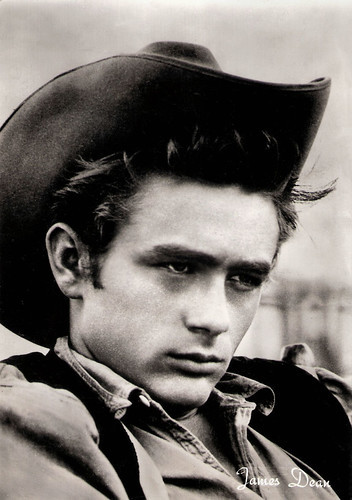 Italian postcard by Rotalfoto, Milano, no. 519. Photo: Richard Miller / Warner Bros.
James Dean
at the set of Giant (George Stevens, 1956).
Italian postcard by Rotalfoto, Milano, no. 519. Photo: Richard Miller / Warner Bros.
James Dean
at the set of Giant (George Stevens, 1956).
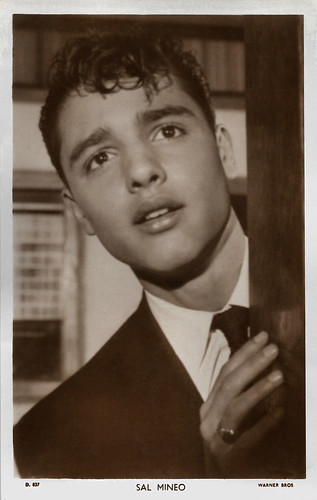
British postcard in the Picturegoer Series, London, no. D. 837. Photo: Warner Bros. Sal Mineo in Rebel Without a Cause (Nicholas Ray, 1955).
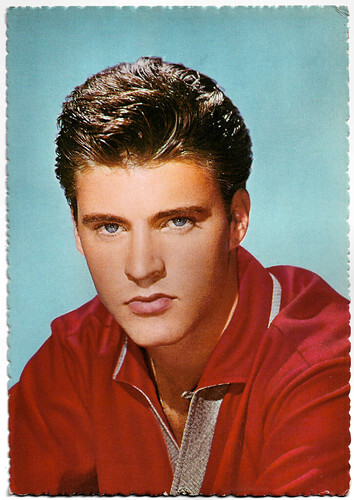
Belgian postcard by E.D.U.G., no. 172. Ricky Nelson.
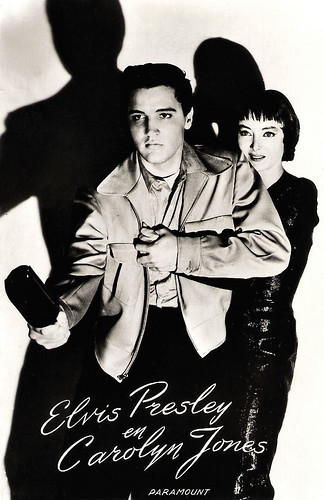
Dutch postcard by Uitg. Takken, Utrecht, no. AX 3978. Photo: Paramount. Elvis Presley and Carolyn Jones in King Creole (Michael Curtiz, 1958).
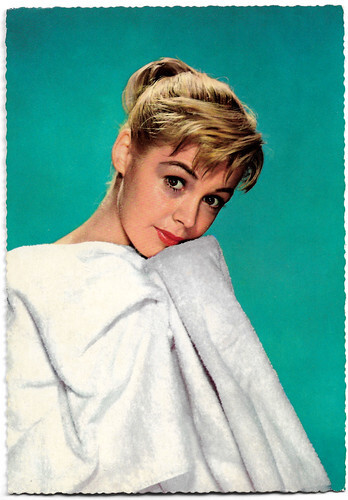
West-German postcard by Krüger, no. 902/9. Photo: Terb Agency. Sandra Dee in Gidget (Paul Wendkos, 1959).
Against the corrupting influence of Rock and Roll
Post-war teens were able to buy relatively inexpensive phonographs — including portable models that could be carried to friends' houses — and the new 45-rpm singles. Rock and Roll music of artists like Elvis Presley, Chuck Berry, Jerry Lee Lewis, Buddy Holly, and Fats Domino, played on 45s became the soundtrack to the 1950s as people bought what they heard on the radio. Rock and Roll had evolved from Rhythm and Blues, a sound developed by African-American musicians that by the early 1950s had slowly begun to reach a new audience in young white teenagers. By nature of its association with blackness, many white American adults feared that Rock and Roll was a corrupting influence on their children, promoting socialising between races, juvenile delinquency, even premarital sex.
Music was not the only thing that disturbed conservative grown-ups. In August 1957, pioneer Rock and Roll disc jockey Alan Freed’s WABC-TV teen dance show Big Beat was cancelled after African-American artist Frankie Lymon was seen dancing with a white girl on the program. Less than a year later, at the Boston date of his Big Beat Spring 1958 tour, Freed was charged with anarchy and inciting the youths in attendance to riot, though the charges were later dropped.
Parents worried about their kids' attraction to artists who were edgy and rebellious. So the industry took control and created new teen idols. New faces on magazines fed fans; fans buy records, see films, watch TV and buy fashions. In all of these media, the new formula consisted of selling products associated with photogenic, well-mannered young people to teenage consumers.
The ingredients of a teen idol recording included an attractive usually white, conservatively attired, and well-groomed young media star singing simple lyrics about typically middle-class teen concerns. Some marketers turned to film and TV for fresh, attractive, 'safe' faces. Ricky Nelson, a performer of rockabilly music, became a teen idol through his parents' television series, The Adventures of Ozzie and Harriet. With many parents disapproving of Elvis Presley, Nelson became a safe alternative. Another young TV star who was hustled into a studio to make recordings was ex-Mousketeer Annette Funicello who became one of the first big female idols.
Marketing of the teen idol generally focused on the image. The teen idol was structured to appeal to t young female pop audience members. They were commodified in forms and images that are relatively non-threatening to this young audience and to the ancillary market of parents. The process had the implicit blessing of parents and other authority figures given the alternative; that American youth would fall under the influence of more rebellious cultural icons, including juvenile delinquents feared to inhabit the street corners of every 1950s town and, of course, Rock and Roll stars. An unspoken compromise between the teen desire for an energetic rock beat and the establishment’s need for convention was achieved.
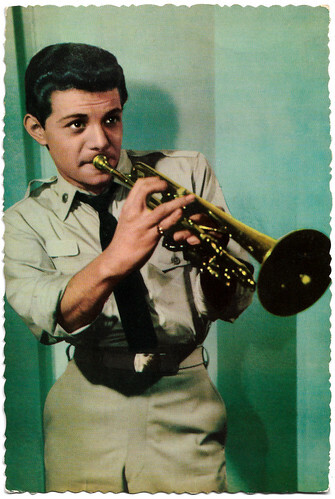
Spanish postcard by Archivo Bermejo, no. C-94, 1963. Photo: 20th Century Fox. Frankie Avalon on the set of Voyage to the Bottom of the Sea (Irwin Allen, 1961).
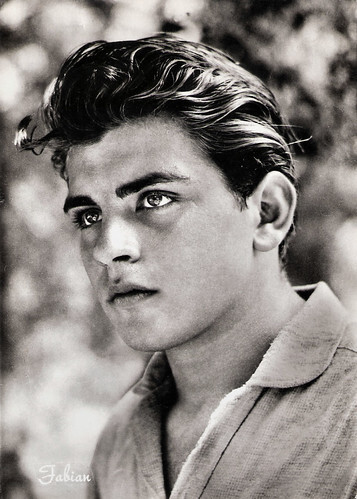
Italian postcard by Rotalfoto, no. 923. Sent by mail in 1963. American singer and actor Fabian Forte (1943) a.k.a. Fabian.
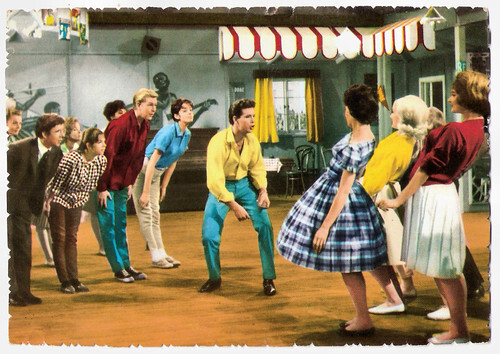 Spanish postcard, no. 18. Photo: British Pathe.
Cliff Richard
in The Young Ones (Sidney J. Furie, 1961).
Spanish postcard, no. 18. Photo: British Pathe.
Cliff Richard
in The Young Ones (Sidney J. Furie, 1961).
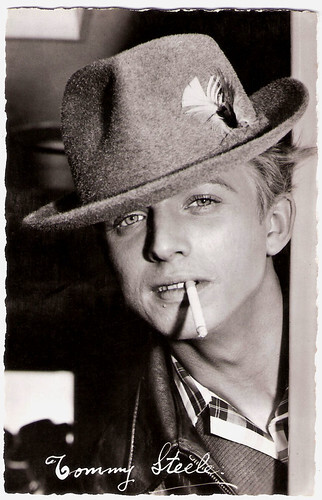
Vintage postcard. Tommy Steele.
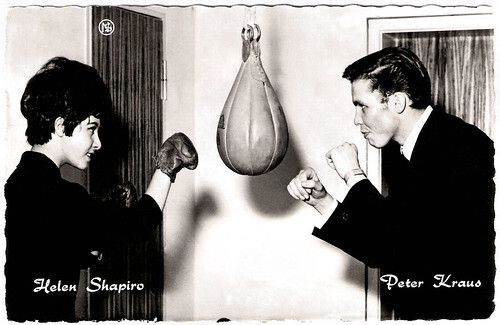
Dutch postcard, no. 6357. Sent by mail in the Netherlands in 1965. Helen Shapiro meets a German teen idol, Peter Kraus .
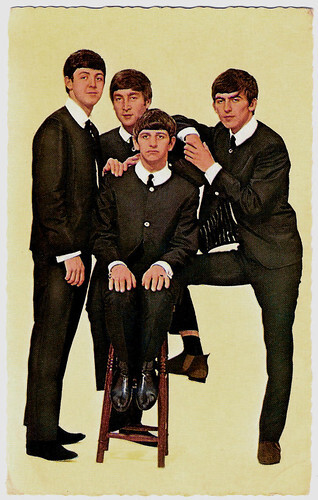
Vintage postcard. The Beatles .
Great Britain: The idol maker and his stable of stars
Teen idols such as Ricky Nelson, Bobby Rydell, Bobby Darin, Paul Anka, Frankie Avalon, Fabian Forte, and Pat Boone seemed to be the kind of earnest young men any father would be happy to have his own daughter go out on a date with, and Annette Funicello and Sandra Dee were the young women a son would aspire to marry. Their clean-cut good looks meant that they would play well on television, which was rapidly replacing the radio as the main source of family entertainment.
The teen idols were enormously popular. Attracting huge crowds wherever they went, their records proceeded to climb to the top of the Rock charts. Naturally, since armies of teenage girls wanted to touch them, legions of teenage boys tried to imitate them. Given the fact that many teen idols couldn't really sing, the sugary pop arrangements exhibiting a mere trace of the big beat took on even greater importance.
The fact that many of the singers were already stars on TV or in the cinema (including Sal Mineo and Tab Hunter ) virtually assured the success of promotional efforts on the part of the record labels. In the late 1950s, teen idols were often given roles in films, supporting older male stars in order to attract a younger audience. Ricky Nelson starred opposite John Wayne in the Western Rio Bravo (Howard Hawks, 1964) and Frankie Avalon appeared with Alan Ladd in the Western Guns of the Timberland (Robert D. Webb, 1960). In the 1960s, Avalon increasingly turned to the cinema and teamed up with Annette Funicello in a series of popular beach movies.
Teen idols usually appeared in magazines aimed at teenagers. Stories of teen idols literally discovered on their front porches (Fabian Forte) abounded in fan publications. In the 1950s, teen idols had to keep their romance(s) and marriage(s) secret or risk losing popularity. If the combined forces of the industry (label promotion, trade ads, and exposure on both radio playlists and American Bandstand) were marshalled on behalf of a young performer, anything was possible. The formula consistently worked from the late 1950s up to the mid-1960s.
A similar – if more cynical – approach to the teenage market was being employed in Great Britain, where showbiz impresario Larry Parnes employed good-looking young male singers on a weekly wage, before marketing them heavily to exploit their looks and talent. 'The idol maker' had a 'stable of stars', each of whom he gave a new identity – Ron Wycherley became Billy Fury; Reg Smith was christened Marty Wilde. Parnes not only gave each singer a new moniker, but he also managed their public appearance, ensuring each boy’s haircut was slicked up high and that they knew how to present themselves so as to have mass appeal. Similarly, Tommy Steele , Cliff Richard , and Helen Shapiro became 'idols of the young', particularly at the very beginning of their careers.
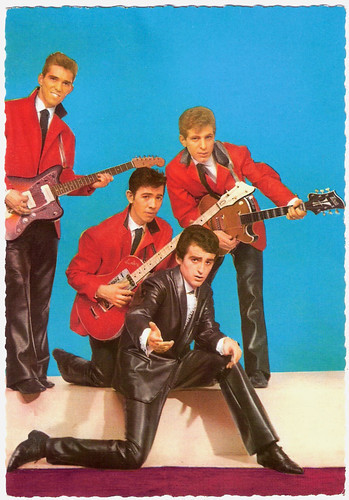 French postcard by E.D.U.G., no. 228. Photo: Sam Lévin. Dick Rivers and Les Chats Sauvages
French postcard by E.D.U.G., no. 228. Photo: Sam Lévin. Dick Rivers and Les Chats Sauvages
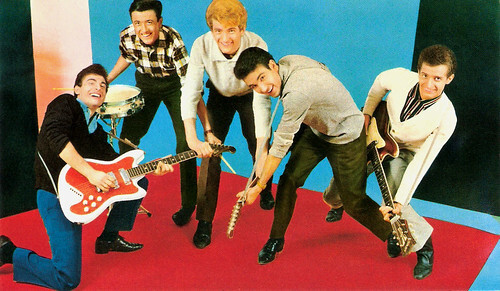
French postcard by E.D.U.G., no. 250, offered by Corvisart. Photo: Roland Carré. Eddy Mitchell and Les Chausettes Noires.
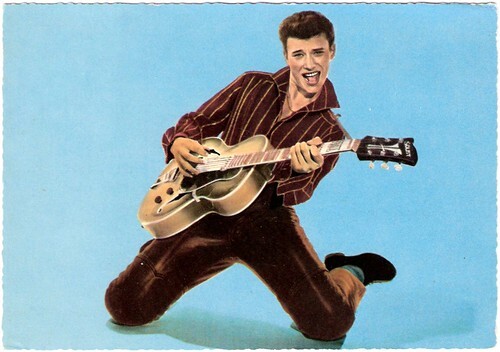
German postcard by ISV, no. H 85. Johnny Hallyday .
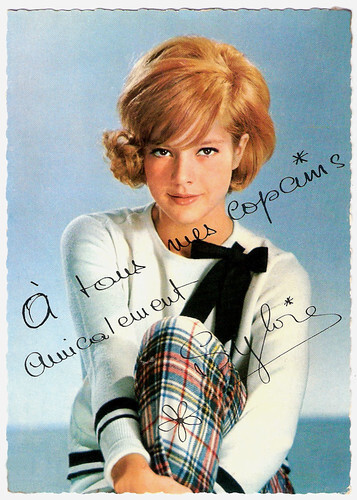
French postcard by E.D.U.G., no. 276. Offered by André. Photo: Sam Lévin. Sylvie Vartan .
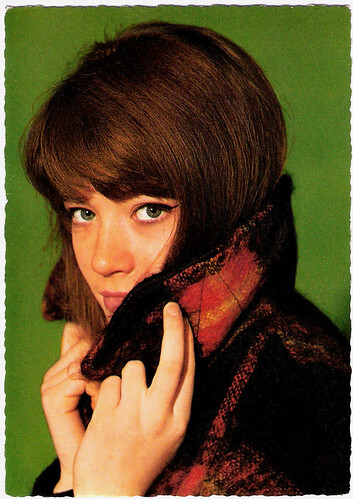
French postcard by Publistar, no. 858. Photo: Spitzer / Disques Vogue. Françoise Hardy.
Beatlemania and the yé-yé movement
In the early 1960s, the reigning teen idols soon found themselves outclassed by a new phenomenon. By following in Larry Parnes’ footsteps, manager Brian Epstein was able to sell his protégées, The Beatles . He put them in smart suits, had them present themselves cleanly and politely, and made them appeal to a family audience. The Beatles soon became the most successful and influential band in modern musical history. Adolescent hysteria was so loud that the band had trouble performing at concerts.
Also in the US, The Beatles created a sensation. The band stayed at the top of Billboard charts for a grand total of 58 weeks between 1964 and 1970. The level of stardom they achieved in the U.S. — dubbed 'Beatlemania' — was never before seen in that country, not even during the heyday of Elvis Presley.
The Beatles , and also The Rolling Stones were definitively teen idols, especially during the earlier part of their careers, although they quickly grew out of that status. The Rolling Stones did it through a more rebellious image, the Beatles did it through their more adult music. The great majority of the music being marketed to 1950s teens was written by adults, but 1960s teens were increasingly appreciating and emulating artists closer to their own age, to teen fashion, and to lyrics that addressed their own concerns.
In France emerged the Yé-yé in the early 1960s. Yé-yé was a particular form of the counterculture that derived most of its inspiration from British and American Rock and Roll with elements of pop, jazz, and the French chanson. The style expanded worldwide as a result of the success of French teen idols such as Johnny Hallyday, Sylvie Vartan , and Françoise Hardy . Influenced by Elvis Presley and the 1950s Rock and Roll revolution, Johnny Hallyday and such groups as Les Chats Sauvages and Les Chaussures Noires had started to sing Rock and Roll in French. Their music topped almost every European chart, but
The yé-yé movement had its origins in the radio program 'Salut les copains' (Hello mates), created by Jean Frydman and hosted by Daniel Filipacchi and Frank Ténot, which first aired in December 1959. The program became an immediate success, and one of its sections, 'Le chouchou de la semaine' (This Week's Sweetheart), became the starting point for most yé-yé singers. Any song that was presented as a chouchou went straight to the top places in the charts. The Salut les copains phenomenon continued with a magazine of the same name that was first published in 1962 in France, with German, Spanish, and Italian editions following shortly afterward.
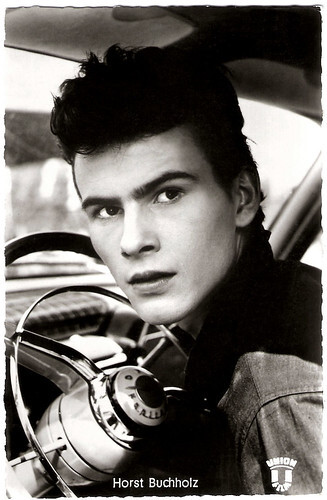 German postcard by Kolibri-Verlag, Minden Westf., no. 2204. Photo: Interwest / Union-Film.
Horst Buchholz
in Die Halbstarken/Teenage Wolfpack (Georg Tressler, 1956).
German postcard by Kolibri-Verlag, Minden Westf., no. 2204. Photo: Interwest / Union-Film.
Horst Buchholz
in Die Halbstarken/Teenage Wolfpack (Georg Tressler, 1956).

Dutch postcard by Hercules, Haarlem, no. 279. Photo: Hafbofilm. Sabine Sinjen and Corny Collins in Schmutziger Engel/Imperfect Angel (Alfred Vohrer, 1958).
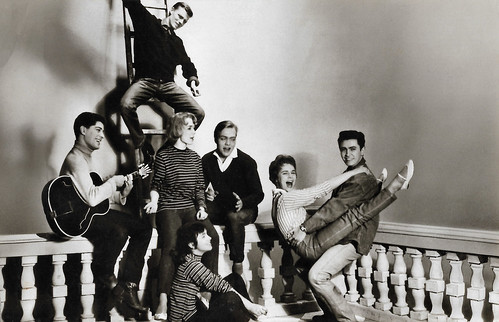
German postcard by Hans Josef Rüdel, Filmpostkartenverlag, Hamburg-Bergedorf, no. 2647. Photo: H.P. / Union / Haenchen. Conny Froboess , Rex Gildo , Richard Hellmann , Elke Arendt, Monika Leonhardt, Sergio Casmai and Hans Zander in Hula-Hopp, Conny (Heinz Paul, 1959).
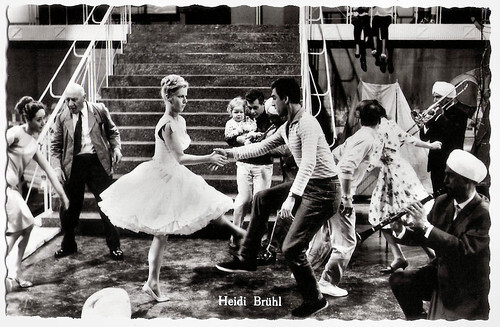
Dutch postcard by N.V. v.h. Weenenk & Snel, Baarn, no. 761. Photo: Gofilex. Heidi Brühl in Immer will ich dich gehören/Always I will be yours (Arno Assmann, 1960).
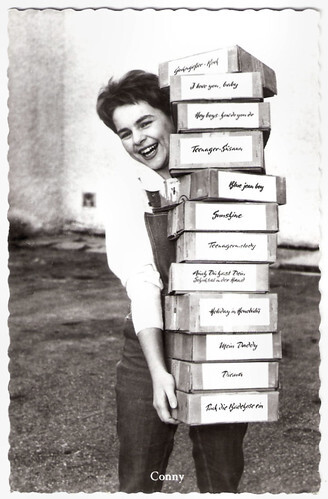
Dutch postcard by N.V. v.h. Weenenk & Snel, Baarn. Sent by mail in 1961. Conny Froboess holding copies of several of her films.
Greaser riots in Germany
In the late 1950s, American Rock and Roll became popular in (West) Germany. There was a new subculture of adolescents – mostly male and of working-class parents – that appeared in public in an aggressive and provocative way. They were called 'Halbstarke' (literally half-strengths", loosely 'greasers'). These Halbstarken often wore a quiff, jeans, checked shirts, and leather jackets. They had found prototypes for their fashion and style in American films, e.g. in Rebel Without a Cause (Nicholas Ray, 1955) as well as the stars of Rock and Roll.
In 1956 Karin Baal and Horst Buchholz became idols thanks to the film Die Halbstarken/Teenage Wolfpack (Georg Tressler, 1956). That same year Bill Haley & His Comets' song 'Rock Around The Clock' reached #1 in the German Pop charts. On 30 December 1956, about 4000 juveniles walked through Dortmund’s city, affronting passers-by, rampaging, and having battles with the police, after a cinema screening of Rock Around the Clock (Fred F. Sears, 1956) with Bill Haley. More big riots occurred in 1957 and 1958. Often, the furniture of cinemas and concert halls was totally destroyed. These riots started severe discussions in media and politics. The seeming sense- and directionlessness of the riots weren’t comprehensible.
Ted Herold and Peter Kraus became the most popular German-language rock singers. Kraus's single 'Wenn Teenager träumen' (When Teenagers Dream) sold 500,000 copies in 1958. The same year, the musical film Wenn die Conny mit dem Peter/If Conny with Peter (Fritz Umgelter, 1958) hit theatres. Peter Kraus and his co-star Conny Froboess were celebrated as the 'it' couple in the world of mainstream film. Their success continued with the sequel, Conny und Peter machen Musik/Conny and Peter Make Music (Werner Jacobs, 1960).
Conny Froboess was also a teen idol of the 1950s and early 1960s. After the Rock and Roll wave had hit Germany, she appeared in many West German and Austrian Schlager films, in which she often portrayed the typical 'Berliner Göre' (brat from Berlin) who craves independence from her strict parents.
In 1962, Froboess finished in sixth place at the Eurovision Song Contest, where she sang 'Zwei kleine Italiener' (Two little Italians) for Germany. That same year she also appeared as herself in Jean Renoir 's comedy The Elusive Corporal (1962). She finished her career as a teen idol and became a respectable theatre and film actress, under the name of Cornelia Froboess .
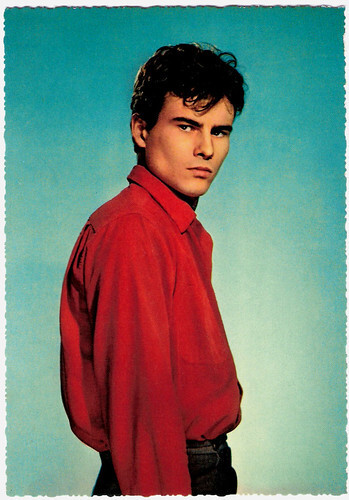
German postcard by Krüger, no. 902/92. Photo: Sam Lévin. Horst Buchholz .
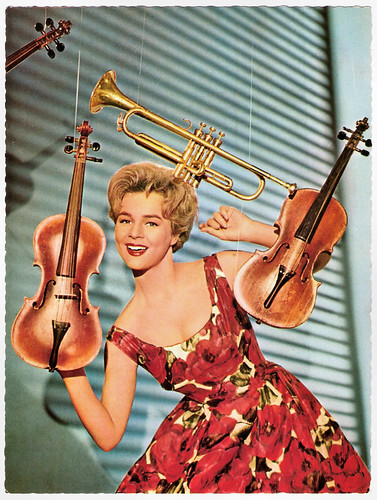
Big Dutch postcard by Gebr. Spanjersberg N.V., Rotterdam. Cornelia Froboess .
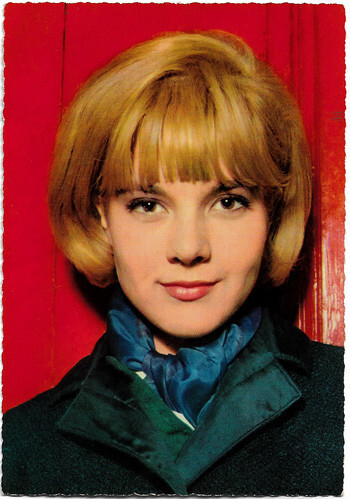
West-German postcard by Krüger, no. 902/267 Photo: Neuvecelle. Sylvie Vartan .
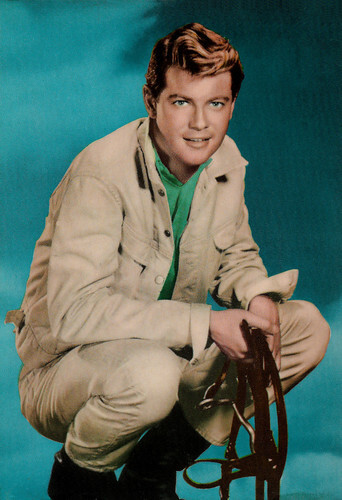
Spanish postcard by C y A, no. 29. Photo: Warner Bros. Caption: Troy Donahue, co-stars in Warner Bros. Palm Springs Weekend.
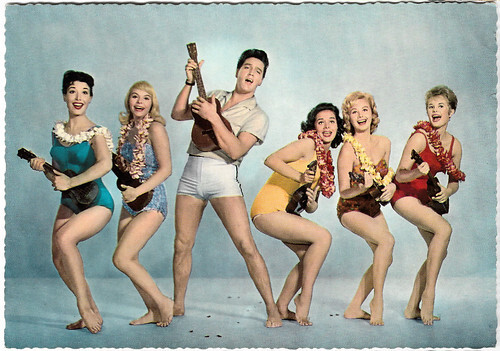
German postcard by Krüger, no. 902/145. Photo: UFA. Elvis Presley in Blue Hawaii (Norman Taurog, 1961) with Pamela Austin, Joan Blackman Jenny Maxwell, Darlene Tompkins, and Nancy Walters.
Sources: Frank Hoffmann (Survey of American Popular Music), Paul McGuinness (Udiscovermusic), and Wikipedia
 Italian postcard by Rotalfoto, Milano, no. 519. Photo: Richard Miller / Warner Bros.
James Dean
at the set of Giant (George Stevens, 1956).
Italian postcard by Rotalfoto, Milano, no. 519. Photo: Richard Miller / Warner Bros.
James Dean
at the set of Giant (George Stevens, 1956).
British postcard in the Picturegoer Series, London, no. D. 837. Photo: Warner Bros. Sal Mineo in Rebel Without a Cause (Nicholas Ray, 1955).

Belgian postcard by E.D.U.G., no. 172. Ricky Nelson.

Dutch postcard by Uitg. Takken, Utrecht, no. AX 3978. Photo: Paramount. Elvis Presley and Carolyn Jones in King Creole (Michael Curtiz, 1958).

West-German postcard by Krüger, no. 902/9. Photo: Terb Agency. Sandra Dee in Gidget (Paul Wendkos, 1959).
Against the corrupting influence of Rock and Roll
Post-war teens were able to buy relatively inexpensive phonographs — including portable models that could be carried to friends' houses — and the new 45-rpm singles. Rock and Roll music of artists like Elvis Presley, Chuck Berry, Jerry Lee Lewis, Buddy Holly, and Fats Domino, played on 45s became the soundtrack to the 1950s as people bought what they heard on the radio. Rock and Roll had evolved from Rhythm and Blues, a sound developed by African-American musicians that by the early 1950s had slowly begun to reach a new audience in young white teenagers. By nature of its association with blackness, many white American adults feared that Rock and Roll was a corrupting influence on their children, promoting socialising between races, juvenile delinquency, even premarital sex.
Music was not the only thing that disturbed conservative grown-ups. In August 1957, pioneer Rock and Roll disc jockey Alan Freed’s WABC-TV teen dance show Big Beat was cancelled after African-American artist Frankie Lymon was seen dancing with a white girl on the program. Less than a year later, at the Boston date of his Big Beat Spring 1958 tour, Freed was charged with anarchy and inciting the youths in attendance to riot, though the charges were later dropped.
Parents worried about their kids' attraction to artists who were edgy and rebellious. So the industry took control and created new teen idols. New faces on magazines fed fans; fans buy records, see films, watch TV and buy fashions. In all of these media, the new formula consisted of selling products associated with photogenic, well-mannered young people to teenage consumers.
The ingredients of a teen idol recording included an attractive usually white, conservatively attired, and well-groomed young media star singing simple lyrics about typically middle-class teen concerns. Some marketers turned to film and TV for fresh, attractive, 'safe' faces. Ricky Nelson, a performer of rockabilly music, became a teen idol through his parents' television series, The Adventures of Ozzie and Harriet. With many parents disapproving of Elvis Presley, Nelson became a safe alternative. Another young TV star who was hustled into a studio to make recordings was ex-Mousketeer Annette Funicello who became one of the first big female idols.
Marketing of the teen idol generally focused on the image. The teen idol was structured to appeal to t young female pop audience members. They were commodified in forms and images that are relatively non-threatening to this young audience and to the ancillary market of parents. The process had the implicit blessing of parents and other authority figures given the alternative; that American youth would fall under the influence of more rebellious cultural icons, including juvenile delinquents feared to inhabit the street corners of every 1950s town and, of course, Rock and Roll stars. An unspoken compromise between the teen desire for an energetic rock beat and the establishment’s need for convention was achieved.

Spanish postcard by Archivo Bermejo, no. C-94, 1963. Photo: 20th Century Fox. Frankie Avalon on the set of Voyage to the Bottom of the Sea (Irwin Allen, 1961).

Italian postcard by Rotalfoto, no. 923. Sent by mail in 1963. American singer and actor Fabian Forte (1943) a.k.a. Fabian.
 Spanish postcard, no. 18. Photo: British Pathe.
Cliff Richard
in The Young Ones (Sidney J. Furie, 1961).
Spanish postcard, no. 18. Photo: British Pathe.
Cliff Richard
in The Young Ones (Sidney J. Furie, 1961). 
Vintage postcard. Tommy Steele.

Dutch postcard, no. 6357. Sent by mail in the Netherlands in 1965. Helen Shapiro meets a German teen idol, Peter Kraus .

Vintage postcard. The Beatles .
Great Britain: The idol maker and his stable of stars
Teen idols such as Ricky Nelson, Bobby Rydell, Bobby Darin, Paul Anka, Frankie Avalon, Fabian Forte, and Pat Boone seemed to be the kind of earnest young men any father would be happy to have his own daughter go out on a date with, and Annette Funicello and Sandra Dee were the young women a son would aspire to marry. Their clean-cut good looks meant that they would play well on television, which was rapidly replacing the radio as the main source of family entertainment.
The teen idols were enormously popular. Attracting huge crowds wherever they went, their records proceeded to climb to the top of the Rock charts. Naturally, since armies of teenage girls wanted to touch them, legions of teenage boys tried to imitate them. Given the fact that many teen idols couldn't really sing, the sugary pop arrangements exhibiting a mere trace of the big beat took on even greater importance.
The fact that many of the singers were already stars on TV or in the cinema (including Sal Mineo and Tab Hunter ) virtually assured the success of promotional efforts on the part of the record labels. In the late 1950s, teen idols were often given roles in films, supporting older male stars in order to attract a younger audience. Ricky Nelson starred opposite John Wayne in the Western Rio Bravo (Howard Hawks, 1964) and Frankie Avalon appeared with Alan Ladd in the Western Guns of the Timberland (Robert D. Webb, 1960). In the 1960s, Avalon increasingly turned to the cinema and teamed up with Annette Funicello in a series of popular beach movies.
Teen idols usually appeared in magazines aimed at teenagers. Stories of teen idols literally discovered on their front porches (Fabian Forte) abounded in fan publications. In the 1950s, teen idols had to keep their romance(s) and marriage(s) secret or risk losing popularity. If the combined forces of the industry (label promotion, trade ads, and exposure on both radio playlists and American Bandstand) were marshalled on behalf of a young performer, anything was possible. The formula consistently worked from the late 1950s up to the mid-1960s.
A similar – if more cynical – approach to the teenage market was being employed in Great Britain, where showbiz impresario Larry Parnes employed good-looking young male singers on a weekly wage, before marketing them heavily to exploit their looks and talent. 'The idol maker' had a 'stable of stars', each of whom he gave a new identity – Ron Wycherley became Billy Fury; Reg Smith was christened Marty Wilde. Parnes not only gave each singer a new moniker, but he also managed their public appearance, ensuring each boy’s haircut was slicked up high and that they knew how to present themselves so as to have mass appeal. Similarly, Tommy Steele , Cliff Richard , and Helen Shapiro became 'idols of the young', particularly at the very beginning of their careers.
 French postcard by E.D.U.G., no. 228. Photo: Sam Lévin. Dick Rivers and Les Chats Sauvages
French postcard by E.D.U.G., no. 228. Photo: Sam Lévin. Dick Rivers and Les Chats Sauvages
French postcard by E.D.U.G., no. 250, offered by Corvisart. Photo: Roland Carré. Eddy Mitchell and Les Chausettes Noires.

German postcard by ISV, no. H 85. Johnny Hallyday .

French postcard by E.D.U.G., no. 276. Offered by André. Photo: Sam Lévin. Sylvie Vartan .

French postcard by Publistar, no. 858. Photo: Spitzer / Disques Vogue. Françoise Hardy.
Beatlemania and the yé-yé movement
In the early 1960s, the reigning teen idols soon found themselves outclassed by a new phenomenon. By following in Larry Parnes’ footsteps, manager Brian Epstein was able to sell his protégées, The Beatles . He put them in smart suits, had them present themselves cleanly and politely, and made them appeal to a family audience. The Beatles soon became the most successful and influential band in modern musical history. Adolescent hysteria was so loud that the band had trouble performing at concerts.
Also in the US, The Beatles created a sensation. The band stayed at the top of Billboard charts for a grand total of 58 weeks between 1964 and 1970. The level of stardom they achieved in the U.S. — dubbed 'Beatlemania' — was never before seen in that country, not even during the heyday of Elvis Presley.
The Beatles , and also The Rolling Stones were definitively teen idols, especially during the earlier part of their careers, although they quickly grew out of that status. The Rolling Stones did it through a more rebellious image, the Beatles did it through their more adult music. The great majority of the music being marketed to 1950s teens was written by adults, but 1960s teens were increasingly appreciating and emulating artists closer to their own age, to teen fashion, and to lyrics that addressed their own concerns.
In France emerged the Yé-yé in the early 1960s. Yé-yé was a particular form of the counterculture that derived most of its inspiration from British and American Rock and Roll with elements of pop, jazz, and the French chanson. The style expanded worldwide as a result of the success of French teen idols such as Johnny Hallyday, Sylvie Vartan , and Françoise Hardy . Influenced by Elvis Presley and the 1950s Rock and Roll revolution, Johnny Hallyday and such groups as Les Chats Sauvages and Les Chaussures Noires had started to sing Rock and Roll in French. Their music topped almost every European chart, but
The yé-yé movement had its origins in the radio program 'Salut les copains' (Hello mates), created by Jean Frydman and hosted by Daniel Filipacchi and Frank Ténot, which first aired in December 1959. The program became an immediate success, and one of its sections, 'Le chouchou de la semaine' (This Week's Sweetheart), became the starting point for most yé-yé singers. Any song that was presented as a chouchou went straight to the top places in the charts. The Salut les copains phenomenon continued with a magazine of the same name that was first published in 1962 in France, with German, Spanish, and Italian editions following shortly afterward.
 German postcard by Kolibri-Verlag, Minden Westf., no. 2204. Photo: Interwest / Union-Film.
Horst Buchholz
in Die Halbstarken/Teenage Wolfpack (Georg Tressler, 1956).
German postcard by Kolibri-Verlag, Minden Westf., no. 2204. Photo: Interwest / Union-Film.
Horst Buchholz
in Die Halbstarken/Teenage Wolfpack (Georg Tressler, 1956).
Dutch postcard by Hercules, Haarlem, no. 279. Photo: Hafbofilm. Sabine Sinjen and Corny Collins in Schmutziger Engel/Imperfect Angel (Alfred Vohrer, 1958).

German postcard by Hans Josef Rüdel, Filmpostkartenverlag, Hamburg-Bergedorf, no. 2647. Photo: H.P. / Union / Haenchen. Conny Froboess , Rex Gildo , Richard Hellmann , Elke Arendt, Monika Leonhardt, Sergio Casmai and Hans Zander in Hula-Hopp, Conny (Heinz Paul, 1959).

Dutch postcard by N.V. v.h. Weenenk & Snel, Baarn, no. 761. Photo: Gofilex. Heidi Brühl in Immer will ich dich gehören/Always I will be yours (Arno Assmann, 1960).

Dutch postcard by N.V. v.h. Weenenk & Snel, Baarn. Sent by mail in 1961. Conny Froboess holding copies of several of her films.
Greaser riots in Germany
In the late 1950s, American Rock and Roll became popular in (West) Germany. There was a new subculture of adolescents – mostly male and of working-class parents – that appeared in public in an aggressive and provocative way. They were called 'Halbstarke' (literally half-strengths", loosely 'greasers'). These Halbstarken often wore a quiff, jeans, checked shirts, and leather jackets. They had found prototypes for their fashion and style in American films, e.g. in Rebel Without a Cause (Nicholas Ray, 1955) as well as the stars of Rock and Roll.
In 1956 Karin Baal and Horst Buchholz became idols thanks to the film Die Halbstarken/Teenage Wolfpack (Georg Tressler, 1956). That same year Bill Haley & His Comets' song 'Rock Around The Clock' reached #1 in the German Pop charts. On 30 December 1956, about 4000 juveniles walked through Dortmund’s city, affronting passers-by, rampaging, and having battles with the police, after a cinema screening of Rock Around the Clock (Fred F. Sears, 1956) with Bill Haley. More big riots occurred in 1957 and 1958. Often, the furniture of cinemas and concert halls was totally destroyed. These riots started severe discussions in media and politics. The seeming sense- and directionlessness of the riots weren’t comprehensible.
Ted Herold and Peter Kraus became the most popular German-language rock singers. Kraus's single 'Wenn Teenager träumen' (When Teenagers Dream) sold 500,000 copies in 1958. The same year, the musical film Wenn die Conny mit dem Peter/If Conny with Peter (Fritz Umgelter, 1958) hit theatres. Peter Kraus and his co-star Conny Froboess were celebrated as the 'it' couple in the world of mainstream film. Their success continued with the sequel, Conny und Peter machen Musik/Conny and Peter Make Music (Werner Jacobs, 1960).
Conny Froboess was also a teen idol of the 1950s and early 1960s. After the Rock and Roll wave had hit Germany, she appeared in many West German and Austrian Schlager films, in which she often portrayed the typical 'Berliner Göre' (brat from Berlin) who craves independence from her strict parents.
In 1962, Froboess finished in sixth place at the Eurovision Song Contest, where she sang 'Zwei kleine Italiener' (Two little Italians) for Germany. That same year she also appeared as herself in Jean Renoir 's comedy The Elusive Corporal (1962). She finished her career as a teen idol and became a respectable theatre and film actress, under the name of Cornelia Froboess .

German postcard by Krüger, no. 902/92. Photo: Sam Lévin. Horst Buchholz .

Big Dutch postcard by Gebr. Spanjersberg N.V., Rotterdam. Cornelia Froboess .

West-German postcard by Krüger, no. 902/267 Photo: Neuvecelle. Sylvie Vartan .

Spanish postcard by C y A, no. 29. Photo: Warner Bros. Caption: Troy Donahue, co-stars in Warner Bros. Palm Springs Weekend.

German postcard by Krüger, no. 902/145. Photo: UFA. Elvis Presley in Blue Hawaii (Norman Taurog, 1961) with Pamela Austin, Joan Blackman Jenny Maxwell, Darlene Tompkins, and Nancy Walters.
Sources: Frank Hoffmann (Survey of American Popular Music), Paul McGuinness (Udiscovermusic), and Wikipedia
Published on February 18, 2022 22:00
February 17, 2022
Ann Harding
Ann Harding (1902–1981) was an American film actress. She was signed by Pathé and made her debut, with Fredric March in Paris Bound (1929). She became a leading lady and was nominated for the Oscar for Best Actress in 1931 for her work in Holiday (1930). She was the gentle, refined heroine as in The Animal Kingdom (1932), wherein she played Daisy, the rejected fiancee of Leslie Howard.
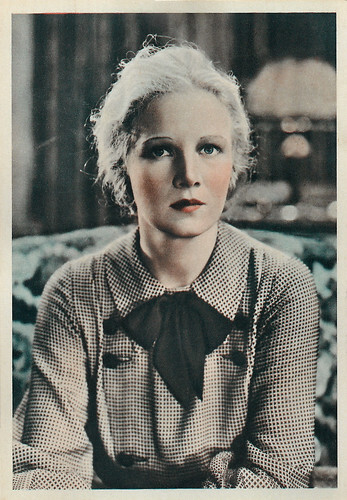
British postcard by De Reszke Cigarettes, no. 21. Photo: Paramount. Caption: An established stage actress, and a warm favourite with the public long before she embarked on a screen career. Was ambitious to become a writer, and with this object in view, she became a scriptwriter for Paramount. Then came her first part - that of feminine lead in a small play. The star of such film successes as Holiday, The Conquerors, The Right to Romance, and Gallant Lady.
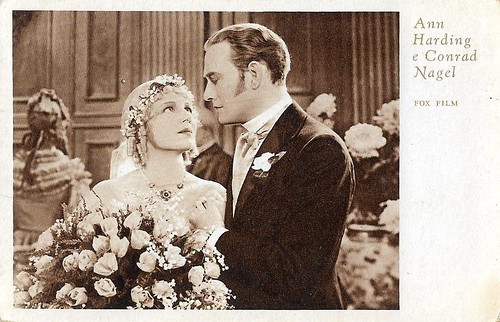
Italian postcard by Cinema-Illustrazione, series II, no. 22. Photo: Fox Film. Ann Harding and Conrad Nagel in East Lynne (Frank Lloyd, 1931).
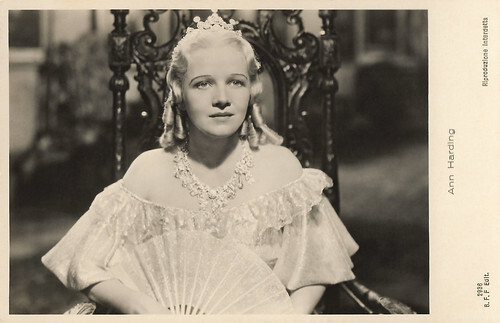
Italian postcard by B.F.F. Edit (Ballerini & Fratini, Firenze), no. 2936. Photo: Paramount Pictures. Ann Harding in Peter Ibbetson (Henry Hathaway, 1935).
Broadway's bright new star
Ann Harding was born Dorothy Walton Gatley in San Antonio, Texas, in 1902. The daughter of Army captain George G. Gatley and his wife Elizabeth Walton Gatley, Ann spent a lot of time traveling around the US whenever her West Point-educated father was transferred. Moving to such places as Illinois, Kentucky, New Jersey, Cuba, and Pennsylvania made it very hard to put down roots.
By the time the family settled in New York, Ann was well out of high school. Ann first appeared on the stage while she spent a year attending Bryn Mawr College. She became a clerk with the Metropolitan Life Insurance Co., her college education put aside owing to financial difficulties. She went to work as a freelance script reader with the film company Famous Players-Lasky.
After attending a play in New York City, Ann discovered that the acting company was holding auditions for a part, and she decided to give it a try. To her surprise, she won a large part. She received critical acclaim for her role in 'Inheritors' (1921) and decided she would continue her budding career. Because her father opposed her career choice, she used the stage name, Ann Harding.
For the next eight years, Ann performed in a variety of stage productions and became Broadway's bright new star. In 1929, Harding was signed by Pathé Studios and made her film debut as Mary Hutton in the Pre-Code early-talkie film Paris Bound (Edward H. Griffith. 1929), co-starring with Fredric March . Later that year she starred with her husband, Harry Bannister (whom she married in 1926 and divorced in 1932) in Her Private Affair (Paul L. Stein, 1929). The film was an enormous commercial success.
Harding's performances were heralded by the critics, who cited her diction and stage experience as assets to the then-new medium of 'talking pictures'. Her role in Condemned! (Wesley Ruggles, 1929) opposite Ronald Colman , for which she was loaned out to United Artists, rounded out her work for that year. Back at Pathé, she starred in the romantic comedy Holiday (Edward H. Griffith, 1930), the film that solidified her image as an actress.
During this period, Ann Harding was generally considered to be one of cinema's most beautiful actresses, with her waist-length blonde hair being one of her most noted physical attributes. Next up was The Girl of the Golden West (John Francis Dillon, 1930), which again had her husband in the second role.
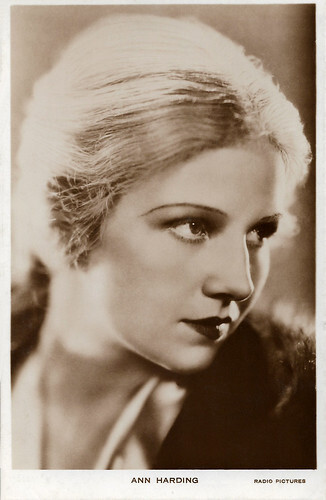
British Real Photograph postcard. Photo: Radio Pictures.
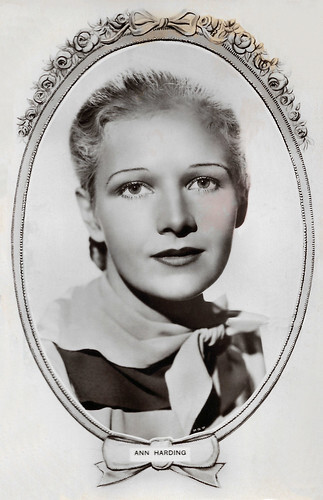
British postcard in the Cameo Series, London, no. K 46. Photo: M.G.M.
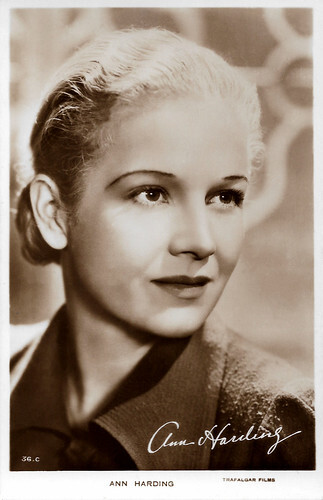
British Real Photograph postcard, no. 36.C. Photo: Trafalgar Films. Publicity still for Love from a Stranger (Rowland V. Lee, 1937).
The beautiful, innocent, self-sacrificing woman
Ann Harding was a leading lady now. She was loaned out to Fox to play Lady Isabella in East Lynne (Frank Lloyd, 1931) opposite Clive Brook . During production, her husband would show up on the set and try to tell the director how to run the film. He was finally banned from the set, and it hastened the demise of Ann's marriage to him.
She was the gentle, refined heroine as in The Animal Kingdom (Edward H. Griffith, 1932), wherein she played Daisy, the rejected fiancee of Leslie Howard . By 1933, her popularity started to decline as she appeared in a parade of tearjerkers as the beautiful, innocent, self-sacrificing woman, and film work became harder for her to obtain.
After appearing in the British-made Love from a Stranger (Rowland V. Lee, 1937), she married conductor Werner Janssen. Ann took a five-year hiatus from acting, not appearing on-screen until Eyes in the Night (Fred Zinnemann, 1942) with Edward Arnold. After Christmas Eve (Edwin L. Marin, 1947), she appeared second-billed in Two Weeks with Love (Roy Rowland, 1950) starring Jane Powell and Ricardo Montalban .
Then followed a part in The Unknown Man (Richard Thorpe, 1951) with Walter Pidgeon. Her final films were Strange Intruder (Irving Rapper, 1956) starring Edmund Purdom , and The Man in the Gray Flannel Suit (Nunnally Johnson, 1956), in which she appeared once again with Fredric March , the man with whom she started her career.
She worked occasionally in television between 1955 and 1965, and she appeared in two plays in the early 1960s, returning to the stage after an absence of over 30 years. In 1962, she starred in 'General Seeger', directed by and co-starring George C. Scott, and in 1964 she appeared in 'Abraham Cochrane' and 'The Corn is Green'.
After her 1965 retirement, she resided in Sherman Oaks, California. In 1981, Ann Harding passed away there, at age 79. Harding had a daughter, Jane (1928-2005) with her first husband, Harry Bannister. Their divorce in 1932 led to a year-and-a-half-long custody battle. Her second marriage, to Werner Janssen, ended in divorce in 1963. From this marriage, Harding had two stepchildren, Alice and Werner Jr. Harding began living with Grace Kaye, an adult companion, later known as Grace Kaye Harding. Harding referred to Kaye as her daughter. Following her death, Ann Harding was interred at Forest Lawn Memorial Park (Hollywood Hills) in Los Angeles, California, in the Court of Remembrance.
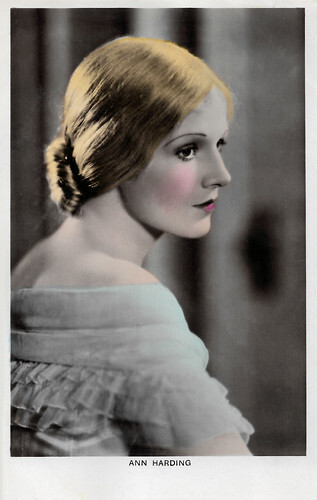
British postcard in the Colourgraph series, no. C.67.
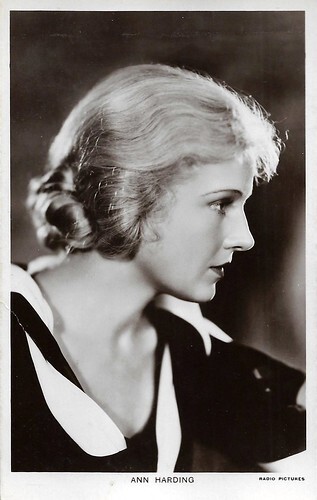
British postcard in the Picturegoer Series, London, no. 436c. Photo: Radio Pictures.
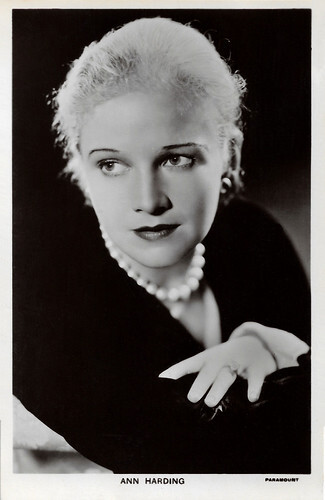
British postcard in the Picturegoer Series, London, no. 1085. Photo: Paramount.
Sources: (IMDb), (IMDb), Wikipedia, and .

British postcard by De Reszke Cigarettes, no. 21. Photo: Paramount. Caption: An established stage actress, and a warm favourite with the public long before she embarked on a screen career. Was ambitious to become a writer, and with this object in view, she became a scriptwriter for Paramount. Then came her first part - that of feminine lead in a small play. The star of such film successes as Holiday, The Conquerors, The Right to Romance, and Gallant Lady.

Italian postcard by Cinema-Illustrazione, series II, no. 22. Photo: Fox Film. Ann Harding and Conrad Nagel in East Lynne (Frank Lloyd, 1931).

Italian postcard by B.F.F. Edit (Ballerini & Fratini, Firenze), no. 2936. Photo: Paramount Pictures. Ann Harding in Peter Ibbetson (Henry Hathaway, 1935).
Broadway's bright new star
Ann Harding was born Dorothy Walton Gatley in San Antonio, Texas, in 1902. The daughter of Army captain George G. Gatley and his wife Elizabeth Walton Gatley, Ann spent a lot of time traveling around the US whenever her West Point-educated father was transferred. Moving to such places as Illinois, Kentucky, New Jersey, Cuba, and Pennsylvania made it very hard to put down roots.
By the time the family settled in New York, Ann was well out of high school. Ann first appeared on the stage while she spent a year attending Bryn Mawr College. She became a clerk with the Metropolitan Life Insurance Co., her college education put aside owing to financial difficulties. She went to work as a freelance script reader with the film company Famous Players-Lasky.
After attending a play in New York City, Ann discovered that the acting company was holding auditions for a part, and she decided to give it a try. To her surprise, she won a large part. She received critical acclaim for her role in 'Inheritors' (1921) and decided she would continue her budding career. Because her father opposed her career choice, she used the stage name, Ann Harding.
For the next eight years, Ann performed in a variety of stage productions and became Broadway's bright new star. In 1929, Harding was signed by Pathé Studios and made her film debut as Mary Hutton in the Pre-Code early-talkie film Paris Bound (Edward H. Griffith. 1929), co-starring with Fredric March . Later that year she starred with her husband, Harry Bannister (whom she married in 1926 and divorced in 1932) in Her Private Affair (Paul L. Stein, 1929). The film was an enormous commercial success.
Harding's performances were heralded by the critics, who cited her diction and stage experience as assets to the then-new medium of 'talking pictures'. Her role in Condemned! (Wesley Ruggles, 1929) opposite Ronald Colman , for which she was loaned out to United Artists, rounded out her work for that year. Back at Pathé, she starred in the romantic comedy Holiday (Edward H. Griffith, 1930), the film that solidified her image as an actress.
During this period, Ann Harding was generally considered to be one of cinema's most beautiful actresses, with her waist-length blonde hair being one of her most noted physical attributes. Next up was The Girl of the Golden West (John Francis Dillon, 1930), which again had her husband in the second role.

British Real Photograph postcard. Photo: Radio Pictures.

British postcard in the Cameo Series, London, no. K 46. Photo: M.G.M.

British Real Photograph postcard, no. 36.C. Photo: Trafalgar Films. Publicity still for Love from a Stranger (Rowland V. Lee, 1937).
The beautiful, innocent, self-sacrificing woman
Ann Harding was a leading lady now. She was loaned out to Fox to play Lady Isabella in East Lynne (Frank Lloyd, 1931) opposite Clive Brook . During production, her husband would show up on the set and try to tell the director how to run the film. He was finally banned from the set, and it hastened the demise of Ann's marriage to him.
She was the gentle, refined heroine as in The Animal Kingdom (Edward H. Griffith, 1932), wherein she played Daisy, the rejected fiancee of Leslie Howard . By 1933, her popularity started to decline as she appeared in a parade of tearjerkers as the beautiful, innocent, self-sacrificing woman, and film work became harder for her to obtain.
After appearing in the British-made Love from a Stranger (Rowland V. Lee, 1937), she married conductor Werner Janssen. Ann took a five-year hiatus from acting, not appearing on-screen until Eyes in the Night (Fred Zinnemann, 1942) with Edward Arnold. After Christmas Eve (Edwin L. Marin, 1947), she appeared second-billed in Two Weeks with Love (Roy Rowland, 1950) starring Jane Powell and Ricardo Montalban .
Then followed a part in The Unknown Man (Richard Thorpe, 1951) with Walter Pidgeon. Her final films were Strange Intruder (Irving Rapper, 1956) starring Edmund Purdom , and The Man in the Gray Flannel Suit (Nunnally Johnson, 1956), in which she appeared once again with Fredric March , the man with whom she started her career.
She worked occasionally in television between 1955 and 1965, and she appeared in two plays in the early 1960s, returning to the stage after an absence of over 30 years. In 1962, she starred in 'General Seeger', directed by and co-starring George C. Scott, and in 1964 she appeared in 'Abraham Cochrane' and 'The Corn is Green'.
After her 1965 retirement, she resided in Sherman Oaks, California. In 1981, Ann Harding passed away there, at age 79. Harding had a daughter, Jane (1928-2005) with her first husband, Harry Bannister. Their divorce in 1932 led to a year-and-a-half-long custody battle. Her second marriage, to Werner Janssen, ended in divorce in 1963. From this marriage, Harding had two stepchildren, Alice and Werner Jr. Harding began living with Grace Kaye, an adult companion, later known as Grace Kaye Harding. Harding referred to Kaye as her daughter. Following her death, Ann Harding was interred at Forest Lawn Memorial Park (Hollywood Hills) in Los Angeles, California, in the Court of Remembrance.

British postcard in the Colourgraph series, no. C.67.

British postcard in the Picturegoer Series, London, no. 436c. Photo: Radio Pictures.

British postcard in the Picturegoer Series, London, no. 1085. Photo: Paramount.
Sources: (IMDb), (IMDb), Wikipedia, and .
Published on February 17, 2022 22:00
February 16, 2022
L'innamorata (1920)
Italian diva Italia Almirante Manzini is the star of the Italian silent melodrama L'innamorata/The Woman in Love (Gennaro Righelli, 1920), produced by Fert Film The Spanish chocolate manufacturer Chocolat Imperiale in Barcelona published a series of six hand-coloured 'cromos' of the film.
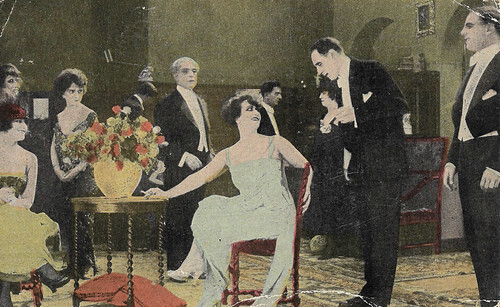
Spanish cromo by Chocolat Imperiale, Barcelona, no. 1 of 6. Photo: Distr. J. Verdaguer, Barcelona / Fert. Italia Almirante in L'innamorata (Gennaro Righelli, 1920).
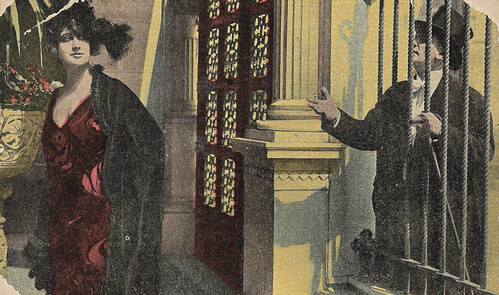
Spanish cromo by Chocolat Imperiale, Barcelona, no. 2 of 6. Photo: Distr. J. Verdaguer, Barcelona / Fert. Italia Almirante and Alberto Collo in L'innamorata (Gennaro Righelli, 1920).
A tragedy caused by frivolity
in L'innamorata/The Woman in Love (Gennaro Righelli, 1920), vampish Mara Flores ( Italia Almirante ) leads the life of a capricious and elegant society lady. Her life is one string of adventures, while her ex-tutor and counselor Prince Benedict keeps an eye on her patrimony.
Her newest conquest is the electric engineer Carlo Valdieri ( Alberto Collo ) who thinks her house is a branch office of paradise, but with vague excuses, he is closed out of this heaven. The next day she visits the Central power plant, where she hears he is busy and her beauty doesn't suffice to reach her goals.
She meets Luigi Arnaldi ( Annibale Betrone ), who is both his brother and the factory director, and tries to seduce him but doesn't manage, as he focuses on his work and his family. (In Italian sources Luigi is called Franco.) The friendship between Mara and Carlo works so intoxicatingly on him that he is forced to sign letters of credit above his own budget. Out of caprice, she visits Luigi, who explains to her that touching one of the electricity cables is deadly, he also tells her Carlo cannot pay his debts. Mara then decides to distance herself from Carlo and renews her friendship with the Prince, her tutor.
This troubles the brains of Carlo such that he announces Mara to kill himself. Feeling her beauty is the cause of this, Mara runs to him but still arrives too late. Before this tragedy, the woman understands the harm her frivolity has caused. Mara is inconsolable, she cannot smile anymore and her eyes are filled with tears. Her only comfort is her love for Luigi Arnaldi, but he cannot forget what happened and refuses to receive her. She insists, declaring her love with passion. Finally, Luigi gives in.
Yet, happiness is disturbed again, as Mara is haunted by gossip and slander, and Luigi neglects his work. The chairman of the factory board sends Luigi's mother a letter about the conduct of her son. Luigi's sister Orietta (Orietta Claudi) accuses Mara of destroying Luigi like she did Carlo. Mara tries to mend with the two women but is rejected bitterly. The next day she accompanies Luigi to the factory, explains what happened, and accepts her loss. When he doesn't look for a moment she lies down as on an altar while the deadly current immolates her life for the sake of the man she loved so much.
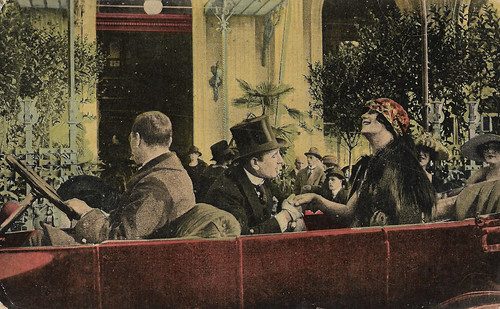
Spanish cromo by Chocolat Imperiale, Barcelona, no. 3 of 6. Photo: Distr. J. Verdaguer, Barcelona / Fert. Italia Almirante and Alberto Collo in L'innamorata (Gennaro Righelli, 1920).
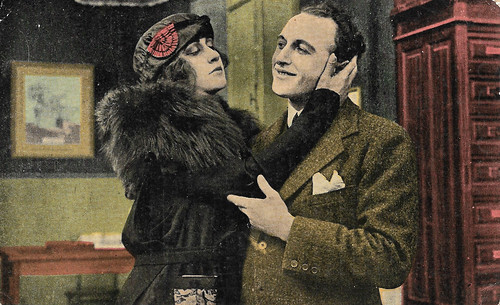
Spanish cromo by Chocolat Imperiale, Barcelona, no. 4 of 6. Photo: Distr. J. Verdaguer, Barcelona / Fert. Italia Almirante and Annibale Betrone in L'innamorata (Gennaro Righelli, 1920).
In this film, she reveals the rich resources of her artistic temperament
L'innamorata/The Woman in Love (Gennaro Righelli, 1920) was based on the well-known novel 'L'orizzontale' by Augusto Genina, which title already hints at the past of this woman and was also the first of a long list of changes imposed by the Italian censor.
The title became L'innamorata and the subtitle of the film was Mara Flores. In the UK the film was released as Payment in Full and in Spain as Eva pecadora.
The film, with sets by Giulio Lombardazzi and cinematography by Ubaldo Arata, had its Roman premiere on 9 April 1920.
In 1921, the critic of the Neapolitan film journal La Cine-fono, Carlo Fischer, raved about the script (even if admitting the plot was simple), the cinematography, the beautiful exteriors, and, above all, the performance of Manzini:
"Italia Almirante Manzini is not unknown in the film world - actually, the opposite - but never she gave such an important performance as in Mara Flores. From this brilliant performance, we are convinced that this sympathetic actress will triumph on the screen. In this film, she reveals the rich resources of her artistic temperament, with sobriety, a nonchalance, an enchanting charm."
In 1994, a 40-minute restored version of L'innamorata/The Woman in Love (Gennaro Righelli, 1920) was presented by the Cineteca di Bologna at the Il cinema ritrovato film festival.
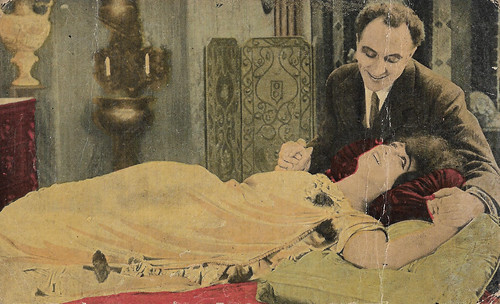
Spanish cromo by Chocolat Imperiale, Barcelona, no. 5 of 6. Photo: Distr. J. Verdaguer, Barcelona / Fert. Italia Almirante and Annibale Betrone in L'innamorata (Gennaro Righelli, 1920).
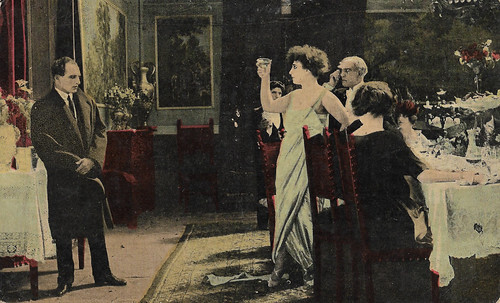
Spanish cromo by Chocolat Imperiale, Barcelona, no. 6 of 6. Photo: Distr. J. Verdaguer, Barcelona / Fert. Italia Almirante and Annibale Betrone in L'innamorata (Gennaro Righelli, 1920).
Sources: Vittorio Martinelli (Il cinema muto italiano. I film del dopoguerra, Vol. 1920), IMDb, Wikipedia (Italian) and the content of the plot was taken from the back of the cards.

Spanish cromo by Chocolat Imperiale, Barcelona, no. 1 of 6. Photo: Distr. J. Verdaguer, Barcelona / Fert. Italia Almirante in L'innamorata (Gennaro Righelli, 1920).

Spanish cromo by Chocolat Imperiale, Barcelona, no. 2 of 6. Photo: Distr. J. Verdaguer, Barcelona / Fert. Italia Almirante and Alberto Collo in L'innamorata (Gennaro Righelli, 1920).
A tragedy caused by frivolity
in L'innamorata/The Woman in Love (Gennaro Righelli, 1920), vampish Mara Flores ( Italia Almirante ) leads the life of a capricious and elegant society lady. Her life is one string of adventures, while her ex-tutor and counselor Prince Benedict keeps an eye on her patrimony.
Her newest conquest is the electric engineer Carlo Valdieri ( Alberto Collo ) who thinks her house is a branch office of paradise, but with vague excuses, he is closed out of this heaven. The next day she visits the Central power plant, where she hears he is busy and her beauty doesn't suffice to reach her goals.
She meets Luigi Arnaldi ( Annibale Betrone ), who is both his brother and the factory director, and tries to seduce him but doesn't manage, as he focuses on his work and his family. (In Italian sources Luigi is called Franco.) The friendship between Mara and Carlo works so intoxicatingly on him that he is forced to sign letters of credit above his own budget. Out of caprice, she visits Luigi, who explains to her that touching one of the electricity cables is deadly, he also tells her Carlo cannot pay his debts. Mara then decides to distance herself from Carlo and renews her friendship with the Prince, her tutor.
This troubles the brains of Carlo such that he announces Mara to kill himself. Feeling her beauty is the cause of this, Mara runs to him but still arrives too late. Before this tragedy, the woman understands the harm her frivolity has caused. Mara is inconsolable, she cannot smile anymore and her eyes are filled with tears. Her only comfort is her love for Luigi Arnaldi, but he cannot forget what happened and refuses to receive her. She insists, declaring her love with passion. Finally, Luigi gives in.
Yet, happiness is disturbed again, as Mara is haunted by gossip and slander, and Luigi neglects his work. The chairman of the factory board sends Luigi's mother a letter about the conduct of her son. Luigi's sister Orietta (Orietta Claudi) accuses Mara of destroying Luigi like she did Carlo. Mara tries to mend with the two women but is rejected bitterly. The next day she accompanies Luigi to the factory, explains what happened, and accepts her loss. When he doesn't look for a moment she lies down as on an altar while the deadly current immolates her life for the sake of the man she loved so much.

Spanish cromo by Chocolat Imperiale, Barcelona, no. 3 of 6. Photo: Distr. J. Verdaguer, Barcelona / Fert. Italia Almirante and Alberto Collo in L'innamorata (Gennaro Righelli, 1920).

Spanish cromo by Chocolat Imperiale, Barcelona, no. 4 of 6. Photo: Distr. J. Verdaguer, Barcelona / Fert. Italia Almirante and Annibale Betrone in L'innamorata (Gennaro Righelli, 1920).
In this film, she reveals the rich resources of her artistic temperament
L'innamorata/The Woman in Love (Gennaro Righelli, 1920) was based on the well-known novel 'L'orizzontale' by Augusto Genina, which title already hints at the past of this woman and was also the first of a long list of changes imposed by the Italian censor.
The title became L'innamorata and the subtitle of the film was Mara Flores. In the UK the film was released as Payment in Full and in Spain as Eva pecadora.
The film, with sets by Giulio Lombardazzi and cinematography by Ubaldo Arata, had its Roman premiere on 9 April 1920.
In 1921, the critic of the Neapolitan film journal La Cine-fono, Carlo Fischer, raved about the script (even if admitting the plot was simple), the cinematography, the beautiful exteriors, and, above all, the performance of Manzini:
"Italia Almirante Manzini is not unknown in the film world - actually, the opposite - but never she gave such an important performance as in Mara Flores. From this brilliant performance, we are convinced that this sympathetic actress will triumph on the screen. In this film, she reveals the rich resources of her artistic temperament, with sobriety, a nonchalance, an enchanting charm."
In 1994, a 40-minute restored version of L'innamorata/The Woman in Love (Gennaro Righelli, 1920) was presented by the Cineteca di Bologna at the Il cinema ritrovato film festival.

Spanish cromo by Chocolat Imperiale, Barcelona, no. 5 of 6. Photo: Distr. J. Verdaguer, Barcelona / Fert. Italia Almirante and Annibale Betrone in L'innamorata (Gennaro Righelli, 1920).

Spanish cromo by Chocolat Imperiale, Barcelona, no. 6 of 6. Photo: Distr. J. Verdaguer, Barcelona / Fert. Italia Almirante and Annibale Betrone in L'innamorata (Gennaro Righelli, 1920).
Sources: Vittorio Martinelli (Il cinema muto italiano. I film del dopoguerra, Vol. 1920), IMDb, Wikipedia (Italian) and the content of the plot was taken from the back of the cards.
Published on February 16, 2022 22:00
February 15, 2022
The Three Musketeers (1948)
The Three Musketeers (George Sidney, 1948) is a classic Swashbuckler, starring Gene Kelly as D’Artagnan and Lana Turner as Milady De Winter. Other stars in the cast include Van Heflin, June Allyson, Gig Young, Angela Lansbury, and Vincent Price. It is one of the many, adaptations of the famous French book ‘Les trois mousquetaires’ by Alexandre Dumas père, and possibly the liveliest one, full of acrobatics, galloping horses, flapping cloaks, and sword fights with almost operatic intensity. Dumas’s story is followed quite faithfully, but the creative fantasy is in the theatrical way of depicting it.
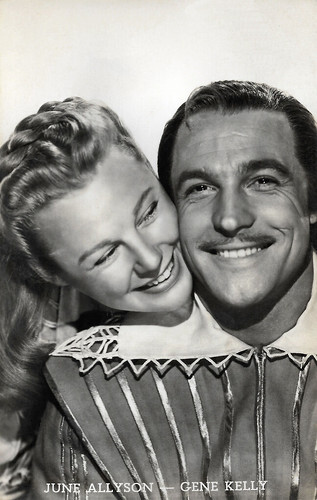
Dutch postcard by van Leer's Fotodrukindustrie N.V., Amsterdam, no. 351, no. 6. Photo: Metro Goldwyn Mayer (M.G.M.) June Allyson and Gene Kelly in The Three Musketeers (George Sidney, 1948), based on the novel by Alexandre Dumas.

Dutch postcard by Foto Archief Film en Toneel, no. 3454. Photo: M.G.M. Van Heflin, Gene Kelly, Gig Young, and Robert Coote in in The Three Musketeers (George Sidney, 1948), based on the novel by Alexandre Dumas.
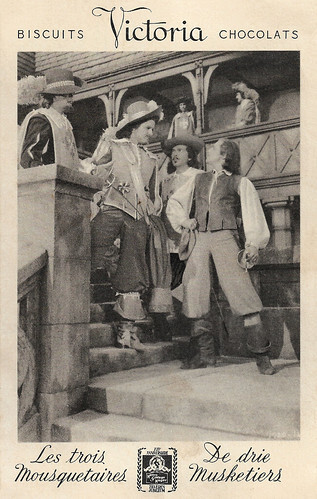
Belgian postcard by Victoria Biscuits Chocolats, no. 3. Photo: M.G.M. Van Heflin, Robert Coote, Gig Young, and Gene Kelly in The Three Musketeers (George Sidney, 1948), based on the novel by Alexandre Dumas.
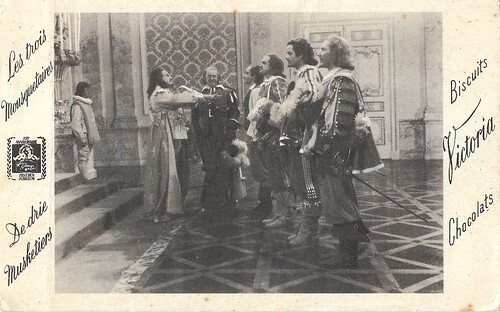
Belgian postcard by Victoria Biscuits Chocolats, no. 4. Photo: M.G.M. Frank Morgan, Reginald Owen, Gene Kelly, Van Heflin, Gig Young, and Robert Coote in The Three Musketeers (George Sidney, 1948), based on the novel by Alexandre Dumas.

Belgian postcard by Victoria Biscuits Chocolats, no. 5. Photo: M.G.M. June Allyson and Gene Kelly in The Three Musketeers (George Sidney, 1948), based on the novel by Alexandre Dumas.
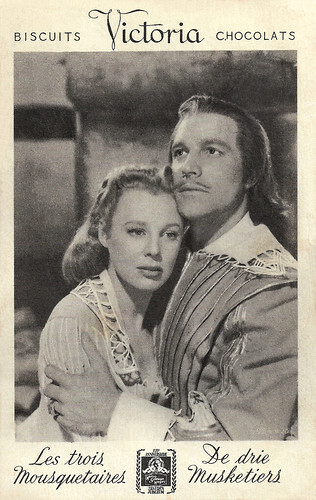
Belgian postcard by Victoria Biscuits Chocolats, no. 6. Photo: M.G.M. June Allyson and Gene Kelly in The Three Musketeers (George Sidney, 1948), based on the novel by Alexandre Dumas.
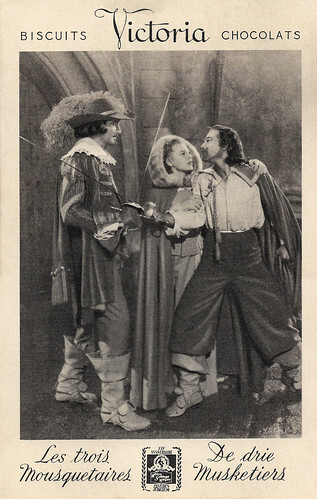
Belgian postcard by Victoria Biscuits Chocolats, no. 8. Photo: M.G.M. June Allyson and Gene Kelly in The Three Musketeers (George Sidney, 1948), based on the novel by Alexandre Dumas.
The good advice never to let himself be compromised with impunity
As in the book, the story of The Three Musketeers (George Sidney, 1948) is set in 1625 in France. The young and inexperienced D'Artagnan (Gene Kelly) leaves his home village in Gascony to become a musketeer in Paris in the service of His Majesty King Louis XIII (Frank Morgan). In his pocket, he has the letter of recommendation from his father (silent film star Robert Warwick), a former musketeer and friend of the current captain of the musketeers, Treville (Reginald Owen).
His father has taught him the art of fencing masterfully and gives him the good advice never to let himself be compromised with impunity. He is only too happy to follow this advice. Very soon, before he has even reached Paris, D'Artagnan gets into a confrontation with Rochefort (Ian Keith), Cardinal Richelieu's ( Vincent Price ) confidant, and his companion, the mysterious Lady de Winter ( Lana Turner ). At this first opportunity to preserve his honour in battle, he is unceremoniously struck down and robbed by Rochefort's henchmen, and his credentials are also taken from him.
Once in Paris, he not only meets his new friends and comrades-in-arms Athos (Van Heflin), Porthos (Gig Young), and Aramis (Robert Coote), but also his landlord's niece, Constance Bonacieux (June Allyson), and falls in love. Many adventures and entanglements lie ahead and in the path of the brave hero D'Artagnan. Driven by his desire to become the king's musketeer and to prove himself in battle, he falls into the clutches of both Queen Anne ( Angela Lansbury ) and cardinal Richelieu, experiences numerous dangerous situations, and sometimes needs his new friends to get away at all.
Nevertheless, he sets out to travel to England for the Queen's honour, to retrieve a jewellery box given away by the Queen's secret lover, Lord Buckingham (John Sutton), and to prevent Richelieu from plotting. To assist him, he is accompanied by Athos, Porthos, and Aramis, as well as his dull but loyal servant Planchet (Keenan Wynn). Shortly after D'Artagnan's return from England, Constance is kidnapped at the behest of Cardinal Richelieu. D'Artagnan makes a pass at Milady de Winter, discovers a delicate secret, and only just manages to save himself.
Constance is freed and taken to safety in England, shortly after which war breaks out, and our four friends are drawn into it. They overhear a conspiratorial meeting between the Cardinal and Lady de Winter in an inn. The latter is to travel to England and kill Buckingham. Planchet also travels to England at D'Artagnan's behest to warn Buckingham. Lady de Winter is convicted and is to be executed. Constance is appointed her guardian. Milady de Winter, after a lengthy psychological duel, manages to take out Constance as well as a guard and Buckingham and then escapes. Athos and D'Artagnan, who wanted to help Constance, arrive too late; after Constance dies in D'Artagnan's arms, they themselves also have only escaped.
Back in Paris, the four friends track down Lady de Winter, pronounce the death sentence on her, and have the prisoner executed. During their subsequent escape towards Spain, they are overpowered and arrested. Their fate seems to be sealed, but young D'Artagnan still has one trump card: the Countess's passport, personally sealed and signed by Cardinal Richelieu, with the note that everything the bearer of this letter undertakes will serve the good of the state. The king is not allowed to know the background of this letter - so Richelieu has to give in. Aramis receives permission to take up a clerical office. Porthos is allowed to marry richly, Athos gets his property back and D'Artagnan is to negotiate a peace offer with the enemy England on behalf of France.
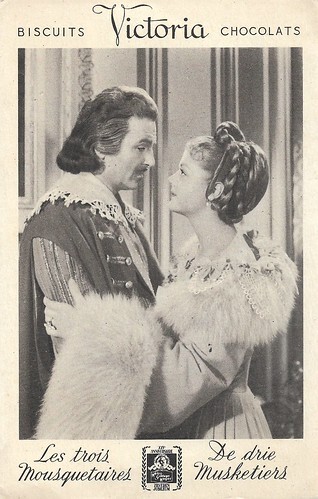
Belgian postcard by Victoria Biscuits Chocolats, no. 9. Photo: M.G.M. John Sutton as The Duke of Buckingham and Angela Lansbury as Queen Anne in The Three Musketeers (George Sidney, 1948), based on the novel by Alexandre Dumas.
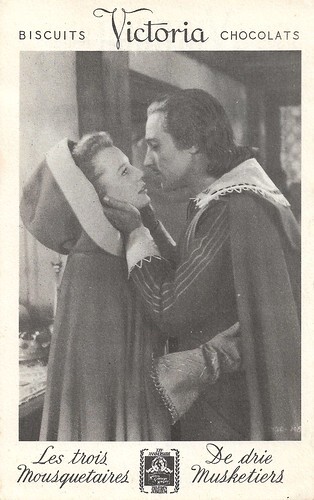
Belgian postcard by Victoria Biscuits Chocolats, no. 10. Photo: M.G.M. June Allyson as Constance Bonacieux and Gene Kelly as D'Artagnan in The Three Musketeers (George Sidney, 1948), based on the novel by Alexandre Dumas.
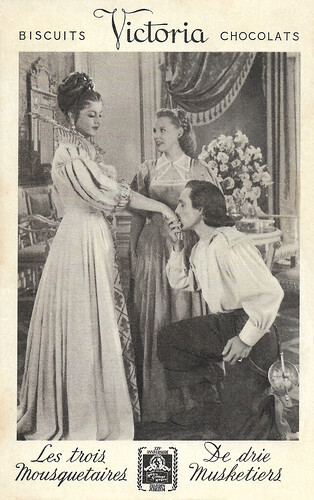
Belgian postcard by Victoria Biscuits Chocolats, no. 12. Photo: M.G.M. Angela Lansbury , June Allyson, and Gene Kelly in The Three Musketeers (George Sidney, 1948), based on the novel by Alexandre Dumas.
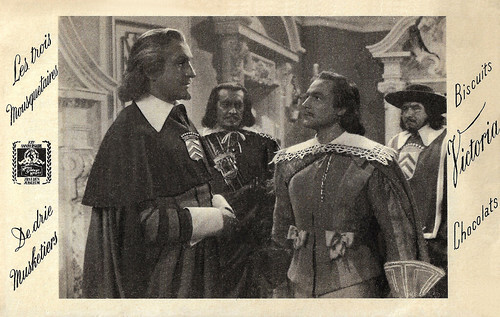
Belgian postcard by Victoria Biscuits Chocolats, no. 14. Photo: M.G.M. Vincent Price and Gene Kelly in The Three Musketeers (George Sidney, 1948), based on the novel by Alexandre Dumas.
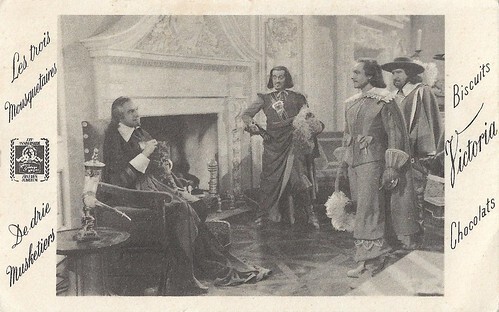
Belgian postcard by Victoria Biscuits Chocolats, no. 15. Photo: M.G.M. Gene Kelly as D'Artagnan and Vincent Price as Richelieu in The Three Musketeers (George Sidney, 1948), based on the novel by Alexandre Dumas.
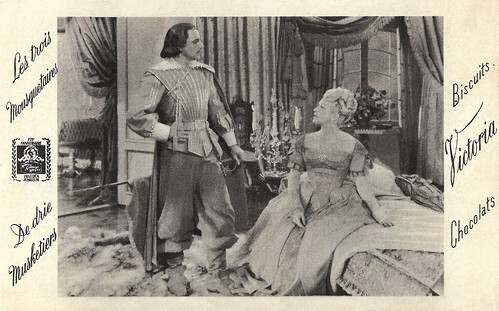
Belgian postcard by Victoria Biscuits Chocolats, no. 16. Photo: M.G.M. Gene Kelly and Lana Turner in The Three Musketeers (George Sidney, 1948), based on the novel by Alexandre Dumas.
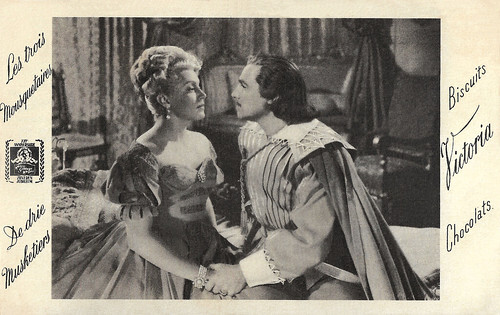
Belgian postcard by Victoria Biscuits Chocolats, no. 17. Photo: M.G.M. Lana Turner and Gene Kelly in The Three Musketeers (George Sidney, 1948), based on the novel by Alexandre Dumas.
An outrageously entertaining yarn
Among the many American film versions of Alexandre Dumas' 'Les trois mousquetaires' (The Three Musketeer) are the 1914 Film Attractions Co. production, directed by Charles V. Henkel, the 1921 Douglas Fairbanks production, directed by Fred Niblo, the 1935 RKO Radio Pictures, Inc. production, directed by Rowland V. Lee and starring Walter Abel, Paul Lukas, and Margot Grahame, Richard Lester's 1974 Twentieth Century-Fox production starring Michael York , Oliver Reed , Richard Chamberlain, and Raquel Welch ; and the 1993 Buena Vista release, directed by Stephen Herek and starring Charlie Sheen, Kiefer Sutherland, Chris O'Donnell, and Rebecca de Mornay.
This splashy 1948 MGM adaptation of The Three Musketeers was the third sound version and was also the first version in Technicolor. In 1947, a representative of the National Catholic Legion of Decency, an organisation that monitored the interests of the Church in motion pictures, objected to the characterisation of Cardinal Richelieu in the planned MGM adaptation of Dumas' story. In a letter to MGM producer Pandro S. Berman, the organisation stated its objection to the cardinal being portrayed as a "worldly and unscrupulous man" and urged the studio to remove the character from the film. Berman refused to remove the character from the film but promised he would use great caution in all sensitive matters pertaining to the story and in the film, Richelieu is never referred to as Cardinal Richelieu.
Berman also indicated that Constance, the married mistress of D'Artagnan in the novel, would be unmarried in the film version. While early sound versions of The Three Musketeers eliminated the deaths of Constance and Milady, this adaptation telescopes the novel's events to allow for these tragedies. According to AFI , screenwriter Robert Ardry was displeased with director George Sidney's irreverent approach to the Dumas story and objected to the spoof elements that were added to the film.
A biography of Gene Kelly noted that Belgian fencing champion Jean Heremans, who appears in the film as the cardinal's guard, taught Kelly how to fence. Kelly's biography also noted that during the filming of a bedroom scene, Kelly flung Lana Turner onto a bed with such force that she fell to the ground and suffered a broken elbow. Hal Erickson at AllMovie : “True to form, MGM saw to it that Lana Turner, as Milady, was dressed to the nines and heavily bejeweled for her beheading sequence. Portions of the 1948 The Three Musketeers, in black and white, showed up in the silent film-within-a-film in 1952's Singin' in the Rain, which of course also starred Gene Kelly.”
The Three Musketeers opened to mostly favourable reviews, with several reviewers commenting on the film's unusual tongue-in-cheek approach. New York Times reviewer Bosley Crowther noted that "more glittering swordplay, more dazzling costumes, more colors or more of Miss Turner's chest have never been seen in a picture than are shown in this one." And added: “Completely fantastic, however, is Miss Turner as the villainess, the ambitious Lady de Winter who does the boudoir business for the boss. Loaded with blond hair and jewels, with twelve-gallon hats and ostrich plumes, and poured into her satin dresses with a good bit of Turner to spare, she walks through the palaces and salons with the air of a company-mannered Mae West.”
In 1948, there was an Oscar nomination for Robert Planck in the category Best Cinematography/Colour. And a more recent review, Hans J. Wollstein at AllMovie : “The Three Musketeers remains an outrageously entertaining yarn, the Southern California locales perfectly standing in for 17th Century France and England.” And finally, Yvette Banek at her blog In so many words : “ Lana Turner is really quite superb in her evilness. So evil that she is even photographed without make-up. Well, as 'without make-up' as MGM got, at any rate. Even then, she is exquisitely beautiful - especially when praying.”
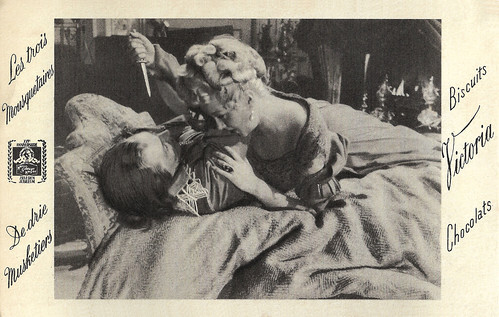
Belgian postcard by Victoria Biscuits Chocolats, no. 18. Photo: M.G.M. Gene Kelly and Lana Turner in The Three Musketeers (George Sidney, 1948), based on the novel by Alexandre Dumas.
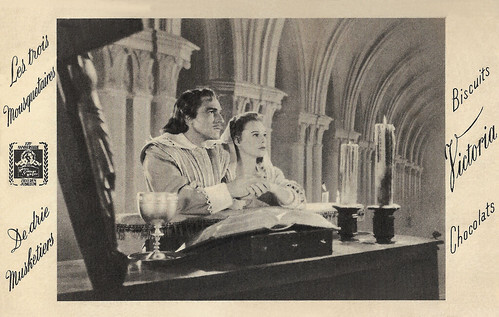
Belgian postcard by Victoria Biscuits Chocolats, no. 19. Photo: M.G.M. Gene Kelly and June Allyson in The Three Musketeers (George Sidney, 1948), based on the novel by Alexandre Dumas.
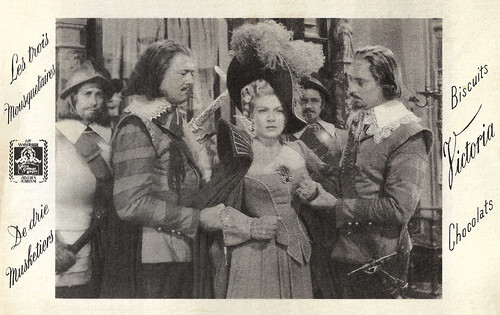
Belgian postcard by Victoria Biscuits Chocolats, no. 23. Photo: M.G.M. Lana Turner as Milady in The Three Musketeers (George Sidney, 1948), based on the novel by Alexandre Dumas.
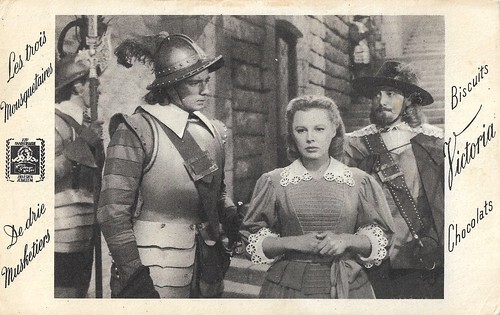
Belgian postcard by Victoria Biscuits Chocolats, no. 25. Photo: M.G.M. June Allyson as Constance Bonacieux in The Three Musketeers (George Sidney, 1948), based on the novel by Alexandre Dumas.
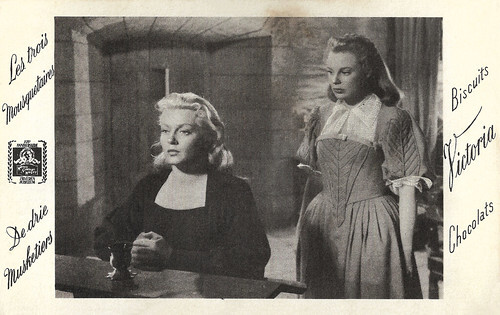
Belgian postcard by Victoria Biscuits Chocolats, no. 26. Photo: M.G.M. Lana Turner and June Allyson in The Three Musketeers (George Sidney, 1948), based on the novel by Alexandre Dumas.
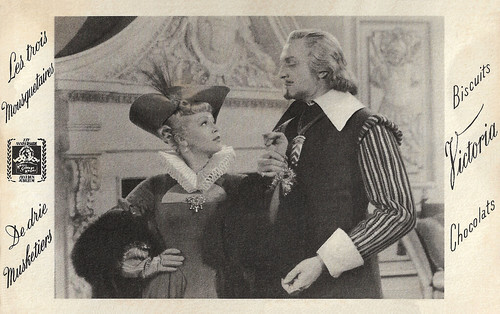
Belgian postcard by Victoria Biscuits Chocolats, no. 28. Photo: M.G.M. Lana Turner and Vincent Price in The Three Musketeers (George Sidney, 1948), based on the novel by Alexandre Dumas.
Sources: Bosley Crowther (New York Times), Hal Erickson (AllMovie), Yvette Banek (In so many words), AFI, Wikipedia (Dutch, German), and IMDb.

Dutch postcard by van Leer's Fotodrukindustrie N.V., Amsterdam, no. 351, no. 6. Photo: Metro Goldwyn Mayer (M.G.M.) June Allyson and Gene Kelly in The Three Musketeers (George Sidney, 1948), based on the novel by Alexandre Dumas.

Dutch postcard by Foto Archief Film en Toneel, no. 3454. Photo: M.G.M. Van Heflin, Gene Kelly, Gig Young, and Robert Coote in in The Three Musketeers (George Sidney, 1948), based on the novel by Alexandre Dumas.

Belgian postcard by Victoria Biscuits Chocolats, no. 3. Photo: M.G.M. Van Heflin, Robert Coote, Gig Young, and Gene Kelly in The Three Musketeers (George Sidney, 1948), based on the novel by Alexandre Dumas.

Belgian postcard by Victoria Biscuits Chocolats, no. 4. Photo: M.G.M. Frank Morgan, Reginald Owen, Gene Kelly, Van Heflin, Gig Young, and Robert Coote in The Three Musketeers (George Sidney, 1948), based on the novel by Alexandre Dumas.

Belgian postcard by Victoria Biscuits Chocolats, no. 5. Photo: M.G.M. June Allyson and Gene Kelly in The Three Musketeers (George Sidney, 1948), based on the novel by Alexandre Dumas.

Belgian postcard by Victoria Biscuits Chocolats, no. 6. Photo: M.G.M. June Allyson and Gene Kelly in The Three Musketeers (George Sidney, 1948), based on the novel by Alexandre Dumas.

Belgian postcard by Victoria Biscuits Chocolats, no. 8. Photo: M.G.M. June Allyson and Gene Kelly in The Three Musketeers (George Sidney, 1948), based on the novel by Alexandre Dumas.
The good advice never to let himself be compromised with impunity
As in the book, the story of The Three Musketeers (George Sidney, 1948) is set in 1625 in France. The young and inexperienced D'Artagnan (Gene Kelly) leaves his home village in Gascony to become a musketeer in Paris in the service of His Majesty King Louis XIII (Frank Morgan). In his pocket, he has the letter of recommendation from his father (silent film star Robert Warwick), a former musketeer and friend of the current captain of the musketeers, Treville (Reginald Owen).
His father has taught him the art of fencing masterfully and gives him the good advice never to let himself be compromised with impunity. He is only too happy to follow this advice. Very soon, before he has even reached Paris, D'Artagnan gets into a confrontation with Rochefort (Ian Keith), Cardinal Richelieu's ( Vincent Price ) confidant, and his companion, the mysterious Lady de Winter ( Lana Turner ). At this first opportunity to preserve his honour in battle, he is unceremoniously struck down and robbed by Rochefort's henchmen, and his credentials are also taken from him.
Once in Paris, he not only meets his new friends and comrades-in-arms Athos (Van Heflin), Porthos (Gig Young), and Aramis (Robert Coote), but also his landlord's niece, Constance Bonacieux (June Allyson), and falls in love. Many adventures and entanglements lie ahead and in the path of the brave hero D'Artagnan. Driven by his desire to become the king's musketeer and to prove himself in battle, he falls into the clutches of both Queen Anne ( Angela Lansbury ) and cardinal Richelieu, experiences numerous dangerous situations, and sometimes needs his new friends to get away at all.
Nevertheless, he sets out to travel to England for the Queen's honour, to retrieve a jewellery box given away by the Queen's secret lover, Lord Buckingham (John Sutton), and to prevent Richelieu from plotting. To assist him, he is accompanied by Athos, Porthos, and Aramis, as well as his dull but loyal servant Planchet (Keenan Wynn). Shortly after D'Artagnan's return from England, Constance is kidnapped at the behest of Cardinal Richelieu. D'Artagnan makes a pass at Milady de Winter, discovers a delicate secret, and only just manages to save himself.
Constance is freed and taken to safety in England, shortly after which war breaks out, and our four friends are drawn into it. They overhear a conspiratorial meeting between the Cardinal and Lady de Winter in an inn. The latter is to travel to England and kill Buckingham. Planchet also travels to England at D'Artagnan's behest to warn Buckingham. Lady de Winter is convicted and is to be executed. Constance is appointed her guardian. Milady de Winter, after a lengthy psychological duel, manages to take out Constance as well as a guard and Buckingham and then escapes. Athos and D'Artagnan, who wanted to help Constance, arrive too late; after Constance dies in D'Artagnan's arms, they themselves also have only escaped.
Back in Paris, the four friends track down Lady de Winter, pronounce the death sentence on her, and have the prisoner executed. During their subsequent escape towards Spain, they are overpowered and arrested. Their fate seems to be sealed, but young D'Artagnan still has one trump card: the Countess's passport, personally sealed and signed by Cardinal Richelieu, with the note that everything the bearer of this letter undertakes will serve the good of the state. The king is not allowed to know the background of this letter - so Richelieu has to give in. Aramis receives permission to take up a clerical office. Porthos is allowed to marry richly, Athos gets his property back and D'Artagnan is to negotiate a peace offer with the enemy England on behalf of France.

Belgian postcard by Victoria Biscuits Chocolats, no. 9. Photo: M.G.M. John Sutton as The Duke of Buckingham and Angela Lansbury as Queen Anne in The Three Musketeers (George Sidney, 1948), based on the novel by Alexandre Dumas.

Belgian postcard by Victoria Biscuits Chocolats, no. 10. Photo: M.G.M. June Allyson as Constance Bonacieux and Gene Kelly as D'Artagnan in The Three Musketeers (George Sidney, 1948), based on the novel by Alexandre Dumas.

Belgian postcard by Victoria Biscuits Chocolats, no. 12. Photo: M.G.M. Angela Lansbury , June Allyson, and Gene Kelly in The Three Musketeers (George Sidney, 1948), based on the novel by Alexandre Dumas.

Belgian postcard by Victoria Biscuits Chocolats, no. 14. Photo: M.G.M. Vincent Price and Gene Kelly in The Three Musketeers (George Sidney, 1948), based on the novel by Alexandre Dumas.

Belgian postcard by Victoria Biscuits Chocolats, no. 15. Photo: M.G.M. Gene Kelly as D'Artagnan and Vincent Price as Richelieu in The Three Musketeers (George Sidney, 1948), based on the novel by Alexandre Dumas.

Belgian postcard by Victoria Biscuits Chocolats, no. 16. Photo: M.G.M. Gene Kelly and Lana Turner in The Three Musketeers (George Sidney, 1948), based on the novel by Alexandre Dumas.

Belgian postcard by Victoria Biscuits Chocolats, no. 17. Photo: M.G.M. Lana Turner and Gene Kelly in The Three Musketeers (George Sidney, 1948), based on the novel by Alexandre Dumas.
An outrageously entertaining yarn
Among the many American film versions of Alexandre Dumas' 'Les trois mousquetaires' (The Three Musketeer) are the 1914 Film Attractions Co. production, directed by Charles V. Henkel, the 1921 Douglas Fairbanks production, directed by Fred Niblo, the 1935 RKO Radio Pictures, Inc. production, directed by Rowland V. Lee and starring Walter Abel, Paul Lukas, and Margot Grahame, Richard Lester's 1974 Twentieth Century-Fox production starring Michael York , Oliver Reed , Richard Chamberlain, and Raquel Welch ; and the 1993 Buena Vista release, directed by Stephen Herek and starring Charlie Sheen, Kiefer Sutherland, Chris O'Donnell, and Rebecca de Mornay.
This splashy 1948 MGM adaptation of The Three Musketeers was the third sound version and was also the first version in Technicolor. In 1947, a representative of the National Catholic Legion of Decency, an organisation that monitored the interests of the Church in motion pictures, objected to the characterisation of Cardinal Richelieu in the planned MGM adaptation of Dumas' story. In a letter to MGM producer Pandro S. Berman, the organisation stated its objection to the cardinal being portrayed as a "worldly and unscrupulous man" and urged the studio to remove the character from the film. Berman refused to remove the character from the film but promised he would use great caution in all sensitive matters pertaining to the story and in the film, Richelieu is never referred to as Cardinal Richelieu.
Berman also indicated that Constance, the married mistress of D'Artagnan in the novel, would be unmarried in the film version. While early sound versions of The Three Musketeers eliminated the deaths of Constance and Milady, this adaptation telescopes the novel's events to allow for these tragedies. According to AFI , screenwriter Robert Ardry was displeased with director George Sidney's irreverent approach to the Dumas story and objected to the spoof elements that were added to the film.
A biography of Gene Kelly noted that Belgian fencing champion Jean Heremans, who appears in the film as the cardinal's guard, taught Kelly how to fence. Kelly's biography also noted that during the filming of a bedroom scene, Kelly flung Lana Turner onto a bed with such force that she fell to the ground and suffered a broken elbow. Hal Erickson at AllMovie : “True to form, MGM saw to it that Lana Turner, as Milady, was dressed to the nines and heavily bejeweled for her beheading sequence. Portions of the 1948 The Three Musketeers, in black and white, showed up in the silent film-within-a-film in 1952's Singin' in the Rain, which of course also starred Gene Kelly.”
The Three Musketeers opened to mostly favourable reviews, with several reviewers commenting on the film's unusual tongue-in-cheek approach. New York Times reviewer Bosley Crowther noted that "more glittering swordplay, more dazzling costumes, more colors or more of Miss Turner's chest have never been seen in a picture than are shown in this one." And added: “Completely fantastic, however, is Miss Turner as the villainess, the ambitious Lady de Winter who does the boudoir business for the boss. Loaded with blond hair and jewels, with twelve-gallon hats and ostrich plumes, and poured into her satin dresses with a good bit of Turner to spare, she walks through the palaces and salons with the air of a company-mannered Mae West.”
In 1948, there was an Oscar nomination for Robert Planck in the category Best Cinematography/Colour. And a more recent review, Hans J. Wollstein at AllMovie : “The Three Musketeers remains an outrageously entertaining yarn, the Southern California locales perfectly standing in for 17th Century France and England.” And finally, Yvette Banek at her blog In so many words : “ Lana Turner is really quite superb in her evilness. So evil that she is even photographed without make-up. Well, as 'without make-up' as MGM got, at any rate. Even then, she is exquisitely beautiful - especially when praying.”

Belgian postcard by Victoria Biscuits Chocolats, no. 18. Photo: M.G.M. Gene Kelly and Lana Turner in The Three Musketeers (George Sidney, 1948), based on the novel by Alexandre Dumas.

Belgian postcard by Victoria Biscuits Chocolats, no. 19. Photo: M.G.M. Gene Kelly and June Allyson in The Three Musketeers (George Sidney, 1948), based on the novel by Alexandre Dumas.

Belgian postcard by Victoria Biscuits Chocolats, no. 23. Photo: M.G.M. Lana Turner as Milady in The Three Musketeers (George Sidney, 1948), based on the novel by Alexandre Dumas.

Belgian postcard by Victoria Biscuits Chocolats, no. 25. Photo: M.G.M. June Allyson as Constance Bonacieux in The Three Musketeers (George Sidney, 1948), based on the novel by Alexandre Dumas.

Belgian postcard by Victoria Biscuits Chocolats, no. 26. Photo: M.G.M. Lana Turner and June Allyson in The Three Musketeers (George Sidney, 1948), based on the novel by Alexandre Dumas.

Belgian postcard by Victoria Biscuits Chocolats, no. 28. Photo: M.G.M. Lana Turner and Vincent Price in The Three Musketeers (George Sidney, 1948), based on the novel by Alexandre Dumas.
Sources: Bosley Crowther (New York Times), Hal Erickson (AllMovie), Yvette Banek (In so many words), AFI, Wikipedia (Dutch, German), and IMDb.
Published on February 15, 2022 22:00
February 14, 2022
Jean Simmons
Demure, dark-haired English beauty Jean Simmons (1929-2010) was in the late 1940s a box office attraction in films like Great Expectations (1946) and Hamlet (1948). In 1950 she moved to the US with her husband, Stewart Granger, and soon became a major Hollywood star who would be twice nominated for an Oscar.
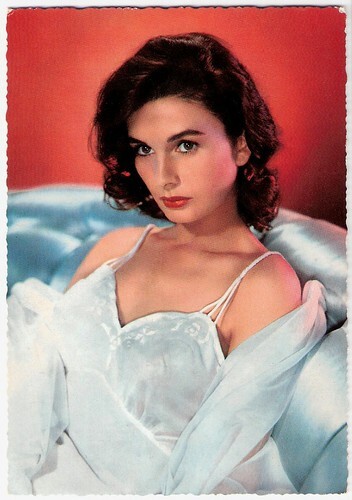
German postcard by Krüger / Ufa, no. 902/144. Photo: Terb Agency / Ufa.
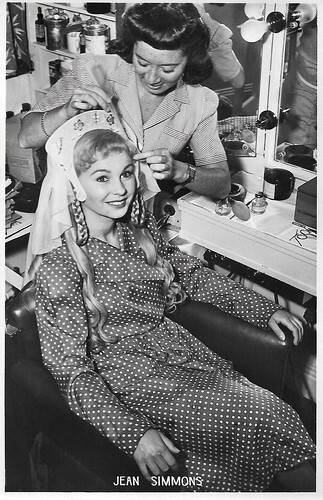
British postcard by Rotary Photographic Company, London, no. F.S. 6. Jean Simmons on the set of Hamlet (Laurence Olivier, 1948). Caption: This happy shot of Jeran Simmons was taken at Denham Studios during the filming of "Hamlet." Vivienne Walker, the chief hairdresser, is busy fixing Miss Simmons hair neatly under her Ophelia cap.
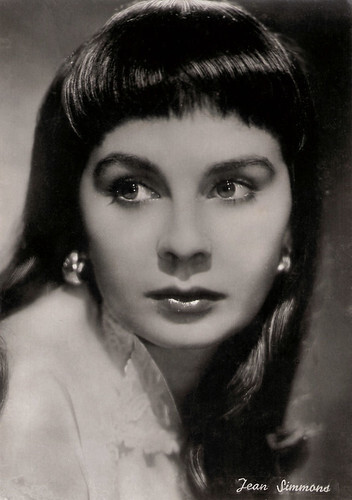
Italian postcard by Bromofoto, Milano, no. 266. Jean Simmons in The Clouded Yellow (Ralph Thomas, 1950).
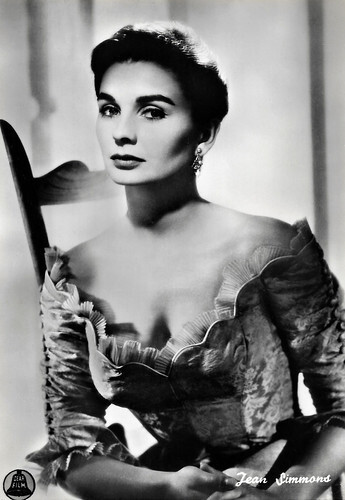
Italian postcard by Bromofoto, Milano, no. 1385. Photo: Dear Film.
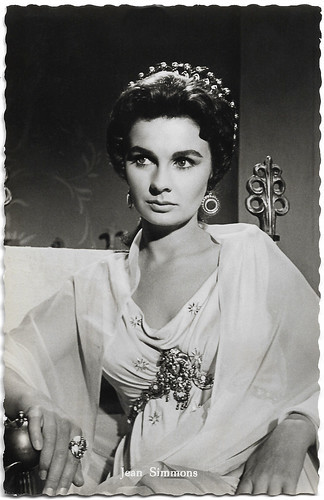
Dutch postcard, no. 860. Photo: Universal-Film. Jean Simmons in Spartacus (Stanley Kubrick, 1960). Collection: Geoffrey Donaldson Institute.
Revered and Beloved
Jean Merilyn Simmons was born in London, England in 1929. Her father, a schoolteacher, helped Jean to start in a dancing school. Two weeks later the school was visited by producer Val Guest, who was looking for a ‘fresh face’ to play Margaret Lockwood 's precocious sister in Give Us the Moon (Val Guest, 1944). He had found her.
Jean went on to make a name for herself in such major British productions as the G.B. Shaw adaptation Caesar and Cleopatra (Gabriel Pascal, 1945), as the pretty, seductive, and mischievous Estella in Great Expectations (David Lean, 1946), and as a sultry native beauty with a nosering in Black Narcissus (Michael Powell, Emeric Pressburger, 1947).
The followed roles in the original version of The Blue Lagoon (Frank Launder, 1949), and the thriller So Long at the Fair (Antony Darnborough, Terence Fisher, 1950) co-starring Dirk Bogarde .
For her role as Ophelia in Laurence Olivier ’s adaptation of William Shakespeare's Hamlet (Laurence Olivier, 1948), she earned a Best Supporting Actress Oscar nomination. Jean Simmons was revered and beloved by both British critics and filmgoers.
By the end of 1950, she was the #4 box office attraction, American or British, in British cinema. Only 20 and seemingly on top of the world, Jean soon had her own flat in London and the luxuries that stardom brings.
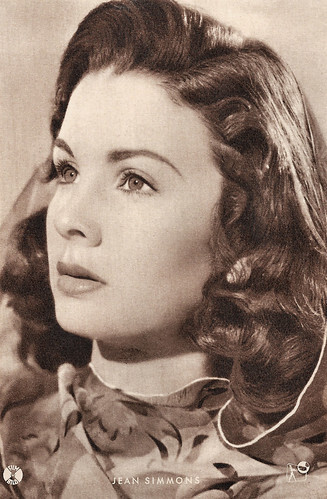
West-German postcard by Film und Bild, Frankfurt-Main. Photo: Rank. Caption: Real copper gravure.
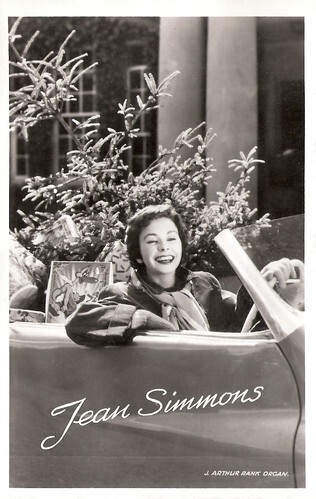
Dutch postcard by Uitg. Takken, Utrecht. Photo: J. Arthur Rank Organ.
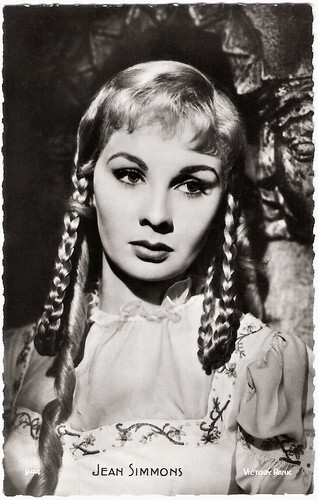
French postcard by Editions P.I., Paris, no. 244. Photo: Victory Rank.
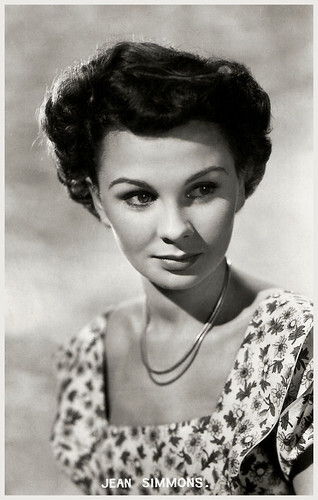
British Real Photograph postcard, no. F. S. 36.
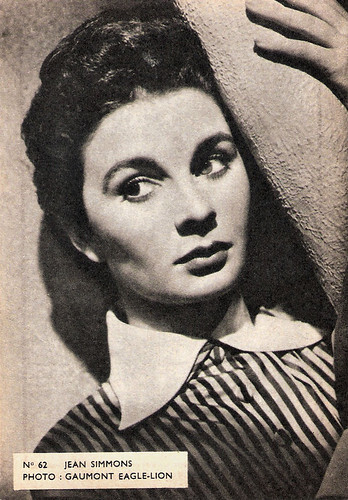
Belgian 'Chromo' collectors card postcard by Merbotex for Ciné British-Palace, Temse, Serie B, no. 62. Photo: Gaumont Eagle-Lion.
Legal Battle
In 1950, Jean Simmons married actor Stewart Granger , 16 years her senior. They had met when she played his adopted daughter in the romantic comedy Adam and Evelyne (Harold French, 1949). Together they made the transition to Hollywood.
Granger was under contract to Metro-Goldwyn-Mayer and would play Allan Quartermain, the Prisoner of Zenda and Scaramouche. The 21-years old Simmons found out that RKO head Howard Hughes had purchased the remaining six months of her Rank Studio contract. When Hughes claimed that an oral agreement with Rank precluded her from being loaned out to any other studio, she sued RKO.
The legal battle raged for over a year. When the suit was finally settled, RKO had a three-year contract for Jean's services but was obligated to pay her $250,000 in addition to her legal fees. Furthermore, she won the right to work on loan to other studios at a substantial salary.
David Thomson writes in his 2010-obituary in the Guardian: "The strange tycoon was obsessed with her personally, and he laid siege to her romantically and professionally so that she did not work for over a year. Only one thing emerged from the stand-off, Angel Face, in which she is a spoiled child and lethal temptress who seduces nearly everyone she meets (most notably Robert Mitchum ).
The brilliant picture was directed by Otto Preminger and photographed by the great veteran Harry Stradling. Thus it contains – and she sustains – some of the most luminous close-ups ever given to a femme fatale. How far she understood the picture is unclear. One can only say that it is a rare tribute to unrequited love."
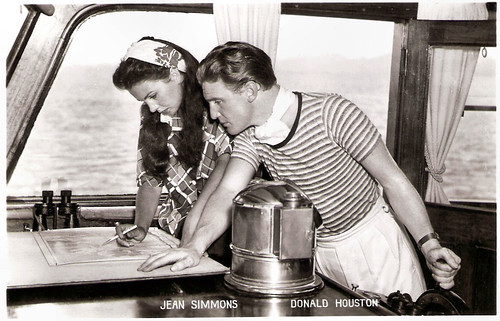
British ReaL Photograph postcard, no. F.S. 32. Caption: Jean Simmons plots their position while Donald Huston keeps the "Royal Flight" on her course during location work on The Blue Lagoon in which they both star. N.B. Donald Houston is sometimes also written as Donald Huston.
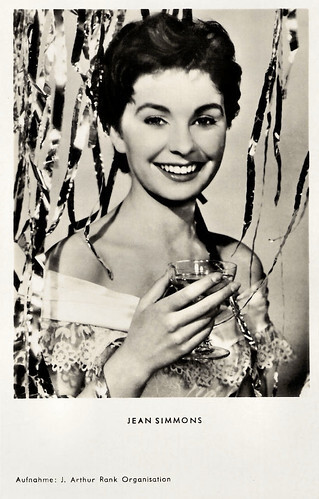
West-German postcard by Kunst und Bild, Berlin, no. A 140. Photo: J. Arthur Rank Organisation.
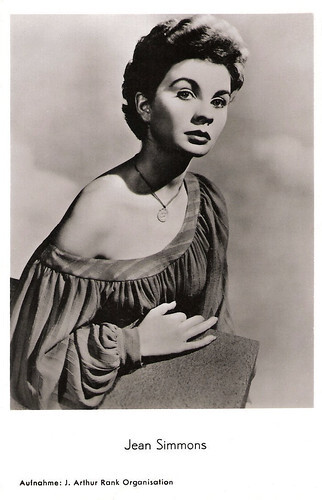
German postcard by F.J. Rüdel Filmpostkartenverlag, Hamburg-Bergedorf, no. 115. Photo: J. Arthur Rank Organisation.
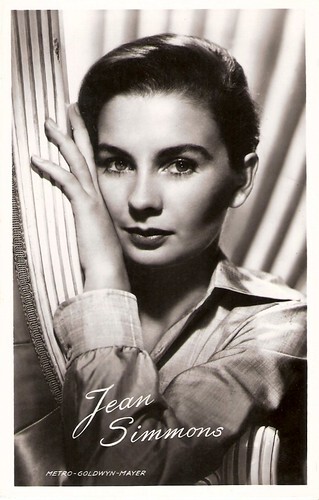
Dutch postcard by Uitg. Takken, Utrecht. Photo: Metro-Goldwyn-Mayer.
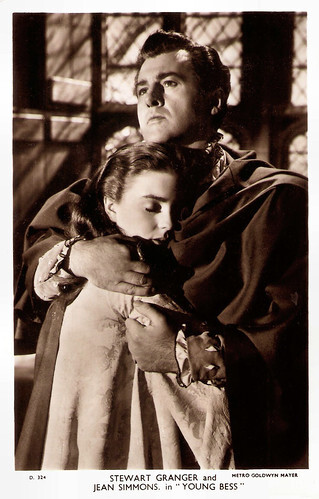
British postcard in the Picturegoer series, no. D. 324. Photo: Metro Goldwyn Mayer (MGM). Stewart Granger and Jean Simmons in Young Bess (George Sidney, 1953).
Film Noir
Among Jean Simmons' best-known Hollywood films are the biblical epic The Robe (Henry Koster, 1953) with Richard Burton , The Egyptian (Michael Curtiz, 1954) with Victor Mature , and The Big Country (William Wyler, 1958) with Gregory Peck.
She also starred in the Frank Sinatra / Marlon Brando musical Guys and Dolls (Joseph L. Mankiewicz, 1955). She used her own singing voice and earned her first Golden Globe Award.
Simmons divorced Granger in 1960 and almost immediately after married writer-director Richard Brooks, who cast her as Sister Sharon opposite Burt Lancaster in Elmer Gantry (1960), a memorable adaptation of the Sinclair Lewis novel.
That same year she co-starred with Kirk Douglas in Stanley Kubrick's Spartacus (1960) and played a would-be homewrecker opposite Cary Grant in The Grass Is Greener (Stanley Donen, 1960).
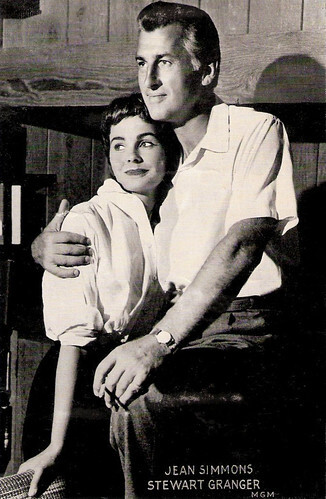
Vintage postcard. Photo: MGM. With husband Stewart Granger.
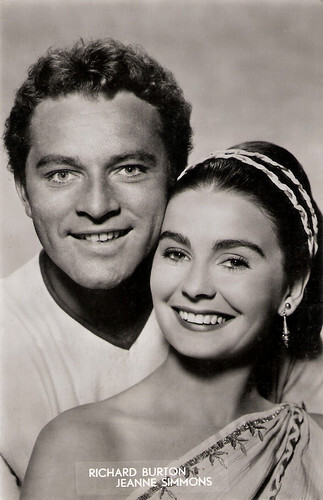
French postcard. Richard Burton and Jean Simmons in The Robe (Henry Koster, 1953). There may have been a fling with Richard Burton, suggests David Thomson in his obituary in The Guardian.
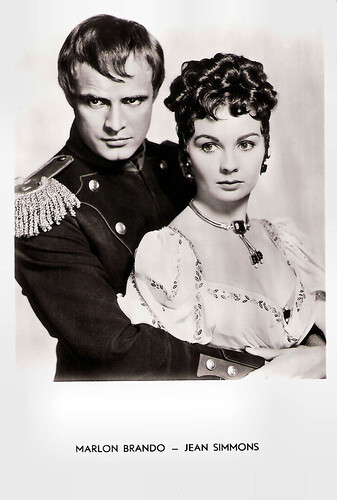
Belgian postcard, no. 348. Photo: Marlon Brando and Jean Simmons in Désirée (Henry Koster, 1954).
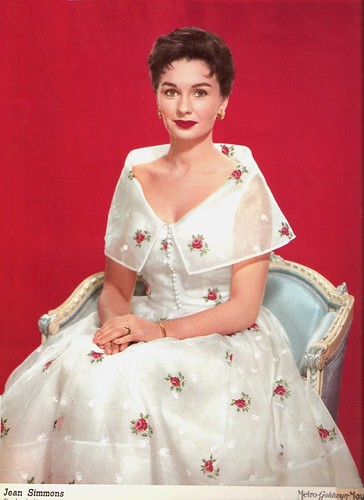
Vintage postcard. Photo: Metro-Goldwyn-Mayer.
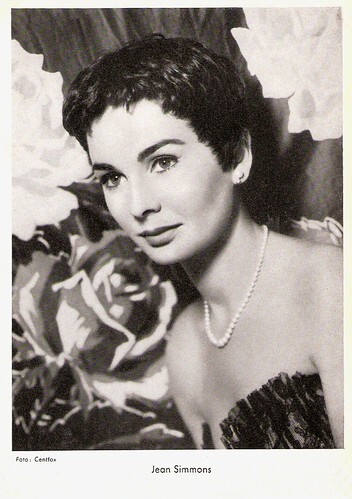
Collectors card. Photo: Centfox.
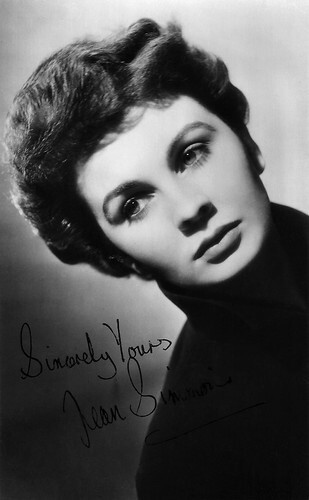
British autograph card.
Depressed
Off the screen for a few years, Jean Simmons captivated moviegoers with a brilliant performance as the mother in All the Way Home (Alex Segal, 1963), a literate, tasteful adaptation of James Agee's A Death in the Family.
After that, however, she found quality projects somewhat harder to come by and took work in Life at the Top (Ted Kotcheff, 1965), Divorce American Style (Bud Yorkin, 1967), and The Happy Ending (Richard Brooks, 1969) for which she was again Oscar-nominated, this time as Best Actress.
By the 1970s, she turned her focus to stage and television acting. In the theatre, she appeared most notably as Desiree in the London premiere of Stephen Sondheim's 'A Little Night Music' (1974) and she headlined the American national tour as well. She and Richard Brooks divorced in 1977.
In the 1980s she mainly appeared in TV Mini-series, such as The Thorn Birds (Daryl Duke, 1983) for which she won an Emmy Award, and North and South (Richard T. Heffron, 1985). Becoming depressed at the lack of quality parts being offered her, Jean became addicted to alcohol. In 1986, she sought professional treatment.
Jean made a comeback in the cinemas in How to Make an American Quilt (Jocelyn Moorehouse, 1995), co-starring with Winona Ryder and Anne Bancroft. More recently she gave her voice to the elderly Sophie in the English version of the beautiful animation film Hauru no ugoku shiro/Howl’s Moving Castle (Hayao Miyazaki, 2004).
Her last film was Shadows in the Sun (David Rocksavage, 2009) with James Wilby in which she was deeply touching as a dying poet. In 2003 she was made an OBE (Officer of the Order of the British Empire) for services to acting. Jean Simmons lived as a naturalized U.S. citizen in California, where she had been for the last fifty years.
Jean Simmons passed away in 2010, at the age of 80. She had two children: a daughter with Stewart Granger, Tracy Granger, and a daughter with Richard Brooks, Kate Brooks.
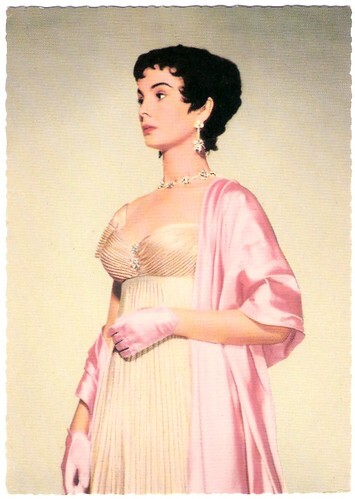
German postcard by ISV, no. A 26. Photo: 20th Century Fox. Jean Simmons in Desiree (Henry Koster, 1954).
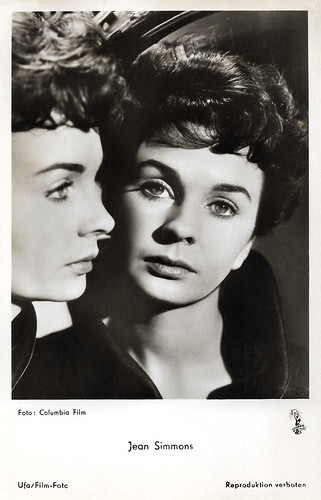
West-German postcard by Ufa/Film-Foto, Berlin-Tempelhof, no. FK 3607. Photo: Columbia Film.
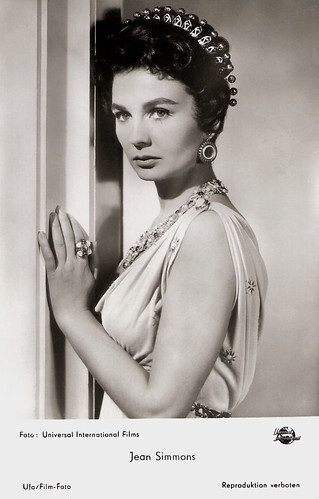
West-German postcard by Ufa/Film-Foto, Berlin-Tempelhof, no. FK 4978. Photo: Universal International Films. Jean Simmons in Spartacus (Stanley Kubrick, 1960).
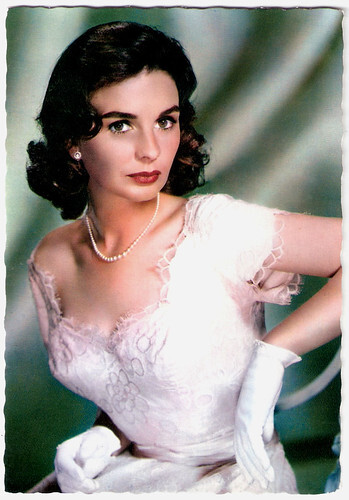
French postcard, no. 115.
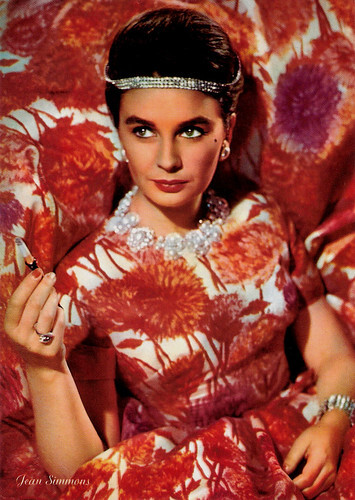
Italian postcard in the Artisti di sempre series by Edit. ris. Rotalfoto S.p.A., Milano, no 298. Jean Simmons in The Grass Is Greener (Stanley Donen, 1960).
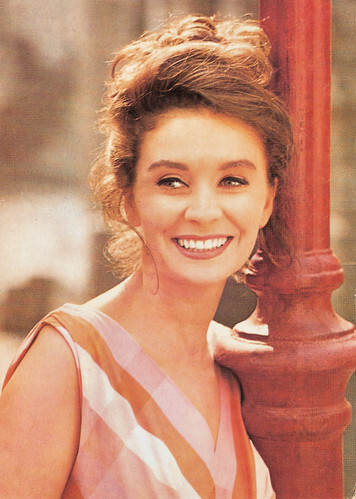
Romanian postcard by Casa Filmului Acin.
Sources: David Thomson (The Guardian), (IMDb), Wikipedia, and .

German postcard by Krüger / Ufa, no. 902/144. Photo: Terb Agency / Ufa.

British postcard by Rotary Photographic Company, London, no. F.S. 6. Jean Simmons on the set of Hamlet (Laurence Olivier, 1948). Caption: This happy shot of Jeran Simmons was taken at Denham Studios during the filming of "Hamlet." Vivienne Walker, the chief hairdresser, is busy fixing Miss Simmons hair neatly under her Ophelia cap.

Italian postcard by Bromofoto, Milano, no. 266. Jean Simmons in The Clouded Yellow (Ralph Thomas, 1950).

Italian postcard by Bromofoto, Milano, no. 1385. Photo: Dear Film.

Dutch postcard, no. 860. Photo: Universal-Film. Jean Simmons in Spartacus (Stanley Kubrick, 1960). Collection: Geoffrey Donaldson Institute.
Revered and Beloved
Jean Merilyn Simmons was born in London, England in 1929. Her father, a schoolteacher, helped Jean to start in a dancing school. Two weeks later the school was visited by producer Val Guest, who was looking for a ‘fresh face’ to play Margaret Lockwood 's precocious sister in Give Us the Moon (Val Guest, 1944). He had found her.
Jean went on to make a name for herself in such major British productions as the G.B. Shaw adaptation Caesar and Cleopatra (Gabriel Pascal, 1945), as the pretty, seductive, and mischievous Estella in Great Expectations (David Lean, 1946), and as a sultry native beauty with a nosering in Black Narcissus (Michael Powell, Emeric Pressburger, 1947).
The followed roles in the original version of The Blue Lagoon (Frank Launder, 1949), and the thriller So Long at the Fair (Antony Darnborough, Terence Fisher, 1950) co-starring Dirk Bogarde .
For her role as Ophelia in Laurence Olivier ’s adaptation of William Shakespeare's Hamlet (Laurence Olivier, 1948), she earned a Best Supporting Actress Oscar nomination. Jean Simmons was revered and beloved by both British critics and filmgoers.
By the end of 1950, she was the #4 box office attraction, American or British, in British cinema. Only 20 and seemingly on top of the world, Jean soon had her own flat in London and the luxuries that stardom brings.

West-German postcard by Film und Bild, Frankfurt-Main. Photo: Rank. Caption: Real copper gravure.

Dutch postcard by Uitg. Takken, Utrecht. Photo: J. Arthur Rank Organ.

French postcard by Editions P.I., Paris, no. 244. Photo: Victory Rank.

British Real Photograph postcard, no. F. S. 36.

Belgian 'Chromo' collectors card postcard by Merbotex for Ciné British-Palace, Temse, Serie B, no. 62. Photo: Gaumont Eagle-Lion.
Legal Battle
In 1950, Jean Simmons married actor Stewart Granger , 16 years her senior. They had met when she played his adopted daughter in the romantic comedy Adam and Evelyne (Harold French, 1949). Together they made the transition to Hollywood.
Granger was under contract to Metro-Goldwyn-Mayer and would play Allan Quartermain, the Prisoner of Zenda and Scaramouche. The 21-years old Simmons found out that RKO head Howard Hughes had purchased the remaining six months of her Rank Studio contract. When Hughes claimed that an oral agreement with Rank precluded her from being loaned out to any other studio, she sued RKO.
The legal battle raged for over a year. When the suit was finally settled, RKO had a three-year contract for Jean's services but was obligated to pay her $250,000 in addition to her legal fees. Furthermore, she won the right to work on loan to other studios at a substantial salary.
David Thomson writes in his 2010-obituary in the Guardian: "The strange tycoon was obsessed with her personally, and he laid siege to her romantically and professionally so that she did not work for over a year. Only one thing emerged from the stand-off, Angel Face, in which she is a spoiled child and lethal temptress who seduces nearly everyone she meets (most notably Robert Mitchum ).
The brilliant picture was directed by Otto Preminger and photographed by the great veteran Harry Stradling. Thus it contains – and she sustains – some of the most luminous close-ups ever given to a femme fatale. How far she understood the picture is unclear. One can only say that it is a rare tribute to unrequited love."

British ReaL Photograph postcard, no. F.S. 32. Caption: Jean Simmons plots their position while Donald Huston keeps the "Royal Flight" on her course during location work on The Blue Lagoon in which they both star. N.B. Donald Houston is sometimes also written as Donald Huston.

West-German postcard by Kunst und Bild, Berlin, no. A 140. Photo: J. Arthur Rank Organisation.

German postcard by F.J. Rüdel Filmpostkartenverlag, Hamburg-Bergedorf, no. 115. Photo: J. Arthur Rank Organisation.

Dutch postcard by Uitg. Takken, Utrecht. Photo: Metro-Goldwyn-Mayer.

British postcard in the Picturegoer series, no. D. 324. Photo: Metro Goldwyn Mayer (MGM). Stewart Granger and Jean Simmons in Young Bess (George Sidney, 1953).
Film Noir
Among Jean Simmons' best-known Hollywood films are the biblical epic The Robe (Henry Koster, 1953) with Richard Burton , The Egyptian (Michael Curtiz, 1954) with Victor Mature , and The Big Country (William Wyler, 1958) with Gregory Peck.
She also starred in the Frank Sinatra / Marlon Brando musical Guys and Dolls (Joseph L. Mankiewicz, 1955). She used her own singing voice and earned her first Golden Globe Award.
Simmons divorced Granger in 1960 and almost immediately after married writer-director Richard Brooks, who cast her as Sister Sharon opposite Burt Lancaster in Elmer Gantry (1960), a memorable adaptation of the Sinclair Lewis novel.
That same year she co-starred with Kirk Douglas in Stanley Kubrick's Spartacus (1960) and played a would-be homewrecker opposite Cary Grant in The Grass Is Greener (Stanley Donen, 1960).

Vintage postcard. Photo: MGM. With husband Stewart Granger.

French postcard. Richard Burton and Jean Simmons in The Robe (Henry Koster, 1953). There may have been a fling with Richard Burton, suggests David Thomson in his obituary in The Guardian.

Belgian postcard, no. 348. Photo: Marlon Brando and Jean Simmons in Désirée (Henry Koster, 1954).

Vintage postcard. Photo: Metro-Goldwyn-Mayer.

Collectors card. Photo: Centfox.

British autograph card.
Depressed
Off the screen for a few years, Jean Simmons captivated moviegoers with a brilliant performance as the mother in All the Way Home (Alex Segal, 1963), a literate, tasteful adaptation of James Agee's A Death in the Family.
After that, however, she found quality projects somewhat harder to come by and took work in Life at the Top (Ted Kotcheff, 1965), Divorce American Style (Bud Yorkin, 1967), and The Happy Ending (Richard Brooks, 1969) for which she was again Oscar-nominated, this time as Best Actress.
By the 1970s, she turned her focus to stage and television acting. In the theatre, she appeared most notably as Desiree in the London premiere of Stephen Sondheim's 'A Little Night Music' (1974) and she headlined the American national tour as well. She and Richard Brooks divorced in 1977.
In the 1980s she mainly appeared in TV Mini-series, such as The Thorn Birds (Daryl Duke, 1983) for which she won an Emmy Award, and North and South (Richard T. Heffron, 1985). Becoming depressed at the lack of quality parts being offered her, Jean became addicted to alcohol. In 1986, she sought professional treatment.
Jean made a comeback in the cinemas in How to Make an American Quilt (Jocelyn Moorehouse, 1995), co-starring with Winona Ryder and Anne Bancroft. More recently she gave her voice to the elderly Sophie in the English version of the beautiful animation film Hauru no ugoku shiro/Howl’s Moving Castle (Hayao Miyazaki, 2004).
Her last film was Shadows in the Sun (David Rocksavage, 2009) with James Wilby in which she was deeply touching as a dying poet. In 2003 she was made an OBE (Officer of the Order of the British Empire) for services to acting. Jean Simmons lived as a naturalized U.S. citizen in California, where she had been for the last fifty years.
Jean Simmons passed away in 2010, at the age of 80. She had two children: a daughter with Stewart Granger, Tracy Granger, and a daughter with Richard Brooks, Kate Brooks.

German postcard by ISV, no. A 26. Photo: 20th Century Fox. Jean Simmons in Desiree (Henry Koster, 1954).

West-German postcard by Ufa/Film-Foto, Berlin-Tempelhof, no. FK 3607. Photo: Columbia Film.

West-German postcard by Ufa/Film-Foto, Berlin-Tempelhof, no. FK 4978. Photo: Universal International Films. Jean Simmons in Spartacus (Stanley Kubrick, 1960).

French postcard, no. 115.

Italian postcard in the Artisti di sempre series by Edit. ris. Rotalfoto S.p.A., Milano, no 298. Jean Simmons in The Grass Is Greener (Stanley Donen, 1960).

Romanian postcard by Casa Filmului Acin.
Sources: David Thomson (The Guardian), (IMDb), Wikipedia, and .
Published on February 14, 2022 22:00
February 13, 2022
La Collectionneuse: Valentine's Day
Let’s celebrate Valentine’s Day with a selection of 14 postcards featuring film couples. So, be ready for love, romance, and passion.
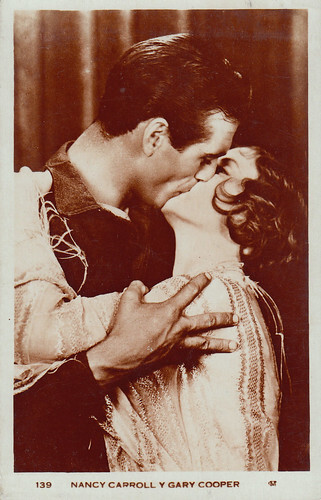
Spanish postcard by MC, Barcelona, no. 139. Nancy Carroll and Gary Cooper in The Shopworn Angel (Richard Wallace, 1928).
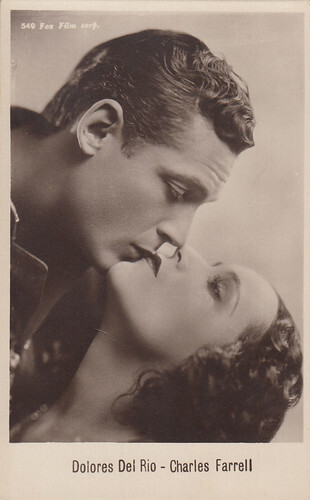
Italian postcard by G.B. Falci Editore, Milano, no. 549. Photo: Fox Film Corp. Dolores del Rio and Charles Farrell in The Red Dance (Raoul Walsh, 1928).
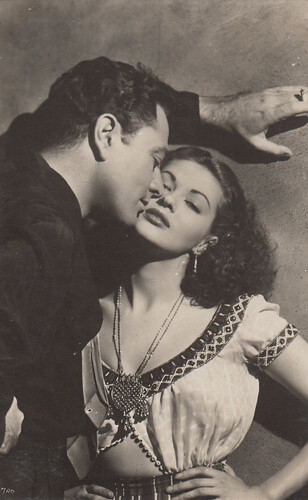
Spanish postcard, no. 4200. Yvonne De Carlo and Tony Martin in Casbah (John Berry, 1948).
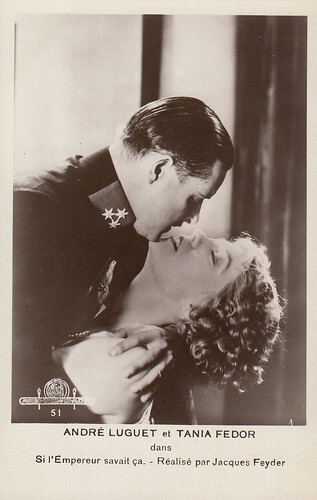
Belgian postcard by P.I.A. Belgaphot, Bruxelles, no. 51. Photo: Metro-Goldwyn-Mayer. Tania Fédor and André Luguet in Si l’empereur savait ça/His Glorious Night (Jacques Feyder, 1930).
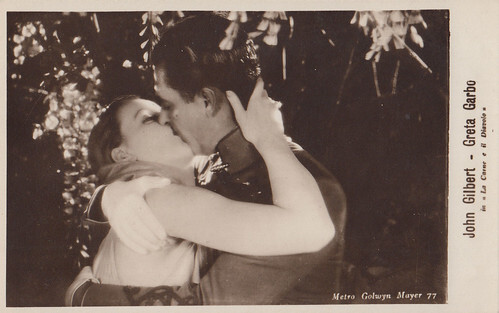
Italian postcard by G.B. Falci Editore, Milano, no. 77. Photo: Metro Goldwyn Mayer (MGM). Greta Garbo and John Gilbert in Flesh and the Devil (Clarence Brown, 1926).
Together again in Love
Casbah (John Berry, 1948) was a remake of Algiers (1938), which was itself a remake of the French film Pépé le Moko (1937). Yvonne De Carlo succeeded Line Noro and Sigrid Gurie and Tony Martin succeeded Jean Gabin and Charles Boyer .
Si l’empereur savait ça (Jacques Feyder, 1930) is the French-language version of His Glorious Night (1929) starring Catherine Dale Owen and John Gilbert . There were also a Spanish-language version, Olimpia, with Maria Alba and José Crespo, and a German-language version, Olympia, with Nora Gregor and Theo Shall.
Greta Garbo and John Gilbert co-starred for the first time in Flesh and the Devil (Clarence Brown, 1926). They fell in love during filming and this is obvious in their incandescent love scenes, as you can see on this postcard. They appeared together again in Love (1927) and A Woman of Affairs (1928). However, their affair was over by 1929. In 1933, they made a last film together, Queen Christina, but, at the time, John Gilbert ’s career was in decline.
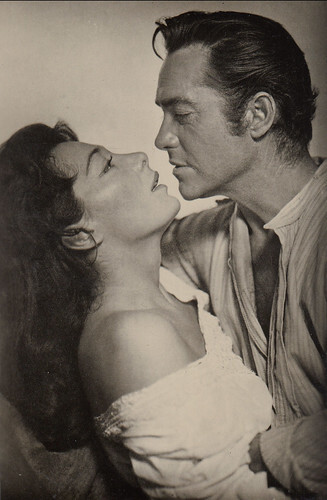
Spanish postcard by Ediciones JRB, no. 204/1. Juliette Gréco and Richard Todd in The Naked Earth (Vincent Sherman, 1958).
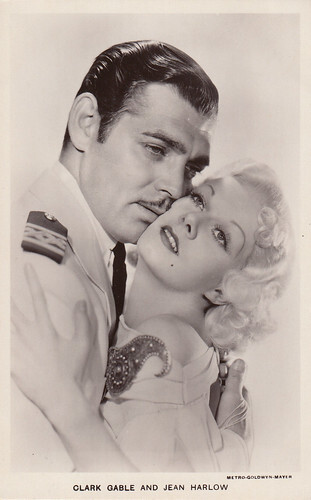
Dutch postcard by M. Bonnist & Zonen, Amsterdam, no. B 447. Photo: M.G.M. Jean Harlow and Clark Gable in China Seas (Tay Garnett, 1935).
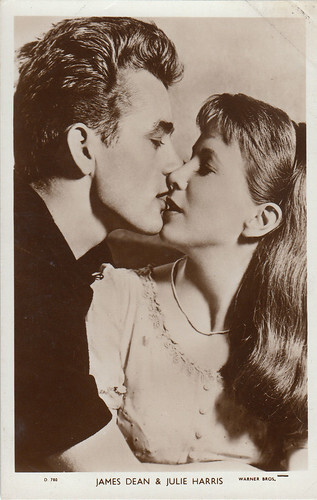
British postcard in the Picturegoer Series, no. D 780. Photo: Warner Bros. Julie Harris and James Dean in East of Eden (Elia Kazan, 1955).
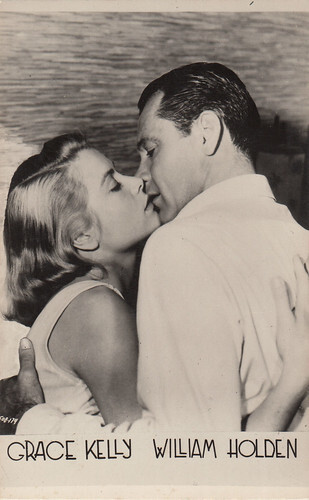
Italian postcard by Grafica Fotocolor, Roma. Grace Kelly and William Holden in The Bridges at Toko-Ri (Mark Robson, 1954).
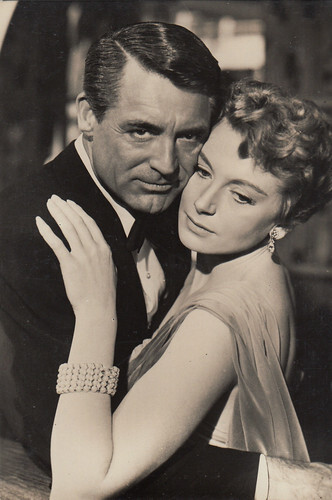
Spanish postcard by Ediciones JRB, no. 178/1. Cary Grant and Deborah Kerr in An Affair to Remember (Leo McCarey, 1957).
Great screen chemistry
China Seas (Tay Garnett, 1935) was Harlow and Gable’s third co-starring movie after they had been teamed together in Red Dust (1932) and Hold Your Man (1933). Wife versus Secretary (1936) and Saratoga (1937), which was Harlow’s last movie appearance, followed. The two stars genuinely liked each other and had great screen chemistry. They had met for the first time on the set of The Secret Six (1931), in which Gable had a secondary role.
Several years ago, An Affair to Remember (Leo McCarey, 1957) was ranked fifth in the American Film Institute’s list of 'The Greatest Love Stories of All Time'. It was the remake of Love Affair (1939) with Irene Dunne and Charles Boyer .
From 1934 to 1947, Myrna Loy co-starred with William Powell 13 times and they formed together a perfect cinematographic couple. They got along very well and only had praise for each other.
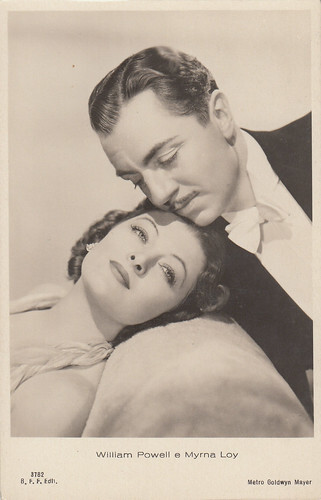
Italian postcard by Ballerini & Fratini, Firenze, no. 3782. Photo: Metro Goldwyn Mayer. Myrna Loy and William Powell.
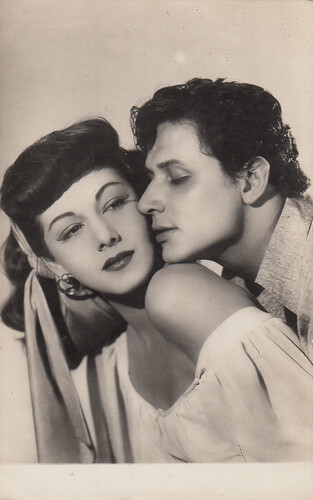
Spanish postcard by C.M.B, no. 56. Maria Montez and Peter Coe in Gypsy Wildcat (Roy William Neill, 1944).
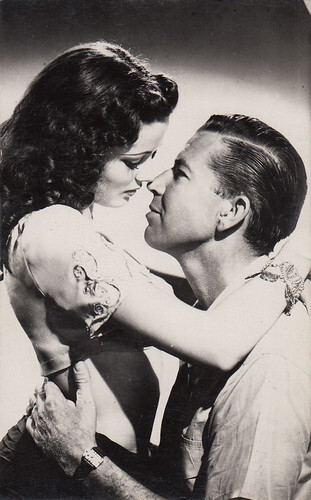
Spanish postcard, no. 625. Gene Tierney and Bruce Cabot in Sundown (Henry Hathaway, 1941).
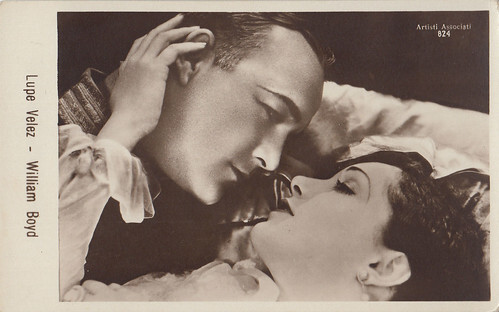
Italian postcard by G.B. Falci - Editore, Milano, no. 824. Photo: United Artists (Artisti Associati). Lupe Velez and William Boyd in Lady of the Pavements (D.W. Griffith, 1929).
Text and postcards: Marlene Pilaete a.k.a. La Collectionneuse.

Spanish postcard by MC, Barcelona, no. 139. Nancy Carroll and Gary Cooper in The Shopworn Angel (Richard Wallace, 1928).

Italian postcard by G.B. Falci Editore, Milano, no. 549. Photo: Fox Film Corp. Dolores del Rio and Charles Farrell in The Red Dance (Raoul Walsh, 1928).

Spanish postcard, no. 4200. Yvonne De Carlo and Tony Martin in Casbah (John Berry, 1948).

Belgian postcard by P.I.A. Belgaphot, Bruxelles, no. 51. Photo: Metro-Goldwyn-Mayer. Tania Fédor and André Luguet in Si l’empereur savait ça/His Glorious Night (Jacques Feyder, 1930).

Italian postcard by G.B. Falci Editore, Milano, no. 77. Photo: Metro Goldwyn Mayer (MGM). Greta Garbo and John Gilbert in Flesh and the Devil (Clarence Brown, 1926).
Together again in Love
Casbah (John Berry, 1948) was a remake of Algiers (1938), which was itself a remake of the French film Pépé le Moko (1937). Yvonne De Carlo succeeded Line Noro and Sigrid Gurie and Tony Martin succeeded Jean Gabin and Charles Boyer .
Si l’empereur savait ça (Jacques Feyder, 1930) is the French-language version of His Glorious Night (1929) starring Catherine Dale Owen and John Gilbert . There were also a Spanish-language version, Olimpia, with Maria Alba and José Crespo, and a German-language version, Olympia, with Nora Gregor and Theo Shall.
Greta Garbo and John Gilbert co-starred for the first time in Flesh and the Devil (Clarence Brown, 1926). They fell in love during filming and this is obvious in their incandescent love scenes, as you can see on this postcard. They appeared together again in Love (1927) and A Woman of Affairs (1928). However, their affair was over by 1929. In 1933, they made a last film together, Queen Christina, but, at the time, John Gilbert ’s career was in decline.

Spanish postcard by Ediciones JRB, no. 204/1. Juliette Gréco and Richard Todd in The Naked Earth (Vincent Sherman, 1958).

Dutch postcard by M. Bonnist & Zonen, Amsterdam, no. B 447. Photo: M.G.M. Jean Harlow and Clark Gable in China Seas (Tay Garnett, 1935).

British postcard in the Picturegoer Series, no. D 780. Photo: Warner Bros. Julie Harris and James Dean in East of Eden (Elia Kazan, 1955).

Italian postcard by Grafica Fotocolor, Roma. Grace Kelly and William Holden in The Bridges at Toko-Ri (Mark Robson, 1954).

Spanish postcard by Ediciones JRB, no. 178/1. Cary Grant and Deborah Kerr in An Affair to Remember (Leo McCarey, 1957).
Great screen chemistry
China Seas (Tay Garnett, 1935) was Harlow and Gable’s third co-starring movie after they had been teamed together in Red Dust (1932) and Hold Your Man (1933). Wife versus Secretary (1936) and Saratoga (1937), which was Harlow’s last movie appearance, followed. The two stars genuinely liked each other and had great screen chemistry. They had met for the first time on the set of The Secret Six (1931), in which Gable had a secondary role.
Several years ago, An Affair to Remember (Leo McCarey, 1957) was ranked fifth in the American Film Institute’s list of 'The Greatest Love Stories of All Time'. It was the remake of Love Affair (1939) with Irene Dunne and Charles Boyer .
From 1934 to 1947, Myrna Loy co-starred with William Powell 13 times and they formed together a perfect cinematographic couple. They got along very well and only had praise for each other.

Italian postcard by Ballerini & Fratini, Firenze, no. 3782. Photo: Metro Goldwyn Mayer. Myrna Loy and William Powell.

Spanish postcard by C.M.B, no. 56. Maria Montez and Peter Coe in Gypsy Wildcat (Roy William Neill, 1944).

Spanish postcard, no. 625. Gene Tierney and Bruce Cabot in Sundown (Henry Hathaway, 1941).

Italian postcard by G.B. Falci - Editore, Milano, no. 824. Photo: United Artists (Artisti Associati). Lupe Velez and William Boyd in Lady of the Pavements (D.W. Griffith, 1929).
Text and postcards: Marlene Pilaete a.k.a. La Collectionneuse.
Published on February 13, 2022 22:00
February 12, 2022
Sonis
For more than 50 years, the French Edition Sonis delivers cinema services, supporting distributors and exhibitors. Today, Sonis is active on 5 poles of competence essential to the promotion of films, mainly Hollywood blockbusters, before their release in theatres: from digital communication to printing, including events, management, and logistics. Printing includes posters and postcards, and through the decades, the design of the Sonis postcards became more and more an in-between of the old poster design and that of the traditional star postcards. Sonis has two branches, one in the Paris suburbs (Les Ulis) and the other in the Lyon suburbs (Décines).
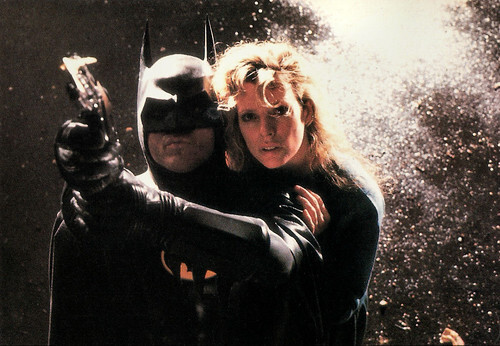
French postcard by Sonis, no. C 62. Photo: Warner Bros inc. Michael Keaton and Kim Basinger in Batman (Tim Burton, 1989).
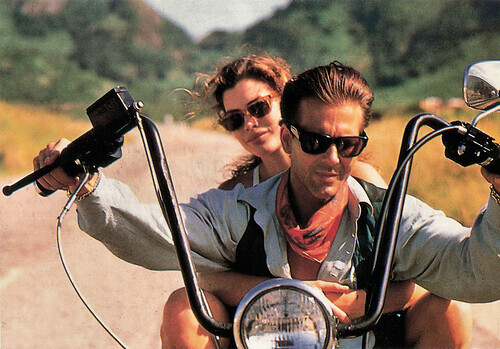
French postcard by Sonis, no. C. 109. Photo: Deal. Mickey Rourke and Carré Otis in Wild Orchid (Zalman King, 1989).

French postcard by Sonis, no. C. 129. Photo: Carolco International NV. Arnold Schwarzenegger in Total Recall (Paul Verhoeven, 1990).
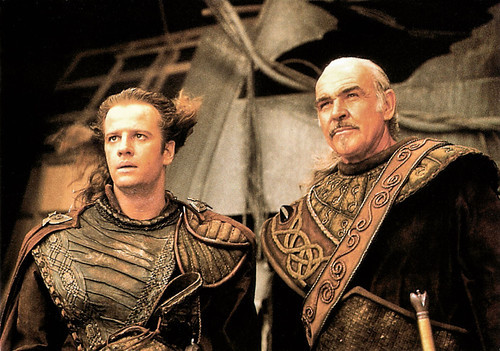
French postcard by Sonis, no. C. 160. Photo: Christophe Lambert and Sean Connery in Highlander II: The Quickening (Russell Mulcahy, 1991).
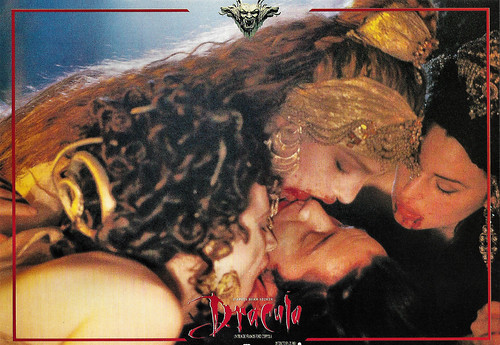
French postcard by Sonis, no. C. 322. Photo: Columbia Pictures. Keanu Reeves , Michaela Bercu, Monica Bellucci, and Florina Kendrick in Dracula (Francis Coppola, 1992).
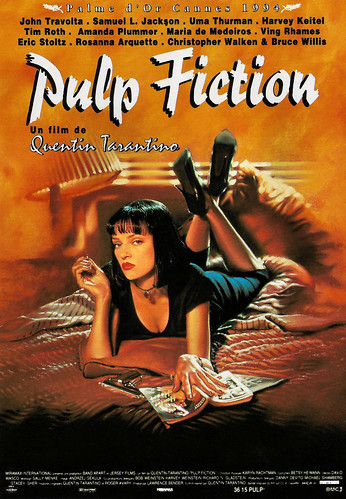
French postcard by Sonis, no. C. 492. Photo: Bac Films. Uma Thurman on the French poster for Pulp Fiction (Quentin Tarantino, 1994). Caption: Affiche du film.
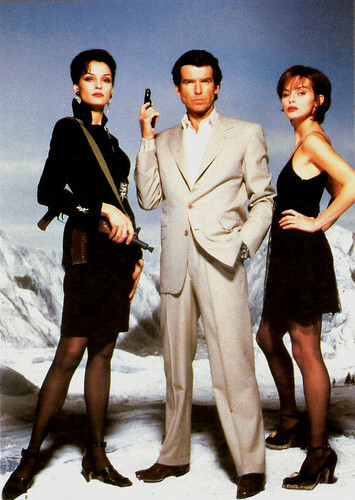
French postcard by Sonis, no. C. 609. Photo: Danjaq and United Artists Corporation. Photo: Famke Jansen, Pierce Brosnan, and Isabella Scoruppo in Goldeneye (Martin Campbell, 1995).

French postcard by Sonis, no. C. 620. Image: Pixar / Disney / Hasbro / Mattel / James Industries. Film poster for Toy Story (John Lasseter, 1995).
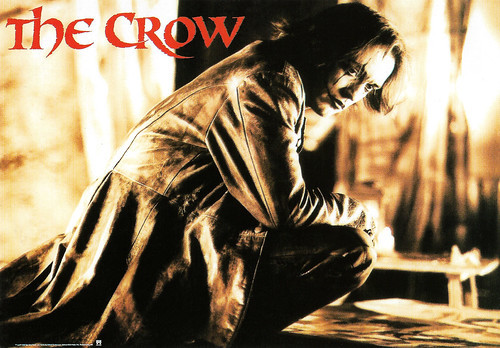
French postcard by Sonis, no. C. 709. Photo: TM and Bad Bird Productions Inc., 1996. Brandon Lee in The Crow (Alex Proyas, 1994).
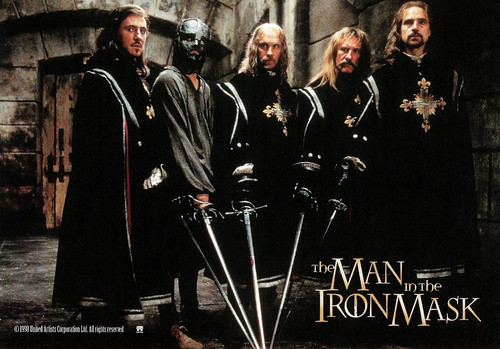
French postcard by Sonis, no. C. 854. Photo: United Artists. Gabriel Byrne, Leonardo DiCaprio , John Malkovich, Gérard Depardieu, and Jeremy Irons in The Man in the Iron Mask (Randall Wallace, 1998).
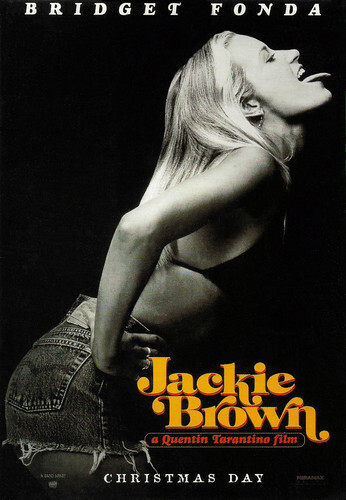
French postcard by Sonis, no. C 867. Photo: Miramax / A Band Apart / BAC Films. Bridget Fonda as Melanie Ralston in Jackie Brown (Quentin Tarantino, 1997). Caption: Christmas Day.
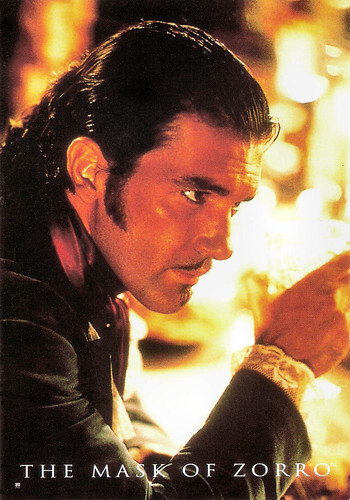
French postcard by Sonis, no. C. 899. Photo: Zorro Productions / Tristar Pictures. Antonio Banderas in The Mask of Zorro (Martin Campbell, 1998).
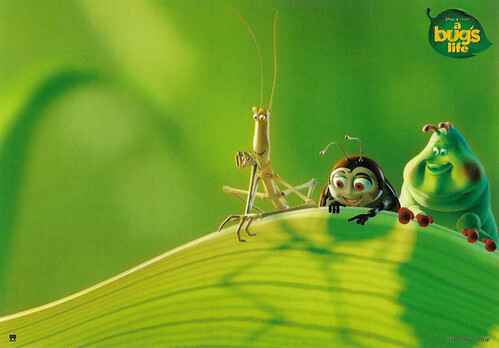
French postcard by Sonis, no. C. 941. Image: Disney / Pixar. Film image for A Bug's Life (John Lasseter, 1998). Sent by mail in 1999.
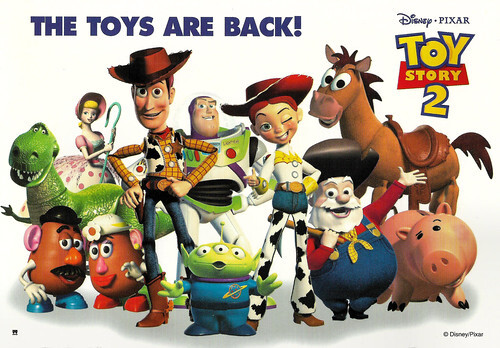
French postcard by Sonis, no. C. 1119. Image: Disney / Pixar. Film image for Toy Story 2 (John Lasseter, Lee Unkrich, Ash Brannon, 1999).
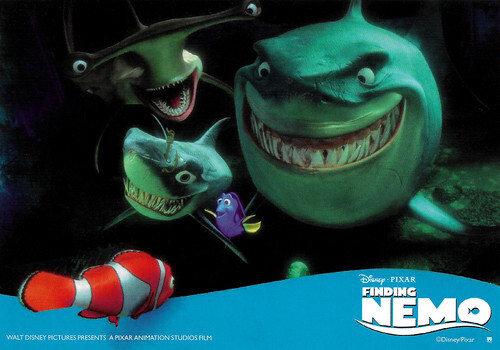
French postcard by Sonis, no. C. 1413, offered by Teisseire. Image: Disney / Pixar. Film Image of Finding Nemo (Andrew Stanton, Lee Unkrich, 2003).
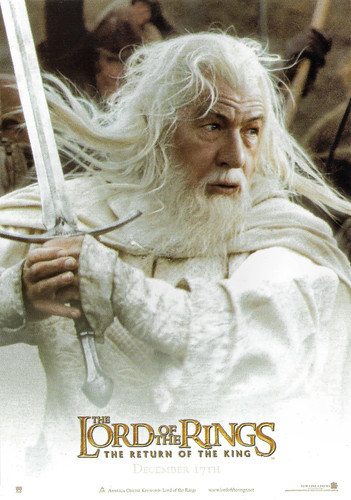
French postcard by Sonis, no. C. 1452. Photo: New Line Productions. Ian McKellen as Gandalf in The Lord of the Rings - The Return of the King (Peter Jackson, 2003).
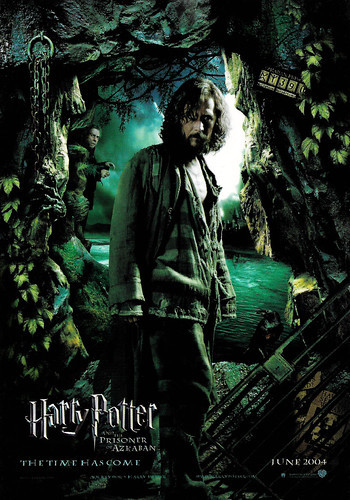
French postcard by Sonis, no. C. 1519. Photo: Warner Bros. Gary Oldman in Harry Potter and the Prisoner of Azkaban (Alfonso Cuarón, 2004). Caption: The time has come. June 2004.
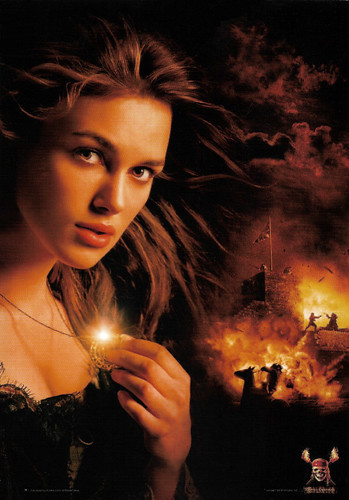
French postcard by Sonis, no. C. 1705. Photo: Disney. Keira Knightley in Pirates of the Caribbean - Dead Man's Chest (Gore Verbinski, 2006).
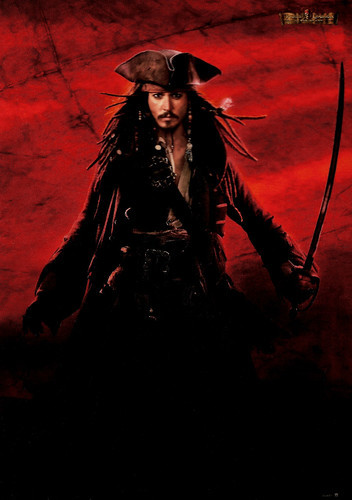
French postcard by Sonis, no. C. 1781. Photo: Disney. Johnny Depp as Jack Sparrow in Pirates of the Caribbean: Dead Man's Chest (Gore Verbinski, 2006).
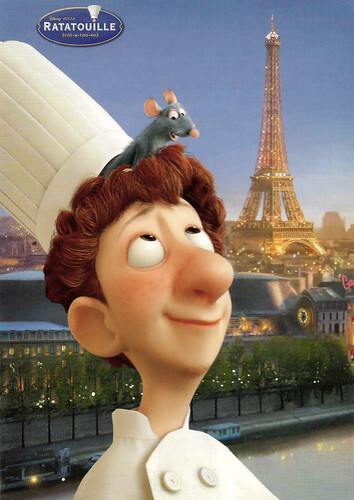
French postcard by Sonis, no. C. 1790. Image: Disney / Pixar. Film Image for Ratatouille (Brad Bird, Jan Pinkava, 2007).
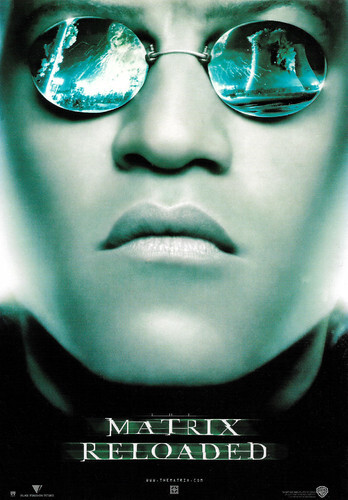
French postcard by Sonis, no. F 110. Photo: Warner Bros. Laurence Fishburne in The Matrix Reloaded (Lana Wachowski, Lilly Wachowski, 2003).
Source: Sonis (French).

French postcard by Sonis, no. C 62. Photo: Warner Bros inc. Michael Keaton and Kim Basinger in Batman (Tim Burton, 1989).

French postcard by Sonis, no. C. 109. Photo: Deal. Mickey Rourke and Carré Otis in Wild Orchid (Zalman King, 1989).

French postcard by Sonis, no. C. 129. Photo: Carolco International NV. Arnold Schwarzenegger in Total Recall (Paul Verhoeven, 1990).

French postcard by Sonis, no. C. 160. Photo: Christophe Lambert and Sean Connery in Highlander II: The Quickening (Russell Mulcahy, 1991).

French postcard by Sonis, no. C. 322. Photo: Columbia Pictures. Keanu Reeves , Michaela Bercu, Monica Bellucci, and Florina Kendrick in Dracula (Francis Coppola, 1992).

French postcard by Sonis, no. C. 492. Photo: Bac Films. Uma Thurman on the French poster for Pulp Fiction (Quentin Tarantino, 1994). Caption: Affiche du film.

French postcard by Sonis, no. C. 609. Photo: Danjaq and United Artists Corporation. Photo: Famke Jansen, Pierce Brosnan, and Isabella Scoruppo in Goldeneye (Martin Campbell, 1995).

French postcard by Sonis, no. C. 620. Image: Pixar / Disney / Hasbro / Mattel / James Industries. Film poster for Toy Story (John Lasseter, 1995).

French postcard by Sonis, no. C. 709. Photo: TM and Bad Bird Productions Inc., 1996. Brandon Lee in The Crow (Alex Proyas, 1994).

French postcard by Sonis, no. C. 854. Photo: United Artists. Gabriel Byrne, Leonardo DiCaprio , John Malkovich, Gérard Depardieu, and Jeremy Irons in The Man in the Iron Mask (Randall Wallace, 1998).

French postcard by Sonis, no. C 867. Photo: Miramax / A Band Apart / BAC Films. Bridget Fonda as Melanie Ralston in Jackie Brown (Quentin Tarantino, 1997). Caption: Christmas Day.

French postcard by Sonis, no. C. 899. Photo: Zorro Productions / Tristar Pictures. Antonio Banderas in The Mask of Zorro (Martin Campbell, 1998).

French postcard by Sonis, no. C. 941. Image: Disney / Pixar. Film image for A Bug's Life (John Lasseter, 1998). Sent by mail in 1999.

French postcard by Sonis, no. C. 1119. Image: Disney / Pixar. Film image for Toy Story 2 (John Lasseter, Lee Unkrich, Ash Brannon, 1999).

French postcard by Sonis, no. C. 1413, offered by Teisseire. Image: Disney / Pixar. Film Image of Finding Nemo (Andrew Stanton, Lee Unkrich, 2003).

French postcard by Sonis, no. C. 1452. Photo: New Line Productions. Ian McKellen as Gandalf in The Lord of the Rings - The Return of the King (Peter Jackson, 2003).

French postcard by Sonis, no. C. 1519. Photo: Warner Bros. Gary Oldman in Harry Potter and the Prisoner of Azkaban (Alfonso Cuarón, 2004). Caption: The time has come. June 2004.

French postcard by Sonis, no. C. 1705. Photo: Disney. Keira Knightley in Pirates of the Caribbean - Dead Man's Chest (Gore Verbinski, 2006).

French postcard by Sonis, no. C. 1781. Photo: Disney. Johnny Depp as Jack Sparrow in Pirates of the Caribbean: Dead Man's Chest (Gore Verbinski, 2006).

French postcard by Sonis, no. C. 1790. Image: Disney / Pixar. Film Image for Ratatouille (Brad Bird, Jan Pinkava, 2007).

French postcard by Sonis, no. F 110. Photo: Warner Bros. Laurence Fishburne in The Matrix Reloaded (Lana Wachowski, Lilly Wachowski, 2003).
Source: Sonis (French).
Published on February 12, 2022 22:00
February 11, 2022
Women who wear ties
A certain level of chutzpah is required of women who wear ties. When a woman is wearing a corporate-looking tie styled over a white shirt, the message is clear: this lady means business. She is strong! Marlene Dietrich used it as an expression of individuality. Diane Keaton's wardrobe in Annie Hall (1977), which consisted mainly of vintage men's clothing including neckties, started a new fashion trend. Later, Julia Roberts turned up to the Golden Globes wearing oversized men’s suiting and a floral banker’s tie. She picked up the prize for the best supporting actress, but her tie suggested she saw her worth as equal to that of any leading man. In the 1910s and early 1920s, many women in the film industry had their own studios, especially in Berlin, the capital of the European cinema. Their ties expressed the female power in the film industry of that era. Here are 21 postcards of these female film stars who wore ties.
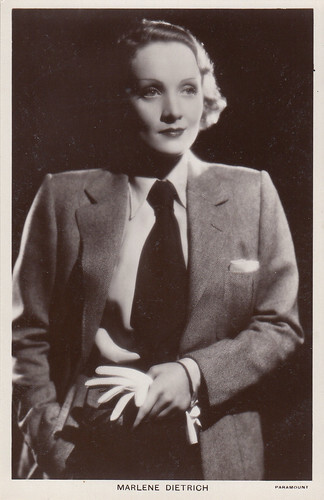
British postcard in the Picturegoer Series, no. 529a. Photo: Paramount. Collection: Marlene Pilaete.
Marlene Dietrich (1901-1992) was the first German actress who became successful in Hollywood. Throughout her long career, she constantly reinvented herself. In 1920s Berlin, she started as a cabaret singer, chorus girl, and film actress. In the 1930s, she became a Hollywood star, then a World War II frontline entertainer, and finally, she was an international stage show performer from the 1950s till the 1970s. Dietrich artfully projected cool sophistication, self-mockery, and infinite experience. Her sexuality was audacious, her wit was insolent and her manner was ageless.
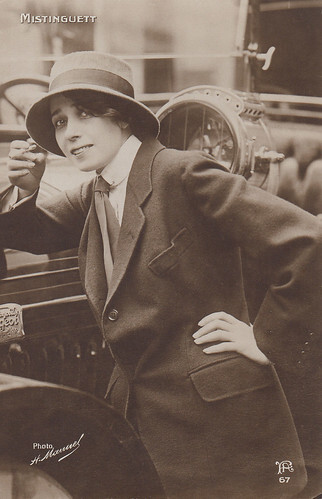
French postcard, no. 67. Photo: H. Manuel. Collection: Marlene Pilaete.
French actress and singer Mistinguett (1875-1956) captivated Paris with her risqué routines. She went on to become the most popular French entertainer of her time and the highest-paid female entertainer in the world. She appeared more than 60 times in the cinema.
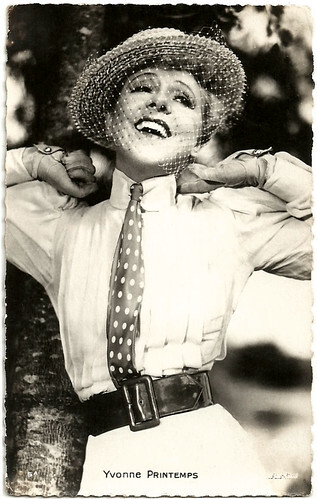
French postcard by Editions Chantal, Rueil, no. 5 A.
French singer and actress Yvonne Printemps (1894-1977) was a huge star of the European stage. She also appeared in ten international silent and sound films. A true diva, she loved the spotlight and would be seen draped with jewels, wearing enormous hats, and having her pet dogs on a leash.
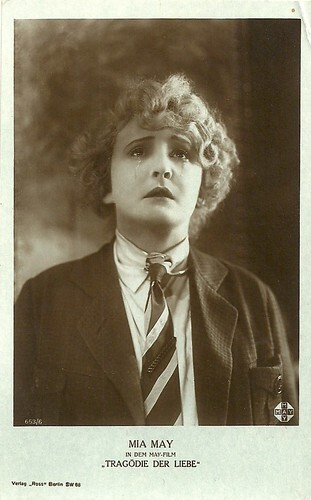
German postcard by Ross Verlag, no. 653/6. Photo: May-Film. Mia May in Tragödie der Liebe (Joe May, 1923).
Mia May (1884-1980) was one of the first divas of German cinema. She starred in many films of her husband, producer, writer, and director Joe May.
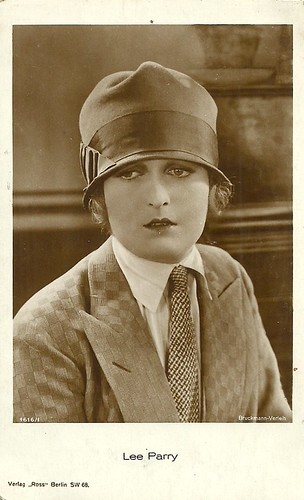
German postcard by Ross Verlag, no. 1616/1. Photo: Bruckmann-Verleih.
Lee Parry (1901-1977) was a glamorous German film actress of the silent and the early sound era. She often starred in films by her husband Richard Eichberg. She appeared in 48 films between 1919 and 1939.
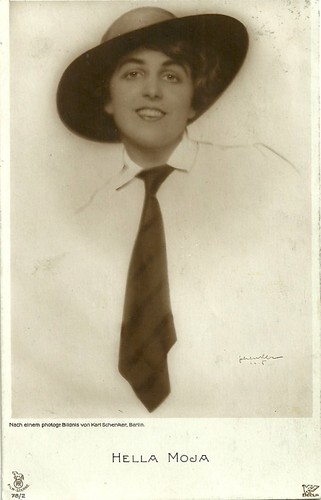
German postcard by Rotophot in the Film Sterne series, no. 78/2. Photo: Karl Schenker, Berlin / Decla Film.
During the First World War and the following years Hella Moja (1890-1951) was one of the most popular stars of the German silent cinema. There was even a Hella Moja serial and in 1918 she founded her own film company.
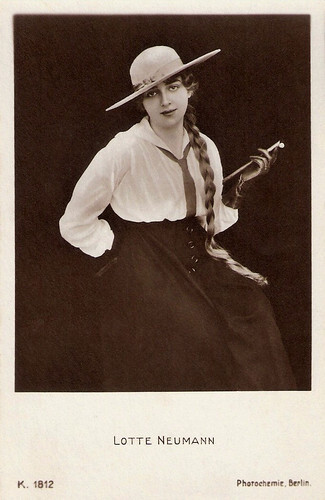
German postcard by Photochemie, Berlin, no. K. 1812.
Lotte Neumann (1896-1977) was one of the most successful actresses in the early days of German silent cinema. She also worked as a screenwriter and a producer.
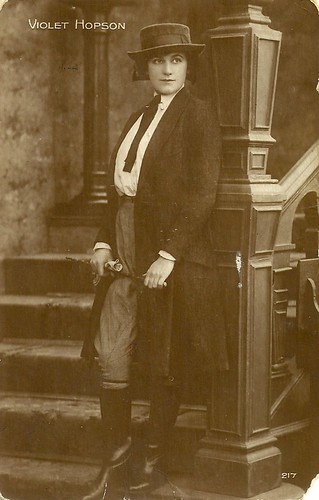
French postcard by Editions Cinémagazine, no. 217.
Australian-born actress and producer Violet Hopson (1887–1973) was one of the first British film stars. She appeared in more than 100 British silent films and occasionally played supporting roles in sound pictures of the early 1930s.

Austrian postcard by Iris Verlag, no. 6575. Photo: Max Munn Autrey / Fox. Collection: Marlene Pilaete.
Stunning Olive Borden (1906-1947) was considered one of the most beautiful actresses of the silent era. At 15, she started as a Mack Sennett bathing beauty and reached the peak of her career in 1926 when she made 11 films for Fox Studios and was earning $1,500 a week. She was nicknamed "the Joy Girl", after playing the lead in the 1927 film of that same title, but soon her career waned.
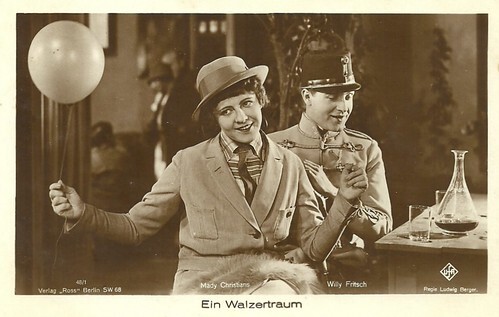
German postcard by Ross Verlag, no. 48/1. Mady Christians and Willy Fritsch in the Ufa-film Ein Walzertraum (Ludwig Berger, 1925).
Austrian-born stage actress Mady Christians (1892-1951) was a star of the German silent cinema and appeared in Austrian, French, British, and Hollywood films too.
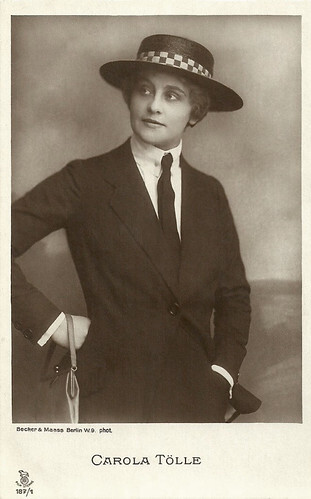
German postcard in the Film-Sterne series by Rotophot, no. 187/1. Photo: Becker & Maass, Berlin.
Carola Toelle (1893-1958) was a German actress, in particular in German silent cinema of the late 1910s and early 1920s.
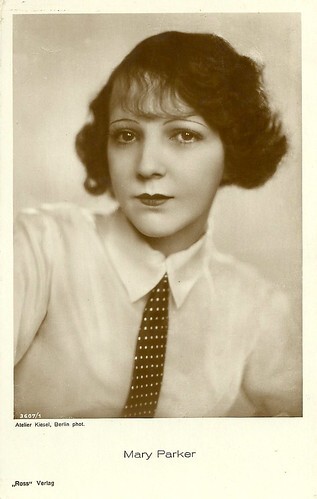
German postcard by Ross Verlag, no. 3607/1. Photo: Atelier Kiesel, Berlin.
Despite her English-sounding name, Mary Parker (1902-?) was a Polish actress who was active in the German cinema of the late silent era.
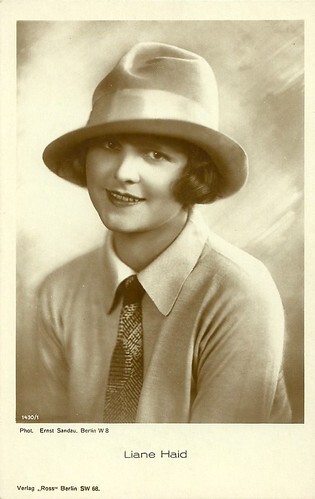
German postcard by Ross Verlag, no. 1430/1. Photo: Ernst Sandau, Berlin.
Prima ballerina, dancer, singer, and actress Liane Haid (1895-2000) was the first film star of Austria. She was the epitome of the Süßes Wiener Mädel (Sweet Viennese Girl), and from the mid-1910s on she made close to a hundred films.
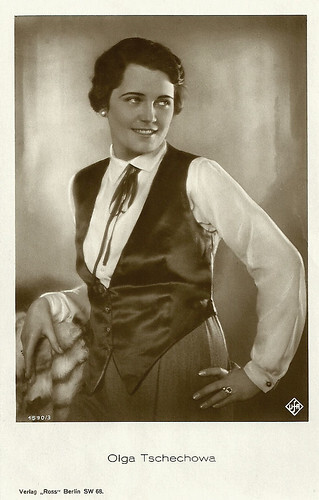
German postcard by Ross Verlag, no. 1590/3, 1927-1928. Photo: Ufa.
Dignified German-Russian actress Olga Tschechowa (1897-1980) was one of the most popular stars of the silent film era. She remained a mysterious person throughout her life.
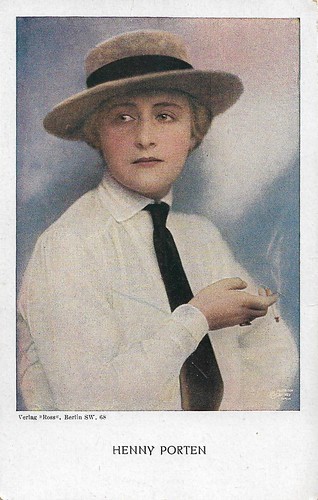
German postcard by Verlag Ross, Berlin. Photo: Messter Film, Berlin.
Sturdy and blond Henny Porten (1890-1960) was one of Germany's most important and popular film actresses of the silent cinema. She became the quintessence of German womanhood, ladylike yet kindhearted and a not a little petit bourgeois. She was also the producer of many of her own films.
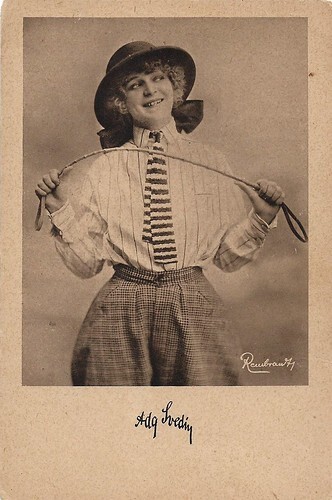
German postcard by an unknown editor. Photo: Rembrandt.
German actress Ada Svedin (1894-1975) starred in several silent film operettas, produced and directed by Ludwig Czerny, who also became her husband.
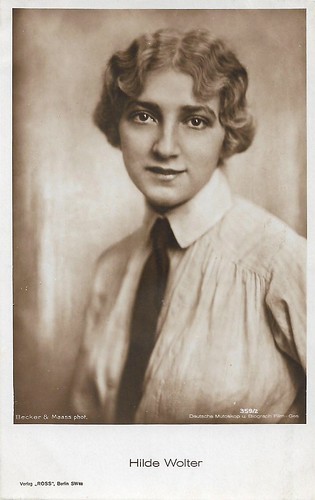
German postcard by Ross Verlag, Berlin, no. 359/2, 1919-1924. Photo: Becker & Maass, Berlin / Deutsche Mutoskop & Biograph.
Hilde Wolter (1898-1946) was a German silent film actress, active between 1918 and 1922/23.
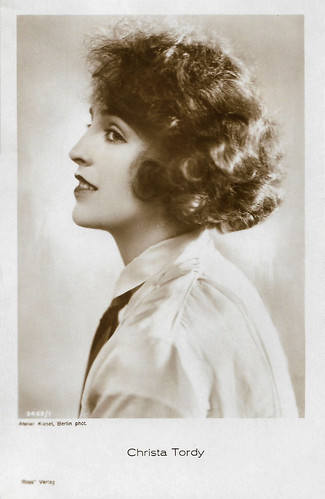
German postcard by Ross Verlag, no. 3462/1, 1928-1929. Photo: Kiesel, Berlin.
German film actress Christa Tordy (1904-1945) was discovered while visiting her cousin Mady Christians in Berlin. In the late 1920s, she briefly became a leading star of the German silent cinema before retiring after marrying Harry Liedtke. She was murdered along with her husband by the Soviet Red Army at her home during its invasion of Germany during World War II.
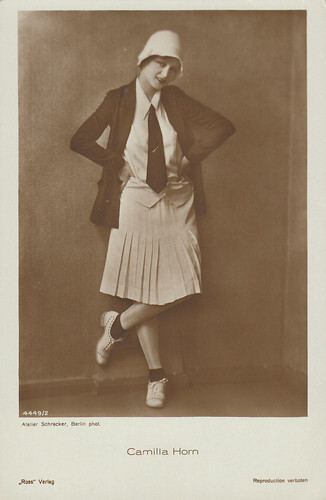
German postcard by Ross Verlag no. 4442/2, 1929-1930. Photo: Atelier Schrecker, Berlin. Collection: Marlene Pilaete.
Ethereally blonde Camilla Horn (1903-1996) was a German dancer and film star. Her breakthrough role was Gretchen in the silent film classic Faust (1926, Friedrich Wilhelm Murnau). She also starred in some Hollywood films of the late 1920s and in a few British and Italian productions.
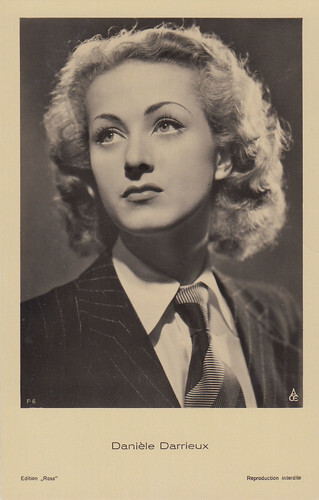
German postcard by Edition Ross, no. F6. Photo: ACE. Collection: Marlene Pilaete.
French actress and singer Danielle Darrieux (1917-2017) was an enduringly beautiful, international leading lady. From her film debut in 1931 on she progressed from playing pouty teens to worldly sophisticates. In the early 1950s, she starred in three classic films by Max Ophüls, and she played the mother of Catherine Deneuve in five films!
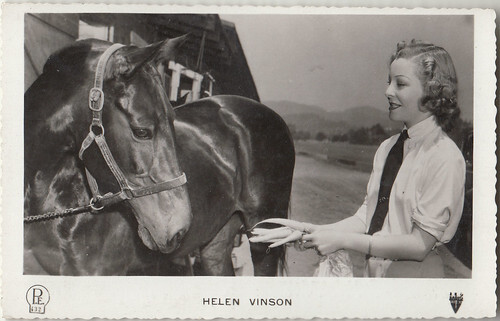
Belgian postcard by Photo Edition, no. 432. Collection: Marlene Pilaete.
American actress Helen Vinson (1907-1999) was a chic, elegant beauty with a tinge of a Southern drawl, who appeared in 40 films between 1932 and 1945. She specialised in the part of the other woman, often taking on the role of the cynical adulteress or the spiteful wife who does her best to prevent her husband's happiness with another woman.
Sources: Financial Times, Wikipedia, and .

British postcard in the Picturegoer Series, no. 529a. Photo: Paramount. Collection: Marlene Pilaete.
Marlene Dietrich (1901-1992) was the first German actress who became successful in Hollywood. Throughout her long career, she constantly reinvented herself. In 1920s Berlin, she started as a cabaret singer, chorus girl, and film actress. In the 1930s, she became a Hollywood star, then a World War II frontline entertainer, and finally, she was an international stage show performer from the 1950s till the 1970s. Dietrich artfully projected cool sophistication, self-mockery, and infinite experience. Her sexuality was audacious, her wit was insolent and her manner was ageless.

French postcard, no. 67. Photo: H. Manuel. Collection: Marlene Pilaete.
French actress and singer Mistinguett (1875-1956) captivated Paris with her risqué routines. She went on to become the most popular French entertainer of her time and the highest-paid female entertainer in the world. She appeared more than 60 times in the cinema.

French postcard by Editions Chantal, Rueil, no. 5 A.
French singer and actress Yvonne Printemps (1894-1977) was a huge star of the European stage. She also appeared in ten international silent and sound films. A true diva, she loved the spotlight and would be seen draped with jewels, wearing enormous hats, and having her pet dogs on a leash.

German postcard by Ross Verlag, no. 653/6. Photo: May-Film. Mia May in Tragödie der Liebe (Joe May, 1923).
Mia May (1884-1980) was one of the first divas of German cinema. She starred in many films of her husband, producer, writer, and director Joe May.

German postcard by Ross Verlag, no. 1616/1. Photo: Bruckmann-Verleih.
Lee Parry (1901-1977) was a glamorous German film actress of the silent and the early sound era. She often starred in films by her husband Richard Eichberg. She appeared in 48 films between 1919 and 1939.

German postcard by Rotophot in the Film Sterne series, no. 78/2. Photo: Karl Schenker, Berlin / Decla Film.
During the First World War and the following years Hella Moja (1890-1951) was one of the most popular stars of the German silent cinema. There was even a Hella Moja serial and in 1918 she founded her own film company.

German postcard by Photochemie, Berlin, no. K. 1812.
Lotte Neumann (1896-1977) was one of the most successful actresses in the early days of German silent cinema. She also worked as a screenwriter and a producer.

French postcard by Editions Cinémagazine, no. 217.
Australian-born actress and producer Violet Hopson (1887–1973) was one of the first British film stars. She appeared in more than 100 British silent films and occasionally played supporting roles in sound pictures of the early 1930s.

Austrian postcard by Iris Verlag, no. 6575. Photo: Max Munn Autrey / Fox. Collection: Marlene Pilaete.
Stunning Olive Borden (1906-1947) was considered one of the most beautiful actresses of the silent era. At 15, she started as a Mack Sennett bathing beauty and reached the peak of her career in 1926 when she made 11 films for Fox Studios and was earning $1,500 a week. She was nicknamed "the Joy Girl", after playing the lead in the 1927 film of that same title, but soon her career waned.

German postcard by Ross Verlag, no. 48/1. Mady Christians and Willy Fritsch in the Ufa-film Ein Walzertraum (Ludwig Berger, 1925).
Austrian-born stage actress Mady Christians (1892-1951) was a star of the German silent cinema and appeared in Austrian, French, British, and Hollywood films too.

German postcard in the Film-Sterne series by Rotophot, no. 187/1. Photo: Becker & Maass, Berlin.
Carola Toelle (1893-1958) was a German actress, in particular in German silent cinema of the late 1910s and early 1920s.

German postcard by Ross Verlag, no. 3607/1. Photo: Atelier Kiesel, Berlin.
Despite her English-sounding name, Mary Parker (1902-?) was a Polish actress who was active in the German cinema of the late silent era.

German postcard by Ross Verlag, no. 1430/1. Photo: Ernst Sandau, Berlin.
Prima ballerina, dancer, singer, and actress Liane Haid (1895-2000) was the first film star of Austria. She was the epitome of the Süßes Wiener Mädel (Sweet Viennese Girl), and from the mid-1910s on she made close to a hundred films.

German postcard by Ross Verlag, no. 1590/3, 1927-1928. Photo: Ufa.
Dignified German-Russian actress Olga Tschechowa (1897-1980) was one of the most popular stars of the silent film era. She remained a mysterious person throughout her life.

German postcard by Verlag Ross, Berlin. Photo: Messter Film, Berlin.
Sturdy and blond Henny Porten (1890-1960) was one of Germany's most important and popular film actresses of the silent cinema. She became the quintessence of German womanhood, ladylike yet kindhearted and a not a little petit bourgeois. She was also the producer of many of her own films.

German postcard by an unknown editor. Photo: Rembrandt.
German actress Ada Svedin (1894-1975) starred in several silent film operettas, produced and directed by Ludwig Czerny, who also became her husband.

German postcard by Ross Verlag, Berlin, no. 359/2, 1919-1924. Photo: Becker & Maass, Berlin / Deutsche Mutoskop & Biograph.
Hilde Wolter (1898-1946) was a German silent film actress, active between 1918 and 1922/23.

German postcard by Ross Verlag, no. 3462/1, 1928-1929. Photo: Kiesel, Berlin.
German film actress Christa Tordy (1904-1945) was discovered while visiting her cousin Mady Christians in Berlin. In the late 1920s, she briefly became a leading star of the German silent cinema before retiring after marrying Harry Liedtke. She was murdered along with her husband by the Soviet Red Army at her home during its invasion of Germany during World War II.

German postcard by Ross Verlag no. 4442/2, 1929-1930. Photo: Atelier Schrecker, Berlin. Collection: Marlene Pilaete.
Ethereally blonde Camilla Horn (1903-1996) was a German dancer and film star. Her breakthrough role was Gretchen in the silent film classic Faust (1926, Friedrich Wilhelm Murnau). She also starred in some Hollywood films of the late 1920s and in a few British and Italian productions.

German postcard by Edition Ross, no. F6. Photo: ACE. Collection: Marlene Pilaete.
French actress and singer Danielle Darrieux (1917-2017) was an enduringly beautiful, international leading lady. From her film debut in 1931 on she progressed from playing pouty teens to worldly sophisticates. In the early 1950s, she starred in three classic films by Max Ophüls, and she played the mother of Catherine Deneuve in five films!

Belgian postcard by Photo Edition, no. 432. Collection: Marlene Pilaete.
American actress Helen Vinson (1907-1999) was a chic, elegant beauty with a tinge of a Southern drawl, who appeared in 40 films between 1932 and 1945. She specialised in the part of the other woman, often taking on the role of the cynical adulteress or the spiteful wife who does her best to prevent her husband's happiness with another woman.
Sources: Financial Times, Wikipedia, and .
Published on February 11, 2022 22:00
February 10, 2022
Lewis Stone
American film actor Lewis Stone (1879–1953) is best known for his role as Judge James Hardy in the Andy Hardy film series and as an MGM studio contract player. In 1929, he was nominated for the Academy Award for Best Actor for Ernst Lubitsch's lost film The Patriot (1928). With his distinguished look and grey hair, Stone was able to play the roles of well-mannered romantic men, and he appeared in seven films with Greta Garbo.
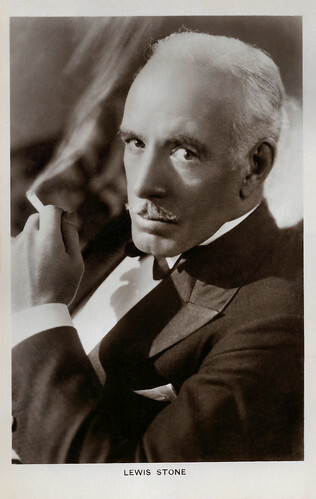
British postcard in the Picturegoer Series, London, no. 27b.
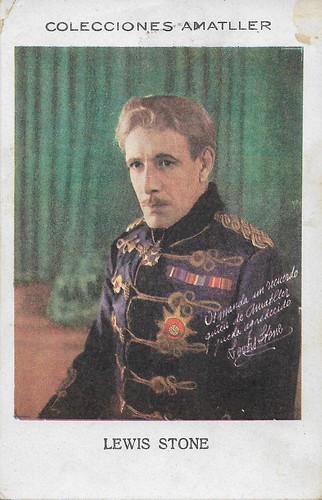
Spanish collectors card by Chocolate Amatller, Series EE, artist 41, no. 83. Lewis Stone In The Prisoner of Zenda (Rex Ingram, 1922).
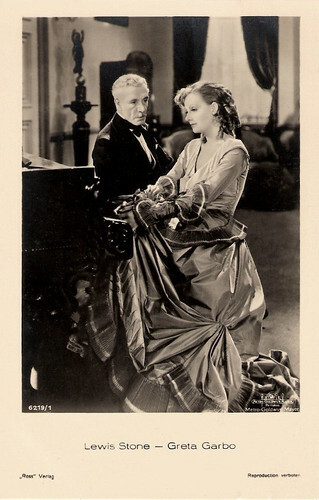
German postcard by Ross Verlag, no. 6219/1, 1931-1932. Photo: Metro-Goldwyn-Mayer (MGM). Greta Garbo and Lewis Stone in Romance (Clarence Brown, 1930).
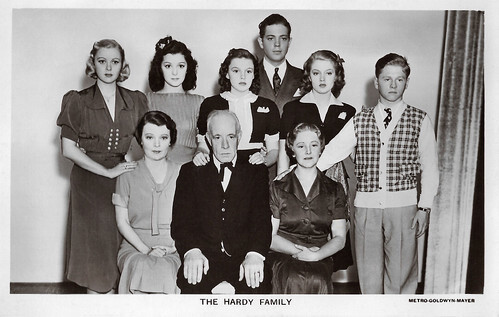
British postcard in the Picturegoer Series, London, no. 1280. Photo: Metro-Goldwyn-Mayer. Publicity still for Love Finds Andy Hardy (George B. Seitz, 1938) with (back row) Cecilia Parker, Ann Rutherford, Judy Garland , Gene Reynolds, Lana Turner, and (front row) Mary Howard, Lewis Stone, Fay Holden, and Mickey Rooney .
Two elegant and popular Swashbucklers
Lewis Shepard Stone was born in Worcester, Massachusetts, in 1879, to Bertrand Stone and Philena Heald Ball.
Reportedly, by age 20, Lewis's hair had turned gray prematurely. He served in the United States Army in the Spanish–American War as a lieutenant, then returned to a career as a writer.
He soon began acting. In 1912, he found success in the popular play 'Bird of Paradise' which starred Laurette Taylor. The play was later filmed in 1932 and 1951. Stone's career was interrupted by World War I where he served again in the United States Army in the cavalry as a major.
After the war, he went to China to train troops. After returning from China, he made his feature film debut either in The Man Who Found Out (Unkown director, 1915), according to IMDb or in Honor's Altar (Walter Edwards, 1916), according to Wikipedia .
Stone showed up in First National's Nomads of the North (David Hartford, 1920) as a Royal Canadian Mounted Policeman opposite Lon Chaney . He portrayed the title role in the silent film version of The Prisoner of Zenda (Rex Ingram, 1922) with Alice Terry and Ramon Novarro .
The three stars reunited for another elegant and popular Swashbuckler, Scaramouche (Rex Ingram, 1923). In 1924, Stone joined the newly-formed Metro-Goldwyn-Mayer where he remained for the rest of his career.
The next years, he was busy. He played an adventurer opposite Wallace Beery in the dinosaur epic The Lost World (Harry O'Hoyt, 1925), adapted from Arthur Conan Doyle's 1912 novel of the same name. The film featured pioneering stop motion special effects by Willis O'Brien, a forerunner of his work on the original King Kong.
Stone was nominated for the Academy Award for Best Actor in 1929 for The Patriot (Ernst Lubitsch, 1928). He played the character that gives the film its title, but he was not the top-billed star. That was Emil Jannings who starred as Emperor Paul I of Russia.
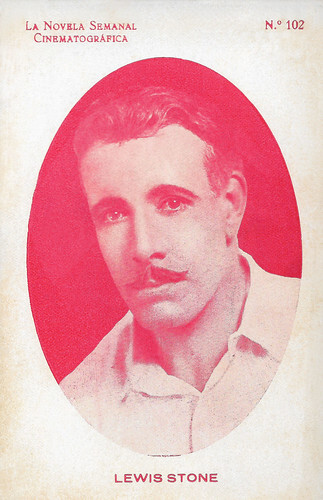
Spanish card by La Novela Semanal Cinematográfica, no. 102.

German postcard by Ross Verlag, Berlin, no. 679/2. Photo: Bafag. Alice Terry as Princess Flavia and Lewis Stone as King Rudolf in The Prisoner of Zenda (Rex Ingram, 1922).

German postcard by Ross Verlag, no. 679/4. Lewis Stone as Rudolph Rassendyll and Alice Terry as Princess Flavia in The Prisoner of Zenda (Rex Ingram, 1922). The Bismarck-like guy behind Terry is the actor Robert Edeson, who plays Colonel Sapt. Behind him is actor Malcolm McGregor, who plays Captain Fritz von Tarlenheim. Both are the loyal aids of the King, defending him against his evil half-brother Michael (Stuart Holmes, who might be the man in black on the right) and his plotting cronies: his mistress Antoinette (Barbara la Marr) and Rupert von Hentzau ( Ramon Novarro ). Trying to stop a coup by Michael, who has abducted and imprisoned the real king, Sapt and Tarlenheim arrange a lookalike cousin of the king to be crowned (which we see on this card). The substitute king falls in love with Princess Flavia but he cannot tell the truth... Stone played both the King and his lookalike.
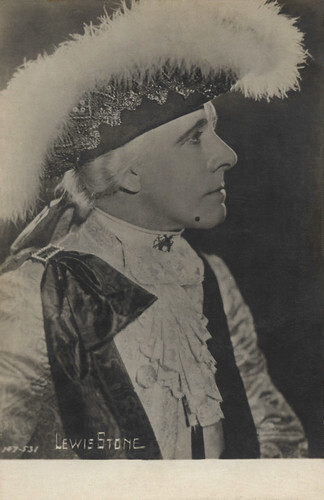
French postcard. Lewis Stone in Scaramouche (Rex Ingram, 1923).
Grand Hotel. People coming. Going. Nothing ever happens
Lewis Stone made the transition from silent to sound with The Trial of Mary Dugan (Bayard Veiller, 1929), which starred Norma Shearer . The sound film did not cause Lewis any problems and his appearance in the successful prison film The Big House (George Hill, 1930) furthered his career.
He continued to be busy with his roles as the distinguished lead and appeared in seven films with Greta Garbo , spanning both the silent and early sound periods. He played the role of Dr. Otternschlag in Grand Hotel (Edmund Goulding, 1932), in which he utters the famous closing line: "Grand Hotel. People coming. Going. Nothing ever happens."
The following year, he had a larger role in Queen Christina (Rouben Mamoulian, 1933). Stone also played an adventurer in The Mask of Fu Manchu (Charles Brabin, 1932) with Boris Karloff and a police captain in Bureau of Missing Persons (Roy Del Ruth, 1933) with Bette Davis .
In 1937, Stone essayed the role which would become his most famous, that of Judge James Hardy in the Andy Hardy series. Stone appeared as the judge in fourteen of the sixteen Andy Hardy features, beginning with You're Only Young Once (George B. Seitz, 1937).
Tony Fontana at IMDb : "Judge Hardy was the father audiences wanted in the late 30s early 40s. He was kind, intellectual, fair and as patient as he had to be with Andy, played by Mickey Rooney . This series occupied most of his screen time until it ended and he did slow down during the late 40s."
Stone also appeared in the short Andy Hardy's Dilemma, which promoted charitable donations to the Community Chest, but he had died by the time of the final Hardy feature, Andy Hardy Comes Home (Howard W. Koch, 1958).
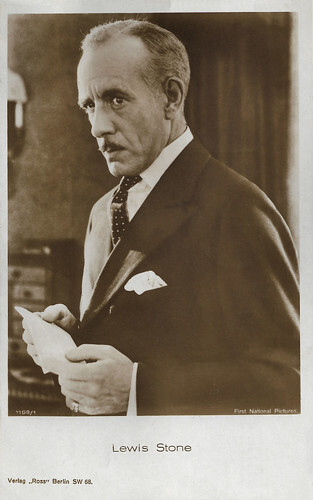
German postcard by Ross Verlag, Berlin, no. 1168/1, 1927-1928. Photo: First National Pictures.
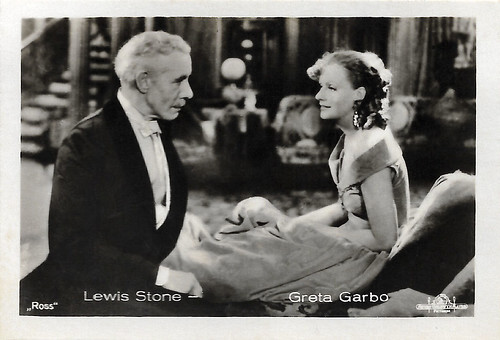
German collectors card by Ross Verlag for Filmalbum 4 'Aus Tönenden Filmen', Serie 4, no. 637, by A. Batschari Cigarettenfabrik, Baden-Baden. Photo: Metro-Goldwyn-Mayer. Greta Garbo and Lewis Stone in Romance (Clarence Brown, 1930).
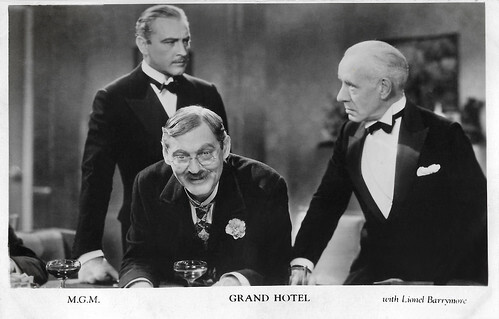
British postcard by Film Weekly. Photo: M.G.M. Lionel Barrymore , Lewis Stone, and John Barrymore in Grand Hotel (Edmund Goulding, 1932).
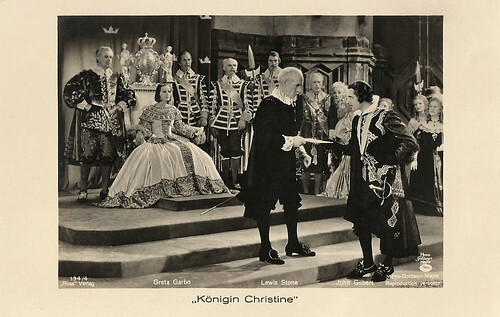
German postcard by Ross Verlag, no. 194/4. Photo: Metro-Goldwyn-Mayer. Greta Garbo , Lewis Stone and John Gilbert in Queen Christina (Rouben Mamoulian, 1933).
A heart attack while chasing away some neighborhood kids
During World War II, Lewis Stone was a lieutenant colonel in the California National Guard. Stone was MGM's longest-contracted actor and the longest-ever-contracted actor at a studio up to his death.
In the 1950s he continued to appear in a number of films including remakes of the two Swashbucklers he had made 30 years before with Alice Terry : Scaramouche (George Sidney, 1952), and The Prisoner of Zenda (Richard Thorpe, 1952), both starring Stewart Granger .
The week before his death, he (together with Lionel Barrymore ) received a gold key to his dressing room. He had made approximately 100 films.
Lewis Stone died in Hancock Park, Los Angeles in 1953, aged 73. He reportedly suffered a heart attack while chasing away some neighborhood kids who were throwing rocks at his garage.
Another published report states that on that date Stone and his third wife were watching television when they heard a racket in the backyard. When he investigated, Stone found lawn furniture once again floating in the pool and glimpsed three or perhaps four teenage boys running towards the street. Stone gave chase despite his wife's warning not to exert himself. Upon reaching the sidewalk, Stone suddenly collapsed. A gardener, Juan Vergara, witnessed the chase and summoned aid.
A photo published in newspapers of the day showed Stone lying on the sidewalk immediately after the incident. Following his death, he was interred at Angelus Rosedale Cemetery in Los Angeles, California. He was married three times. His wives were Florence Oakley, Margaret Langham, and Hazel Elizabeth Wolf. With Oakley, he had two children. Lewis Stone was later honored with a star on the Hollywood Walk of Fame at 6524 Hollywood Blvd.
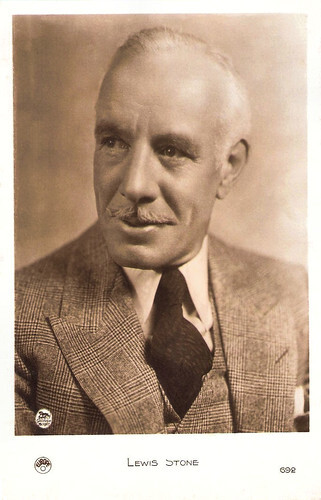
French postcard by Europe, no. 692. Photo: Metro-Goldwyn-Mayer.
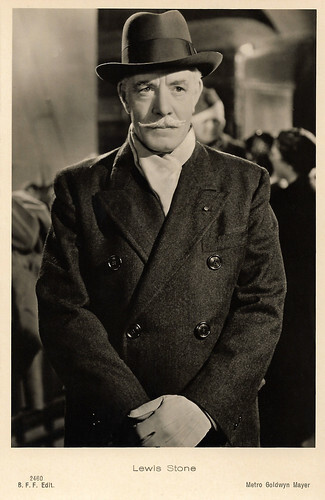
Italian postcard by B.F.F. Edit. (Casa Editr. Ballerini & Fratini, Firenze), no. 2460. Photo: Metro-Goldwyn-Mayer.
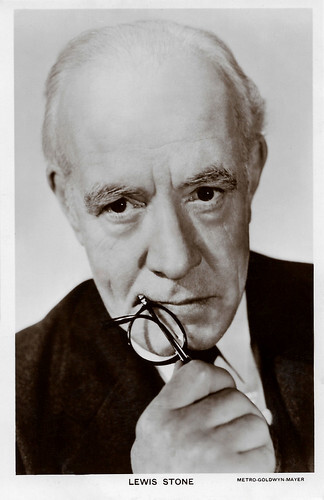
British postcard in the Picturegoer Series, London, no. 1346. Photo: Metro-Goldwyn-Mayer.
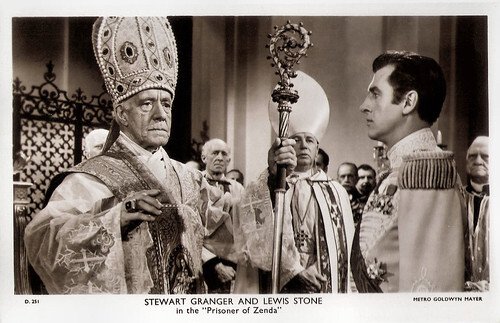
British postcard in the Picturegoer Series, London, no. D. 251. Photo: Metro-Goldwyn-Mayer. Stewart Granger and Lewis Stone (left) in The Prisoner of Zenda (Richard Thorpe, 1952).
Sources: (IMDb), Wikipedia, and .

British postcard in the Picturegoer Series, London, no. 27b.

Spanish collectors card by Chocolate Amatller, Series EE, artist 41, no. 83. Lewis Stone In The Prisoner of Zenda (Rex Ingram, 1922).

German postcard by Ross Verlag, no. 6219/1, 1931-1932. Photo: Metro-Goldwyn-Mayer (MGM). Greta Garbo and Lewis Stone in Romance (Clarence Brown, 1930).

British postcard in the Picturegoer Series, London, no. 1280. Photo: Metro-Goldwyn-Mayer. Publicity still for Love Finds Andy Hardy (George B. Seitz, 1938) with (back row) Cecilia Parker, Ann Rutherford, Judy Garland , Gene Reynolds, Lana Turner, and (front row) Mary Howard, Lewis Stone, Fay Holden, and Mickey Rooney .
Two elegant and popular Swashbucklers
Lewis Shepard Stone was born in Worcester, Massachusetts, in 1879, to Bertrand Stone and Philena Heald Ball.
Reportedly, by age 20, Lewis's hair had turned gray prematurely. He served in the United States Army in the Spanish–American War as a lieutenant, then returned to a career as a writer.
He soon began acting. In 1912, he found success in the popular play 'Bird of Paradise' which starred Laurette Taylor. The play was later filmed in 1932 and 1951. Stone's career was interrupted by World War I where he served again in the United States Army in the cavalry as a major.
After the war, he went to China to train troops. After returning from China, he made his feature film debut either in The Man Who Found Out (Unkown director, 1915), according to IMDb or in Honor's Altar (Walter Edwards, 1916), according to Wikipedia .
Stone showed up in First National's Nomads of the North (David Hartford, 1920) as a Royal Canadian Mounted Policeman opposite Lon Chaney . He portrayed the title role in the silent film version of The Prisoner of Zenda (Rex Ingram, 1922) with Alice Terry and Ramon Novarro .
The three stars reunited for another elegant and popular Swashbuckler, Scaramouche (Rex Ingram, 1923). In 1924, Stone joined the newly-formed Metro-Goldwyn-Mayer where he remained for the rest of his career.
The next years, he was busy. He played an adventurer opposite Wallace Beery in the dinosaur epic The Lost World (Harry O'Hoyt, 1925), adapted from Arthur Conan Doyle's 1912 novel of the same name. The film featured pioneering stop motion special effects by Willis O'Brien, a forerunner of his work on the original King Kong.
Stone was nominated for the Academy Award for Best Actor in 1929 for The Patriot (Ernst Lubitsch, 1928). He played the character that gives the film its title, but he was not the top-billed star. That was Emil Jannings who starred as Emperor Paul I of Russia.

Spanish card by La Novela Semanal Cinematográfica, no. 102.

German postcard by Ross Verlag, Berlin, no. 679/2. Photo: Bafag. Alice Terry as Princess Flavia and Lewis Stone as King Rudolf in The Prisoner of Zenda (Rex Ingram, 1922).

German postcard by Ross Verlag, no. 679/4. Lewis Stone as Rudolph Rassendyll and Alice Terry as Princess Flavia in The Prisoner of Zenda (Rex Ingram, 1922). The Bismarck-like guy behind Terry is the actor Robert Edeson, who plays Colonel Sapt. Behind him is actor Malcolm McGregor, who plays Captain Fritz von Tarlenheim. Both are the loyal aids of the King, defending him against his evil half-brother Michael (Stuart Holmes, who might be the man in black on the right) and his plotting cronies: his mistress Antoinette (Barbara la Marr) and Rupert von Hentzau ( Ramon Novarro ). Trying to stop a coup by Michael, who has abducted and imprisoned the real king, Sapt and Tarlenheim arrange a lookalike cousin of the king to be crowned (which we see on this card). The substitute king falls in love with Princess Flavia but he cannot tell the truth... Stone played both the King and his lookalike.

French postcard. Lewis Stone in Scaramouche (Rex Ingram, 1923).
Grand Hotel. People coming. Going. Nothing ever happens
Lewis Stone made the transition from silent to sound with The Trial of Mary Dugan (Bayard Veiller, 1929), which starred Norma Shearer . The sound film did not cause Lewis any problems and his appearance in the successful prison film The Big House (George Hill, 1930) furthered his career.
He continued to be busy with his roles as the distinguished lead and appeared in seven films with Greta Garbo , spanning both the silent and early sound periods. He played the role of Dr. Otternschlag in Grand Hotel (Edmund Goulding, 1932), in which he utters the famous closing line: "Grand Hotel. People coming. Going. Nothing ever happens."
The following year, he had a larger role in Queen Christina (Rouben Mamoulian, 1933). Stone also played an adventurer in The Mask of Fu Manchu (Charles Brabin, 1932) with Boris Karloff and a police captain in Bureau of Missing Persons (Roy Del Ruth, 1933) with Bette Davis .
In 1937, Stone essayed the role which would become his most famous, that of Judge James Hardy in the Andy Hardy series. Stone appeared as the judge in fourteen of the sixteen Andy Hardy features, beginning with You're Only Young Once (George B. Seitz, 1937).
Tony Fontana at IMDb : "Judge Hardy was the father audiences wanted in the late 30s early 40s. He was kind, intellectual, fair and as patient as he had to be with Andy, played by Mickey Rooney . This series occupied most of his screen time until it ended and he did slow down during the late 40s."
Stone also appeared in the short Andy Hardy's Dilemma, which promoted charitable donations to the Community Chest, but he had died by the time of the final Hardy feature, Andy Hardy Comes Home (Howard W. Koch, 1958).

German postcard by Ross Verlag, Berlin, no. 1168/1, 1927-1928. Photo: First National Pictures.

German collectors card by Ross Verlag for Filmalbum 4 'Aus Tönenden Filmen', Serie 4, no. 637, by A. Batschari Cigarettenfabrik, Baden-Baden. Photo: Metro-Goldwyn-Mayer. Greta Garbo and Lewis Stone in Romance (Clarence Brown, 1930).

British postcard by Film Weekly. Photo: M.G.M. Lionel Barrymore , Lewis Stone, and John Barrymore in Grand Hotel (Edmund Goulding, 1932).

German postcard by Ross Verlag, no. 194/4. Photo: Metro-Goldwyn-Mayer. Greta Garbo , Lewis Stone and John Gilbert in Queen Christina (Rouben Mamoulian, 1933).
A heart attack while chasing away some neighborhood kids
During World War II, Lewis Stone was a lieutenant colonel in the California National Guard. Stone was MGM's longest-contracted actor and the longest-ever-contracted actor at a studio up to his death.
In the 1950s he continued to appear in a number of films including remakes of the two Swashbucklers he had made 30 years before with Alice Terry : Scaramouche (George Sidney, 1952), and The Prisoner of Zenda (Richard Thorpe, 1952), both starring Stewart Granger .
The week before his death, he (together with Lionel Barrymore ) received a gold key to his dressing room. He had made approximately 100 films.
Lewis Stone died in Hancock Park, Los Angeles in 1953, aged 73. He reportedly suffered a heart attack while chasing away some neighborhood kids who were throwing rocks at his garage.
Another published report states that on that date Stone and his third wife were watching television when they heard a racket in the backyard. When he investigated, Stone found lawn furniture once again floating in the pool and glimpsed three or perhaps four teenage boys running towards the street. Stone gave chase despite his wife's warning not to exert himself. Upon reaching the sidewalk, Stone suddenly collapsed. A gardener, Juan Vergara, witnessed the chase and summoned aid.
A photo published in newspapers of the day showed Stone lying on the sidewalk immediately after the incident. Following his death, he was interred at Angelus Rosedale Cemetery in Los Angeles, California. He was married three times. His wives were Florence Oakley, Margaret Langham, and Hazel Elizabeth Wolf. With Oakley, he had two children. Lewis Stone was later honored with a star on the Hollywood Walk of Fame at 6524 Hollywood Blvd.

French postcard by Europe, no. 692. Photo: Metro-Goldwyn-Mayer.

Italian postcard by B.F.F. Edit. (Casa Editr. Ballerini & Fratini, Firenze), no. 2460. Photo: Metro-Goldwyn-Mayer.

British postcard in the Picturegoer Series, London, no. 1346. Photo: Metro-Goldwyn-Mayer.

British postcard in the Picturegoer Series, London, no. D. 251. Photo: Metro-Goldwyn-Mayer. Stewart Granger and Lewis Stone (left) in The Prisoner of Zenda (Richard Thorpe, 1952).
Sources: (IMDb), Wikipedia, and .
Published on February 10, 2022 22:00
February 9, 2022
A guardia di Sua Maestà (1916)
Hesperia (1885-1959), was one of the greatest divas of the Italian silent screen. She often worked with director Baldassarre Negroni, who later became her husband. An example is the Italian silent drama A guardia di Sua Maestà/On His Majesty's Guard (Baldassarre Negroni, 1916), produced by Milano Films. Ivo Blom found a series of six Spanish vintage collectors cards of the film. The Spanish film title was A la guardia de su majestad.
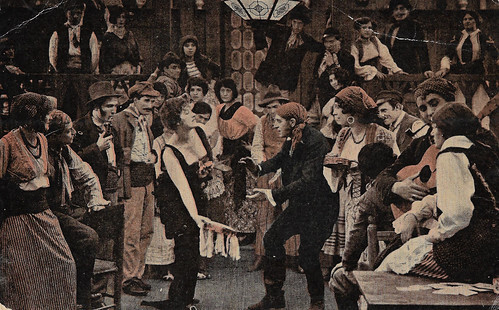
Spanish collectors card by Edics. y Publics. de Arte L. Planas, Barcelona, no. 3 of 6 cards. Caption: With compliments by Palace Cine, Barcelona. Photo: Milano Films. Hesperia in A guardia di Sua Maestà (Baldassarre Negroni, 1916).
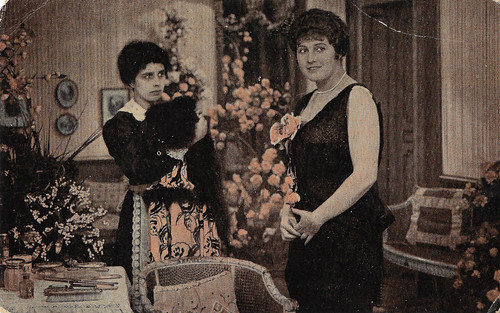
Spanish collectors card by Edics. y Publics. de Arte L. Planas, Barcelona, no. 2 of 6 cards. Caption: With compliments by Palace Cine, Barcelona. Photo: Milano Films. Hesperia in A guardia di Sua Maestà (Baldassarre Negroni, 1916).
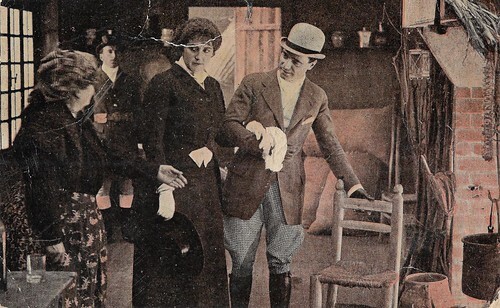
Spanish collectors card by Edics. y Publics. de Arte L. Planas, Barcelona, no. 3 of 6 cards. Caption: With compliments by Palace Cine, Barcelona. Photo: Milano Films. Hesperia and Attilio de Virgiliis in A guardia di Sua Maestà (Baldassarre Negroni, 1916).
Ruritania-like kingdoms where spies are galore
Young Prince Carlo of Vesnia (Attilio De Virgiliis) is hopelessly in love with an attractive courtesan, named 'Hesperia', but in fact, she is a spy recruited by the Lord Chancellor of Birmania in order to steal precious documents. The woman succeeds but her soul doesn't remain insensible to the ardent passion and thus repentance is created and eventually expiation.
The film was already produced in 1914/15 but for censorship reasons, its release was delayed. Indeed, the censor ordered to cut the whole scene called 'the Last Battle', which showed dead and wounded on the battlefield.
A guardia di Sua Maestà was one of the many dramas set in Ruritania-like kingdoms, where spies are galore and the loss of delicate documents causes awkward situations. Think of Ma l'amor mio non muore (1913) with Lyda Borelli , or L'amazzone mascherata (1914) with Francesca Bertini .
The Italian press, therefore, thought the script average but praised the acting of young De Virgiliis. The film premiered in Rome on 3 April 1916. In addition to De Virgiliis and Hesperia also Ignazio Lupi played in the film, but he isn't visible on the cards.
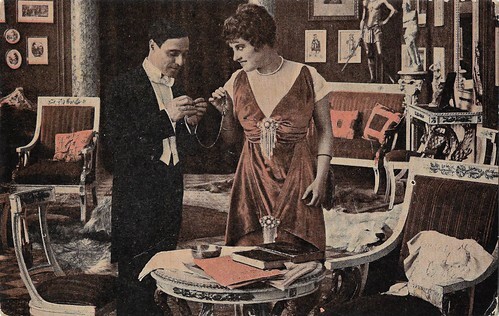
Spanish collectors card by Edics. y Publics. de Arte L. Planas, Barcelona, no. 4 of 6 cards. Caption: With compliments by Palace Cine, Barcelona. Photo: Milano Films. Hesperia and Attilio de Virgiliis in A guardia di Sua Maestà (Baldassarre Negroni, 1916).
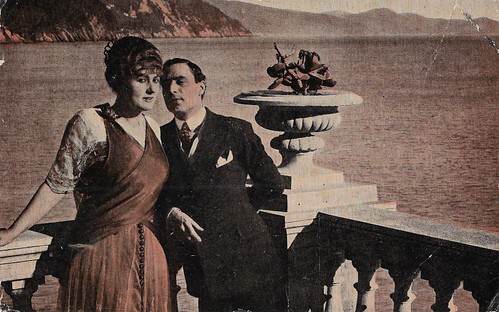
Spanish collectors card by Edics. y Publics. de Arte L. Planas, Barcelona, no. 5 of 6 cards. Caption: With compliments by Palace Cine, Barcelona. Photo: Milano Films. Hesperia and Attilio de Virgiliis in A guardia di Sua Maestà (Baldassarre Negroni, 1916).
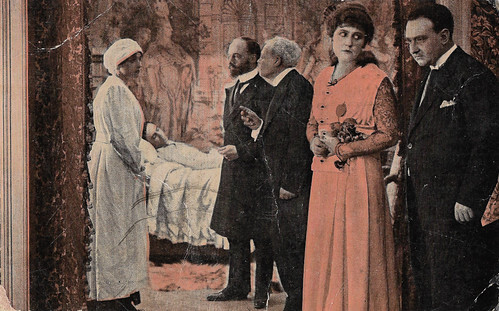
Spanish collectors card by Edics. y Publics. de Arte L. Planas, Barcelona, no. 6 of 6 cards. Caption: With compliments by Palace Cine, Barcelona. Photo: Milano Films. Hesperia , and in bed Attilio de Virgiliis, in A guardia di Sua Maestà (Baldassarre Negroni, 1916).
Sources: Vittorio Martinelli (Il cinema muto italiano, 1916, I), Wikipedia (Italian), and IMDb.

Spanish collectors card by Edics. y Publics. de Arte L. Planas, Barcelona, no. 3 of 6 cards. Caption: With compliments by Palace Cine, Barcelona. Photo: Milano Films. Hesperia in A guardia di Sua Maestà (Baldassarre Negroni, 1916).

Spanish collectors card by Edics. y Publics. de Arte L. Planas, Barcelona, no. 2 of 6 cards. Caption: With compliments by Palace Cine, Barcelona. Photo: Milano Films. Hesperia in A guardia di Sua Maestà (Baldassarre Negroni, 1916).

Spanish collectors card by Edics. y Publics. de Arte L. Planas, Barcelona, no. 3 of 6 cards. Caption: With compliments by Palace Cine, Barcelona. Photo: Milano Films. Hesperia and Attilio de Virgiliis in A guardia di Sua Maestà (Baldassarre Negroni, 1916).
Ruritania-like kingdoms where spies are galore
Young Prince Carlo of Vesnia (Attilio De Virgiliis) is hopelessly in love with an attractive courtesan, named 'Hesperia', but in fact, she is a spy recruited by the Lord Chancellor of Birmania in order to steal precious documents. The woman succeeds but her soul doesn't remain insensible to the ardent passion and thus repentance is created and eventually expiation.
The film was already produced in 1914/15 but for censorship reasons, its release was delayed. Indeed, the censor ordered to cut the whole scene called 'the Last Battle', which showed dead and wounded on the battlefield.
A guardia di Sua Maestà was one of the many dramas set in Ruritania-like kingdoms, where spies are galore and the loss of delicate documents causes awkward situations. Think of Ma l'amor mio non muore (1913) with Lyda Borelli , or L'amazzone mascherata (1914) with Francesca Bertini .
The Italian press, therefore, thought the script average but praised the acting of young De Virgiliis. The film premiered in Rome on 3 April 1916. In addition to De Virgiliis and Hesperia also Ignazio Lupi played in the film, but he isn't visible on the cards.

Spanish collectors card by Edics. y Publics. de Arte L. Planas, Barcelona, no. 4 of 6 cards. Caption: With compliments by Palace Cine, Barcelona. Photo: Milano Films. Hesperia and Attilio de Virgiliis in A guardia di Sua Maestà (Baldassarre Negroni, 1916).

Spanish collectors card by Edics. y Publics. de Arte L. Planas, Barcelona, no. 5 of 6 cards. Caption: With compliments by Palace Cine, Barcelona. Photo: Milano Films. Hesperia and Attilio de Virgiliis in A guardia di Sua Maestà (Baldassarre Negroni, 1916).

Spanish collectors card by Edics. y Publics. de Arte L. Planas, Barcelona, no. 6 of 6 cards. Caption: With compliments by Palace Cine, Barcelona. Photo: Milano Films. Hesperia , and in bed Attilio de Virgiliis, in A guardia di Sua Maestà (Baldassarre Negroni, 1916).
Sources: Vittorio Martinelli (Il cinema muto italiano, 1916, I), Wikipedia (Italian), and IMDb.
Published on February 09, 2022 22:00
Paul van Yperen's Blog
- Paul van Yperen's profile
- 13 followers
Paul van Yperen isn't a Goodreads Author
(yet),
but they
do have a blog,
so here are some recent posts imported from
their feed.



